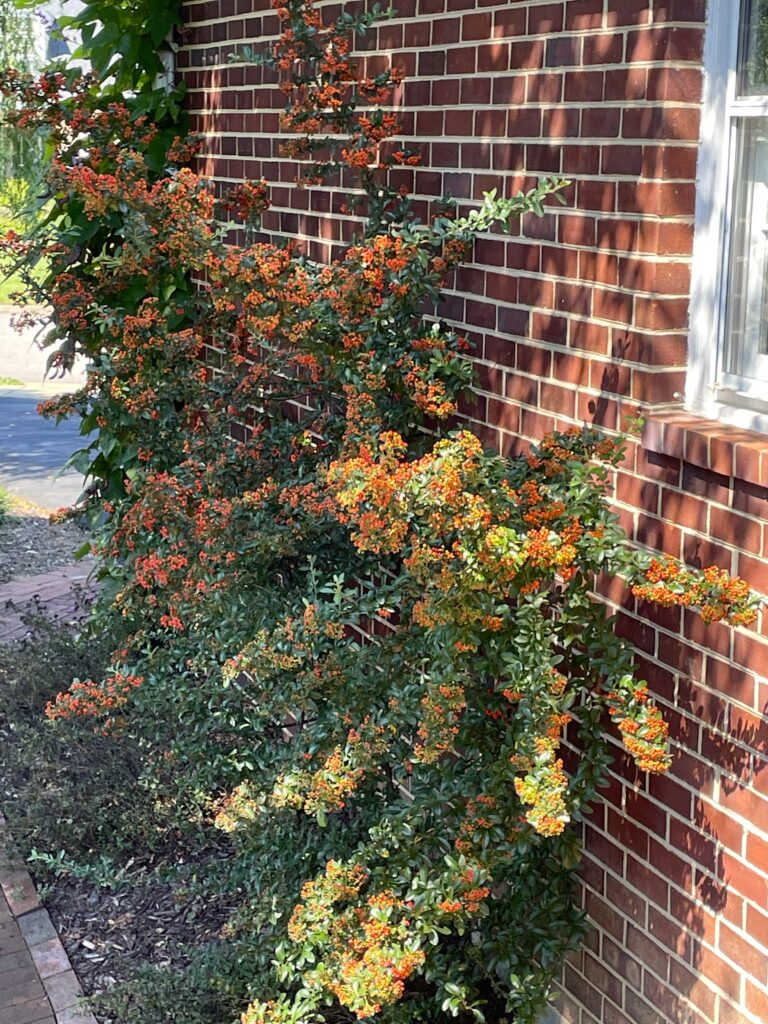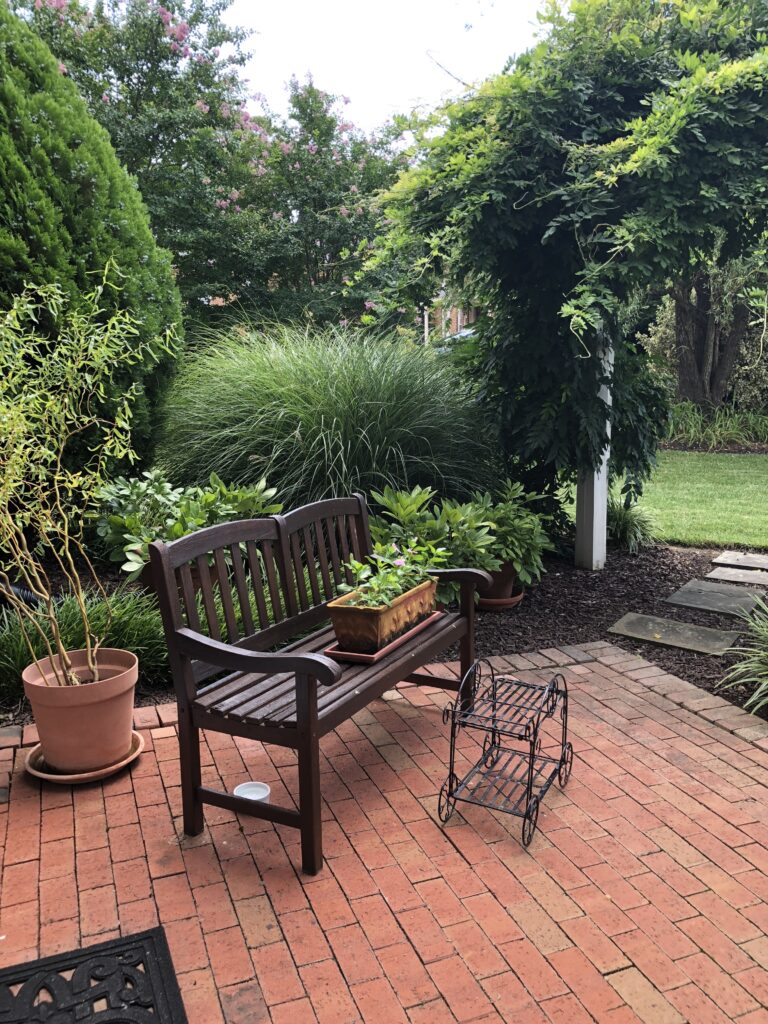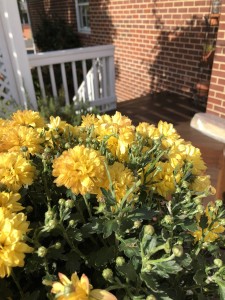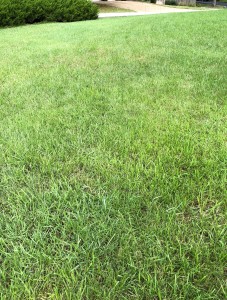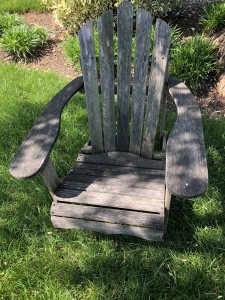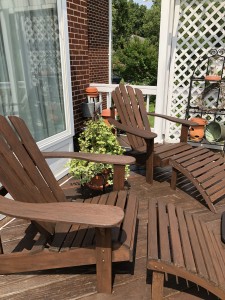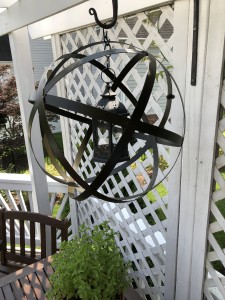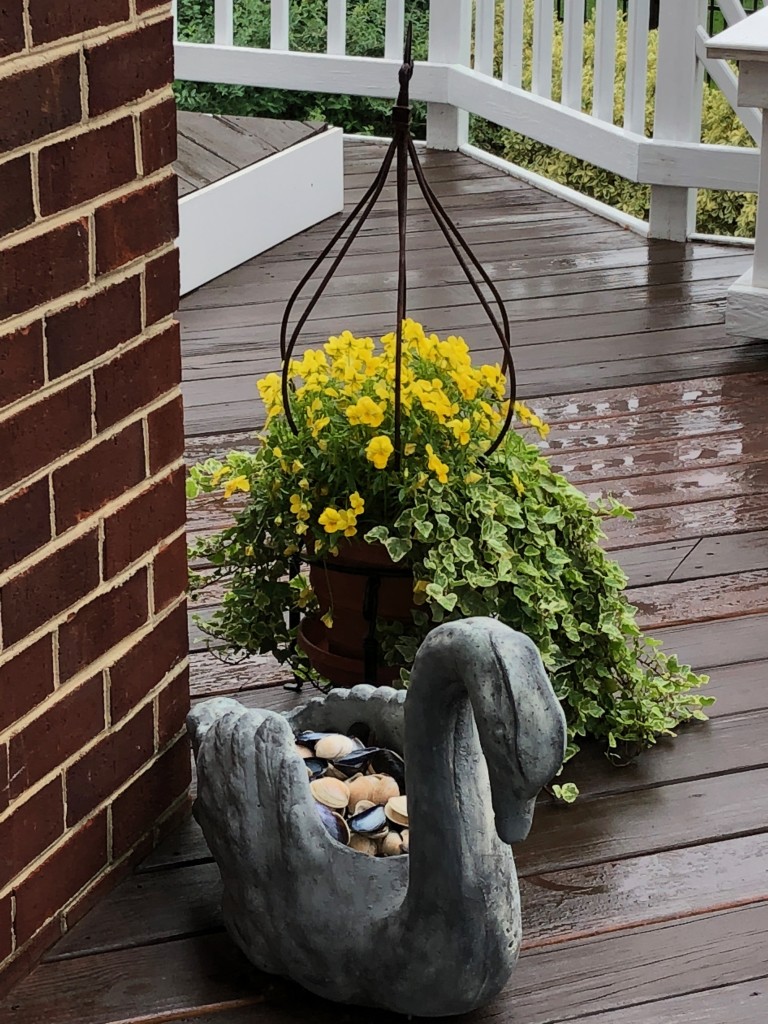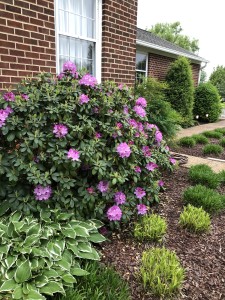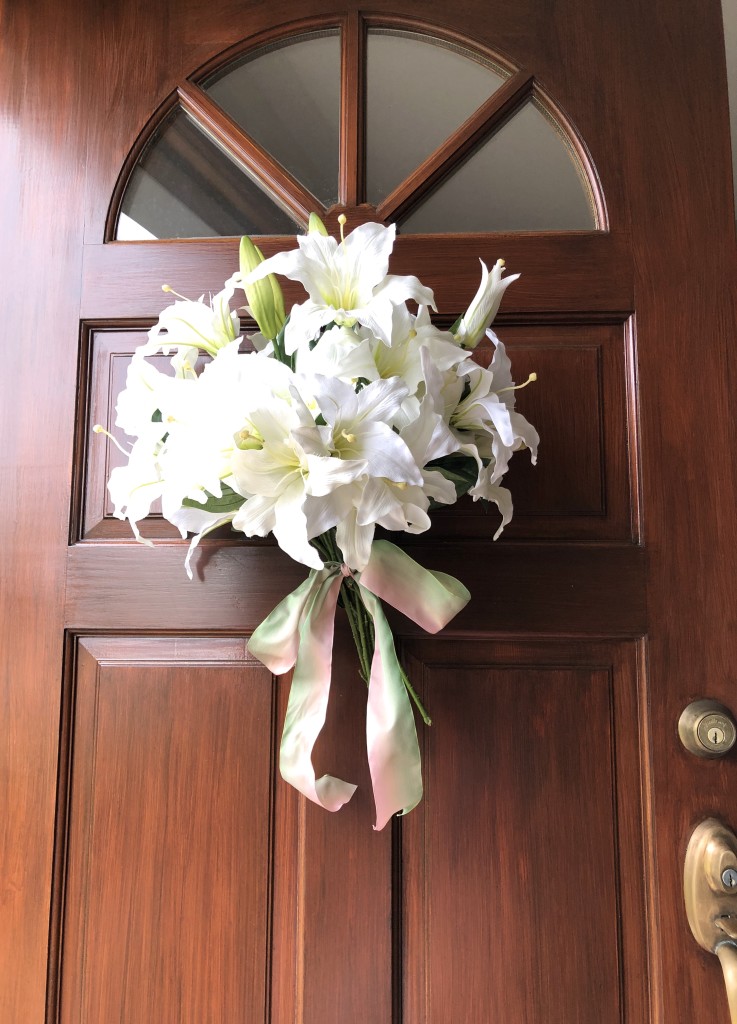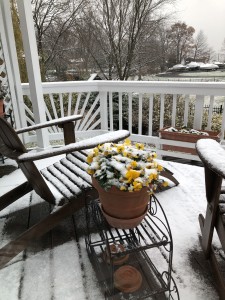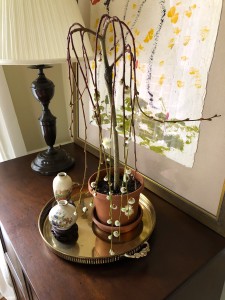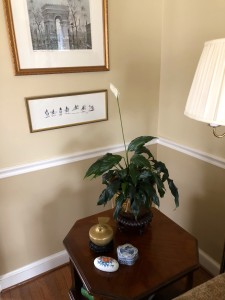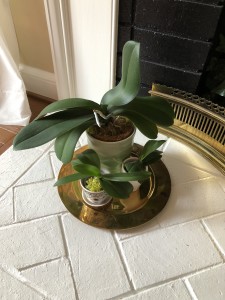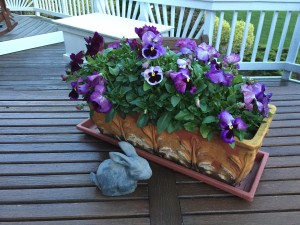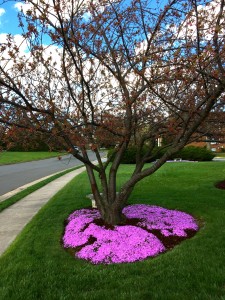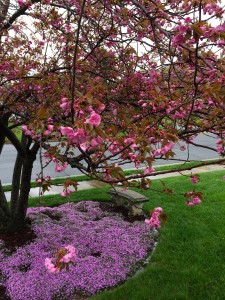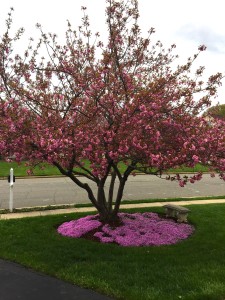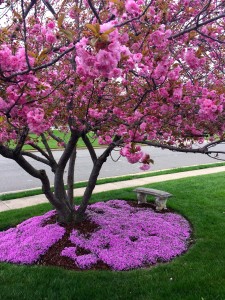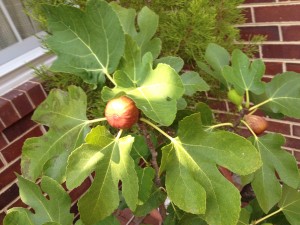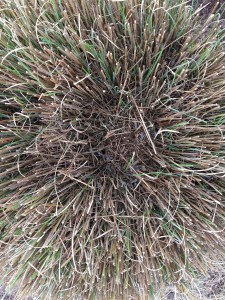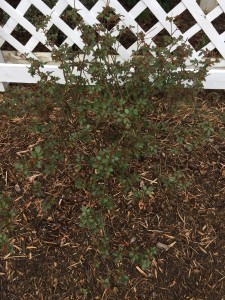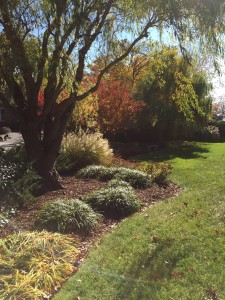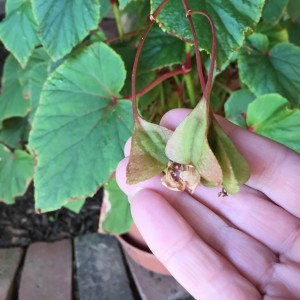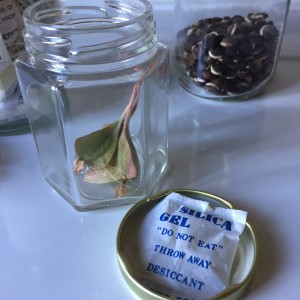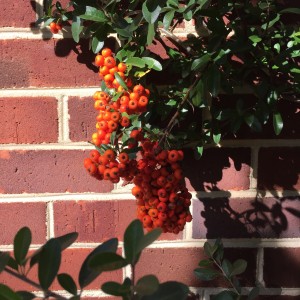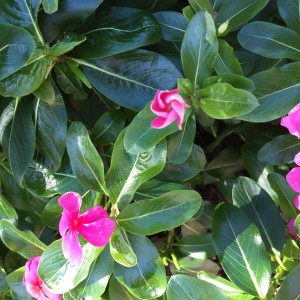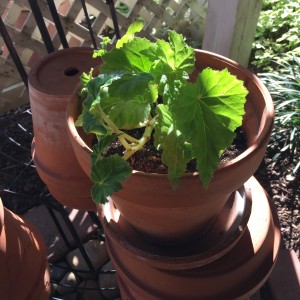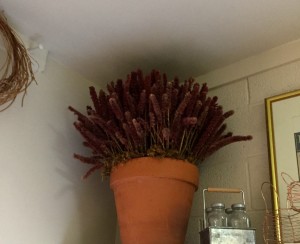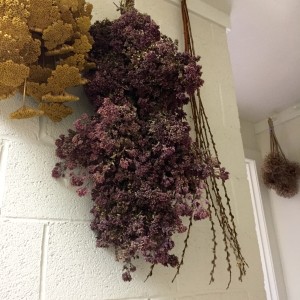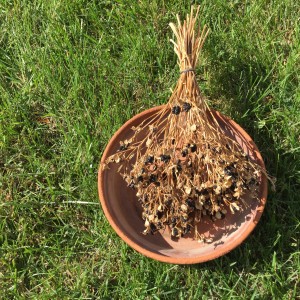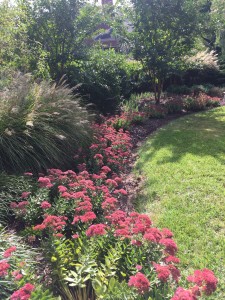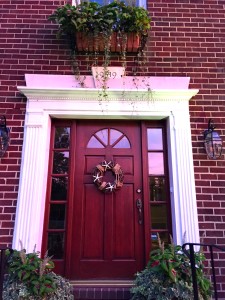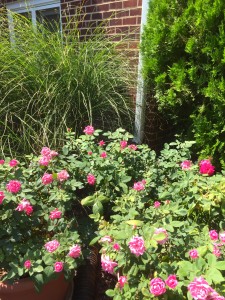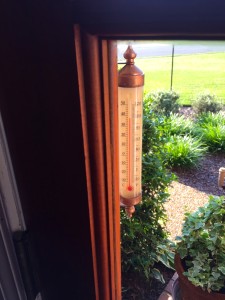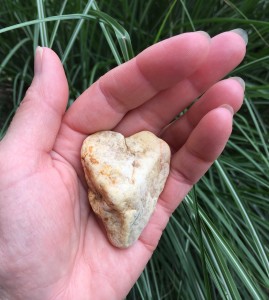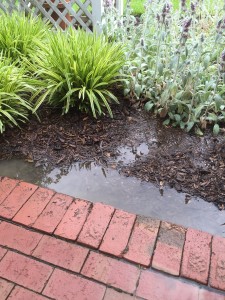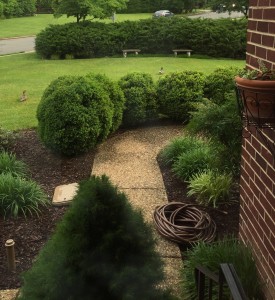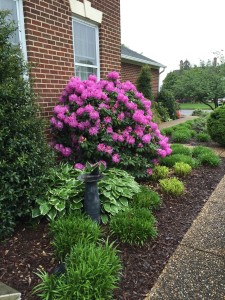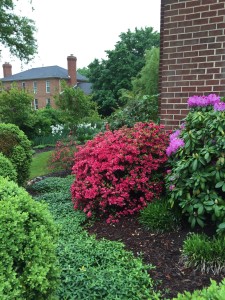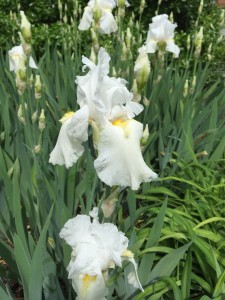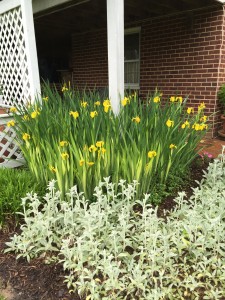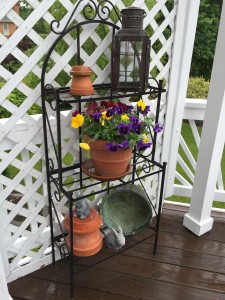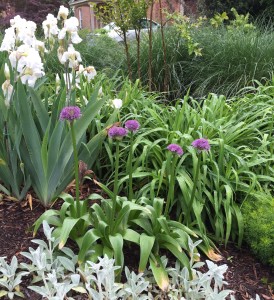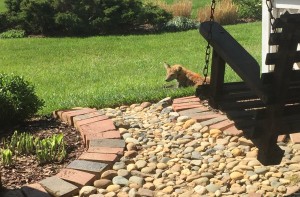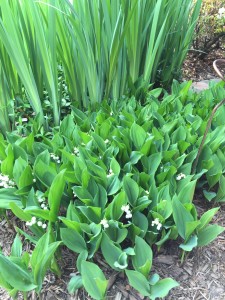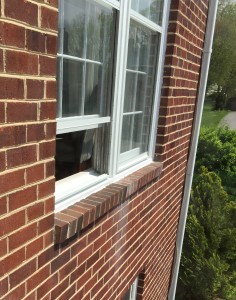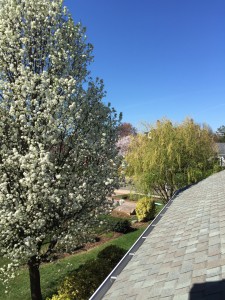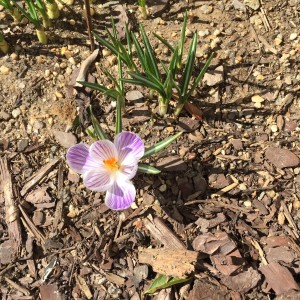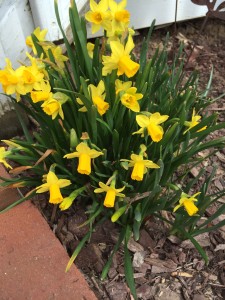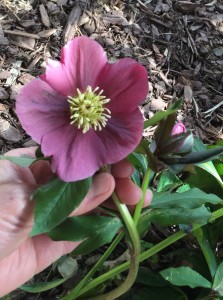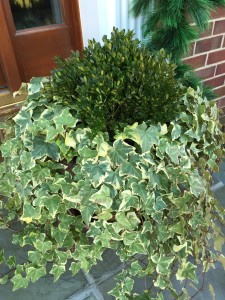
Tag Archive for Gardening in Mid Atlantic area
A House Refresh with Historic Roots
Hello everyone! I have some big changes to show you. After 23 years of living here, we decided that now was the time to do a house refresh. I have been wanting to lime wash the house for years, and my wish finally came true. The house is all brick. It was a very dark reddish brown, and the north-facing side never really was bright enough to show off the plants that surrounded it. Well, now that’s history! Come take a tour of our finished new look —

Our fresh new appearance, with lime wash.
We chose to use a great product from Romabio Paints. Their formula is totally organic, mineral based, and the origins of lime wash go back several thousand years. It stands the test of time and mellows with each passing year in a natural way. The color we chose is Avorio White, which I love because as the hours of the day pass, the color shifts to take on the colors of the setting sun. And after dark, it truly glows.

After dark the new lime wash glows.
Another exciting aspect for me is I now have a light backdrop that shows off the garden. I can use the bright tropical colors of summer in flowers. I’ve filled the garden with magenta, coral, red and purple flowers. It’s so much fun! I’m already planning what colors to use in the autumn, and I am so looking forward to seeing how the house will look decorated for Christmas.
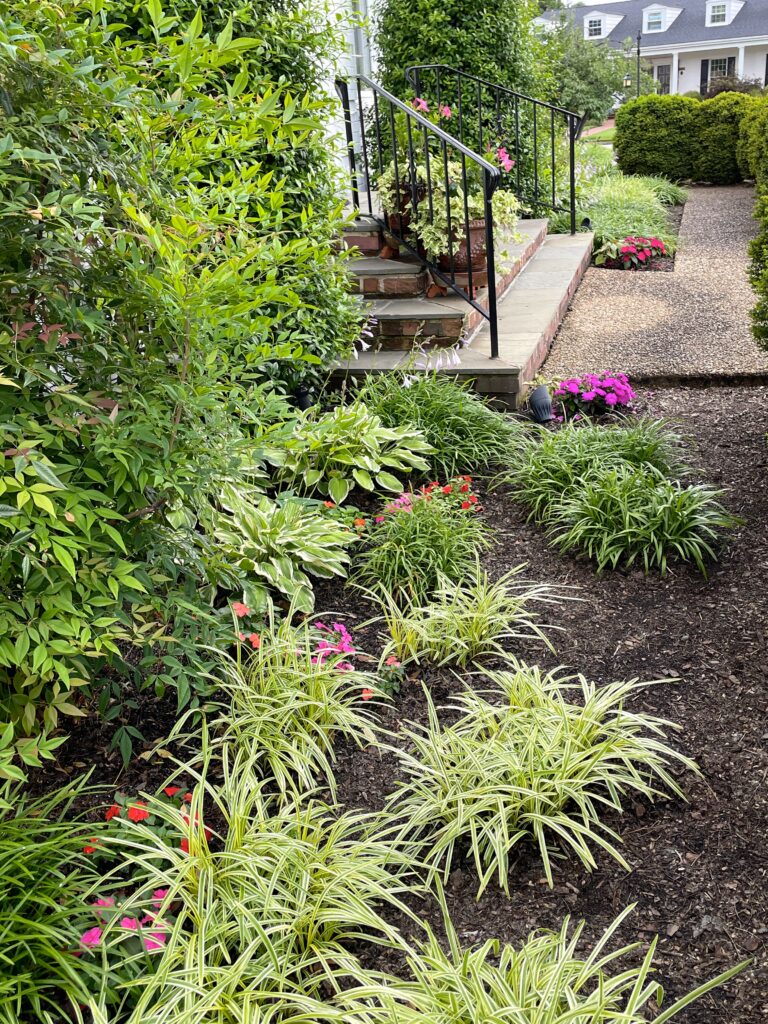
Using tropical colors in the flowers outside really pop with the new light color of the bricks.
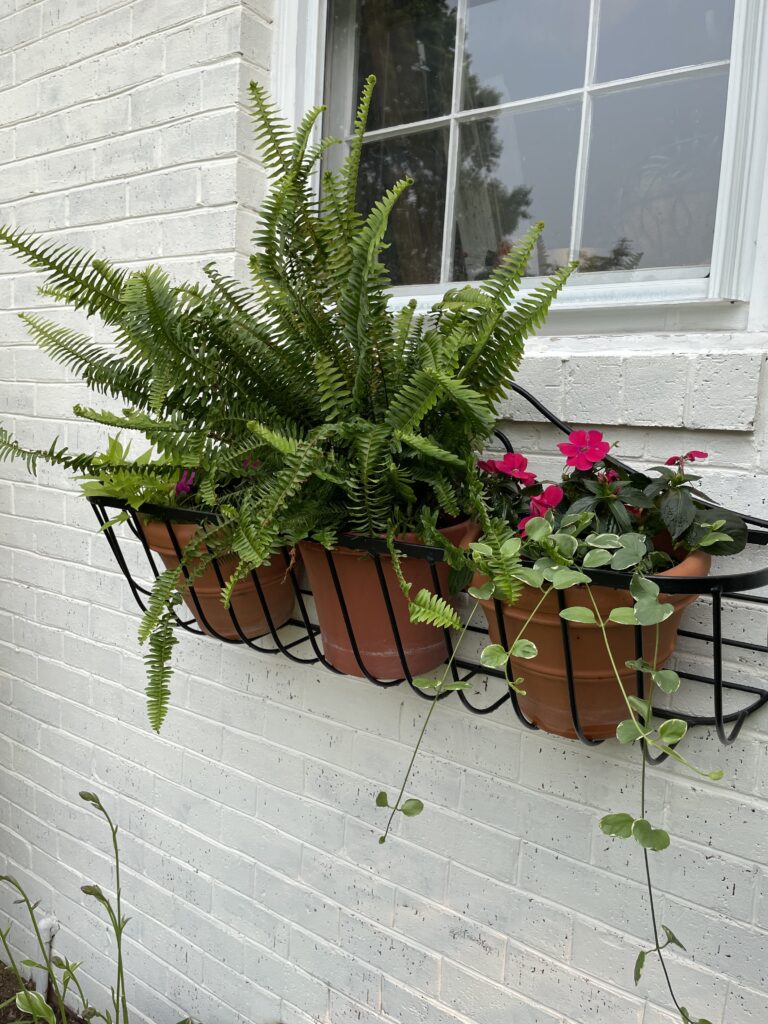
The window boxes got more of the same with lots of tropical foliage and flowers!

This is the front of the garage — now the flower colors really show up, and even the doors do, too.

Here’s an in-process photo to see the red brick next to the lime wash. I am really happy how easy this was to apply, and the soft appearance it gives.
We hired a wonderful company — Brushes with Flair — to paint the top floor and very tall chimneys, while I painted the lower floors. The entire job took a couple of weeks to complete. The bricks are painted one at a time, carefully working the paint into all the mortar joints first, so the coverage is a very protective but breathable finish. It was time consuming, but well worth the effort. I chose not to wash it off for instant aging, but to rather let nature age it.

I also enlarged the stenciled numbers above the door to make it easier to read from the street.

New upgraded decking in a PVC which looks like mahogany.
While were were at it, we also needed to deal with our deck. Until now, the deck was pressure treated wood, which I sealed each year. In the days of old, a new pressure treated deck would last a couple of decades. Although the deck here was only 13 years old, we had to replace many boards over the years due to rot, and we finally gave up on it. We chose a new product from Timbertech that is made from PVC and is warranted to last 50 years. I guess time will tell, but we are grateful not to get splinters like we had from the old decking. The joists were also replaced, and all new bracing for hurricanes underneath, so now we are good for a while! Updating the rails, which looked a bit dated before, made a big difference, and the new LED lights are our new favorites.
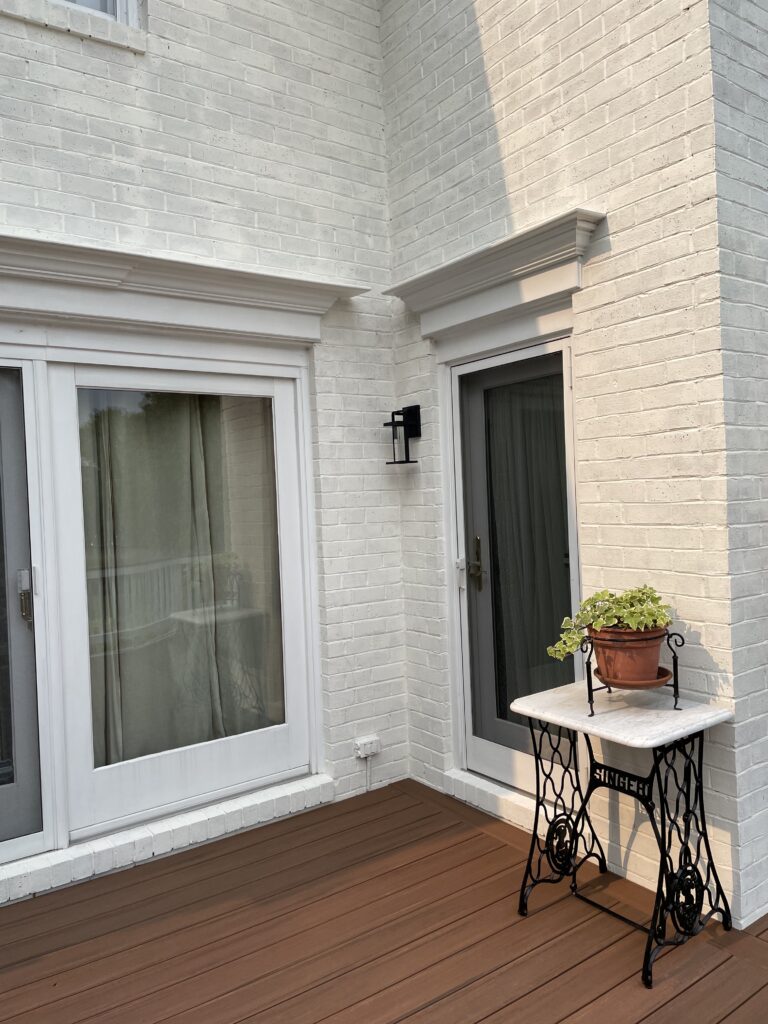
We love the new LED lighting. They are much more energy efficient, and we don’t ever have to replace a bulb again!

We are looking forward to enjoying the deck now, if only the heatwave would subside. At least we can look forward to doing so in the fall!
Hope you enjoyed the tour! Wishing everyone a happy and safe summer. Until next time!
A Cherry Blossom Tree Craft For The Ages
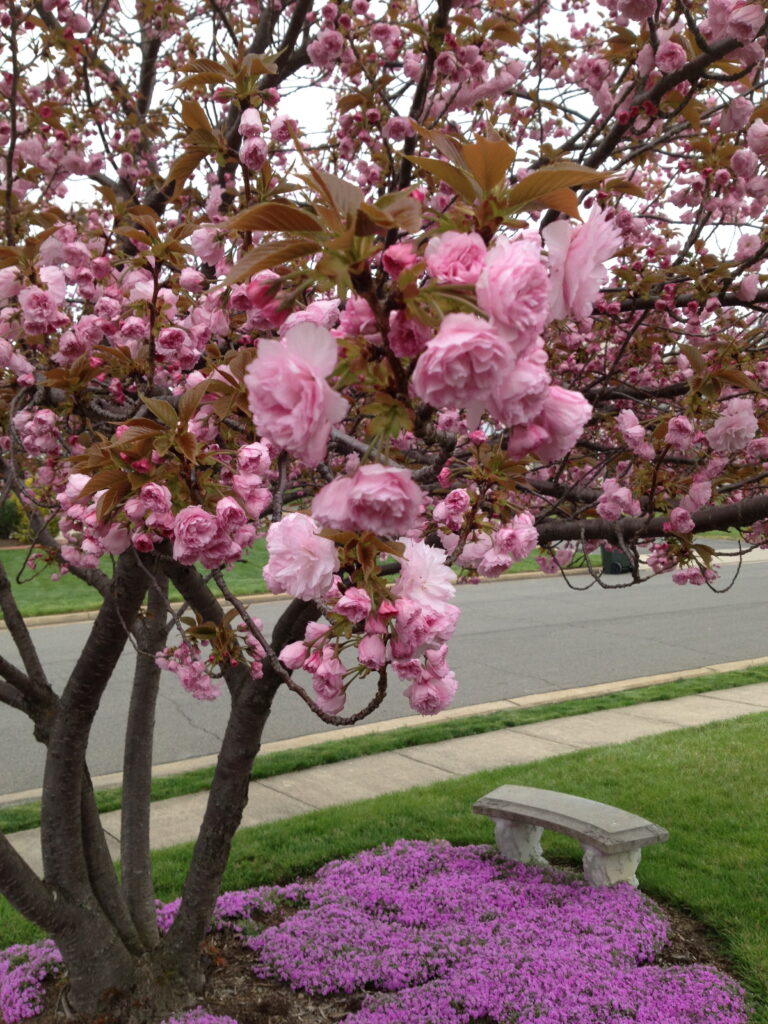
It’s almost cherry blossom time here in the D.C. metro area. That is the time all of us who live around here look forward to each year. It is a magical time, the harbinger of spring, and a time to enjoy all the beauty that Mother Nature provides us. It’s fleeting though, and the tree blossoms only last for a couple of weeks, if we are even lucky to have them for that long. So today I want to show you an easy peasy craft that is super realistic looking, and will last years to come! Come along, and I’ll show you how to make this cherry blossom arrangement —
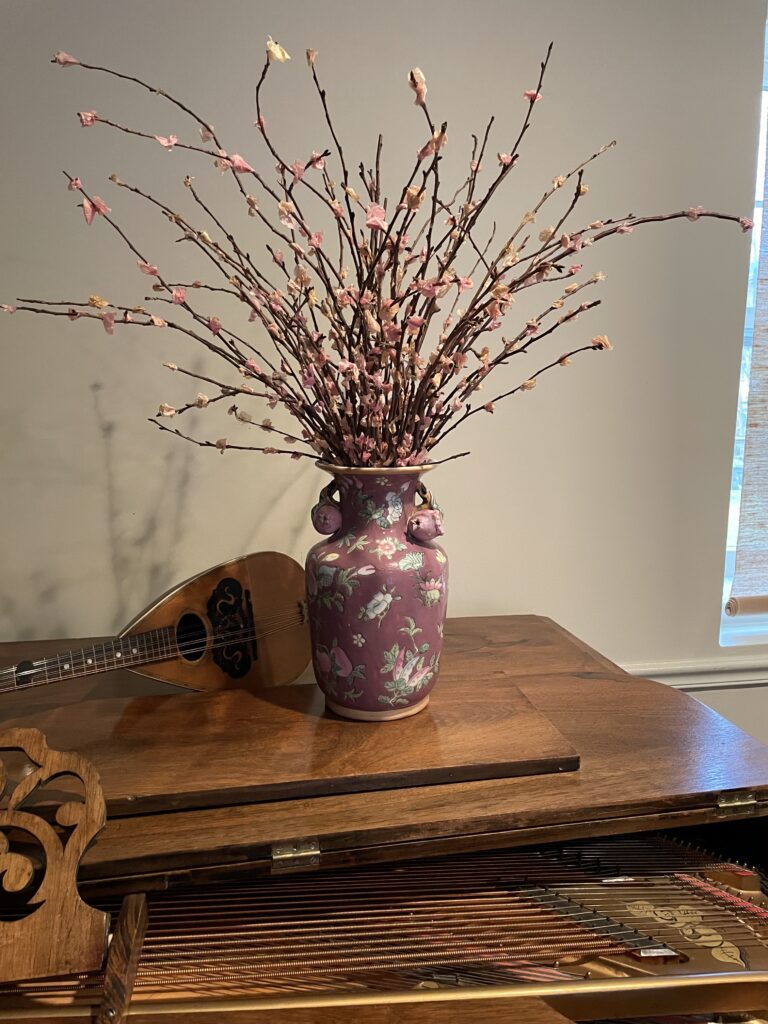
First step is to go out in the yard and pick up dead, fallen branches. These were from actual cherry trees, but many other types of tree branches work well: willow, dogwood, crepe myrtle — really, any branches that are thin will work for this. They can be straight or curved. Collect as many as you want for your arrangement. For reference, this one has about 30 branches and fills a 5 inch diameter vase. Next, cut the branches to what ever length you desire. Those in the photo are about 24″ long.
The next step is to cut LOTS of 1 1/2″ circles out of pink tissue paper. Plan on at least 6 circles for each branch. You can buy a paper punch at craft stores to make these circles quickly, or go old school and just cut them out free form, they don’t need to be perfect. Fold each circle into quarters, and crimp the bottom. This makes the little individual blossoms. We found it easier to make a whole bag of them at one time. Glue each blossom on a branch, leaving 4″ to 5″ of space between flowers. My favorite glue to use is a hot glue gun because it dries so quickly, but you can really use any craft glue so long as it dries clear. Let the glue dry thoroughly.
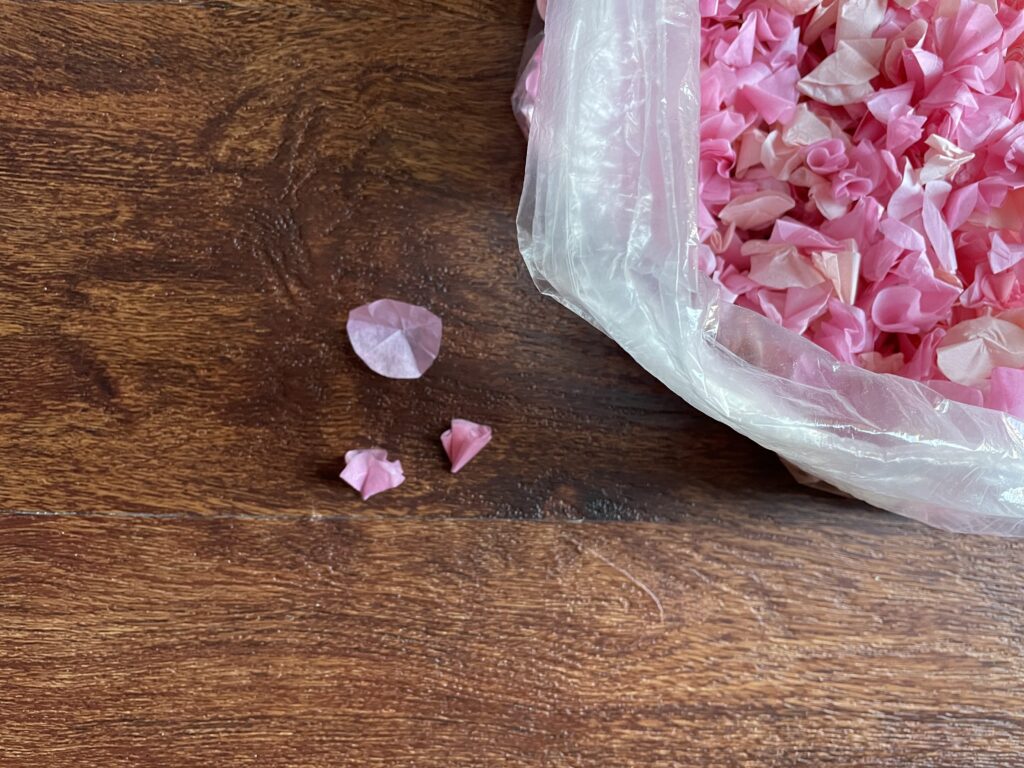
An alternative would be to make coral colored circles which would look like quince branches, or yellow circles would look like forsythia branches.
Next, using a vase of your choice, add each branch individually into the vase to get a beautiful shape, and enjoy! These are so beautiful, and look so real! I’m not kidding when I say these are 20 years old; they really last a long time! I hope you will try to make some.
Happy Spring Everyone!
Creating Destinations in the Garden
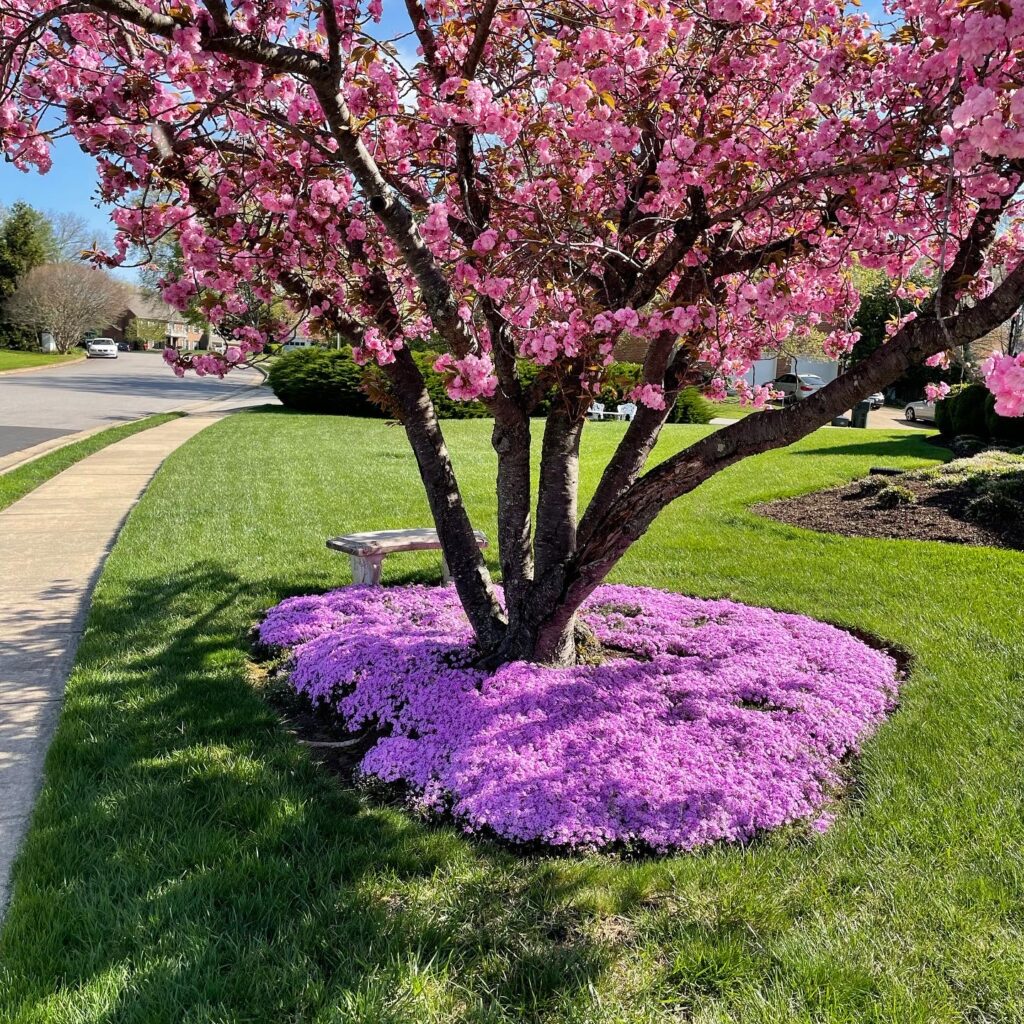
Hi friends! 2022 springtime is at full tilt here in our garden. It’s been a long time since my last blog, and much has changed. We lost my sweet 100 year old Mother-in-law last October, and it has been a difficult six months. To honor our dear Mom, we are using her beautiful antique iron outdoor furniture here in our garden. I think it makes the whole garden look inviting, and creates destinations in each of the prime areas in the yard. I can’t think of a more earth friendly way of recycling than to reuse lovely, old pieces, and to honor the fabulous lady from which they came. I will give you the tour, enjoy!


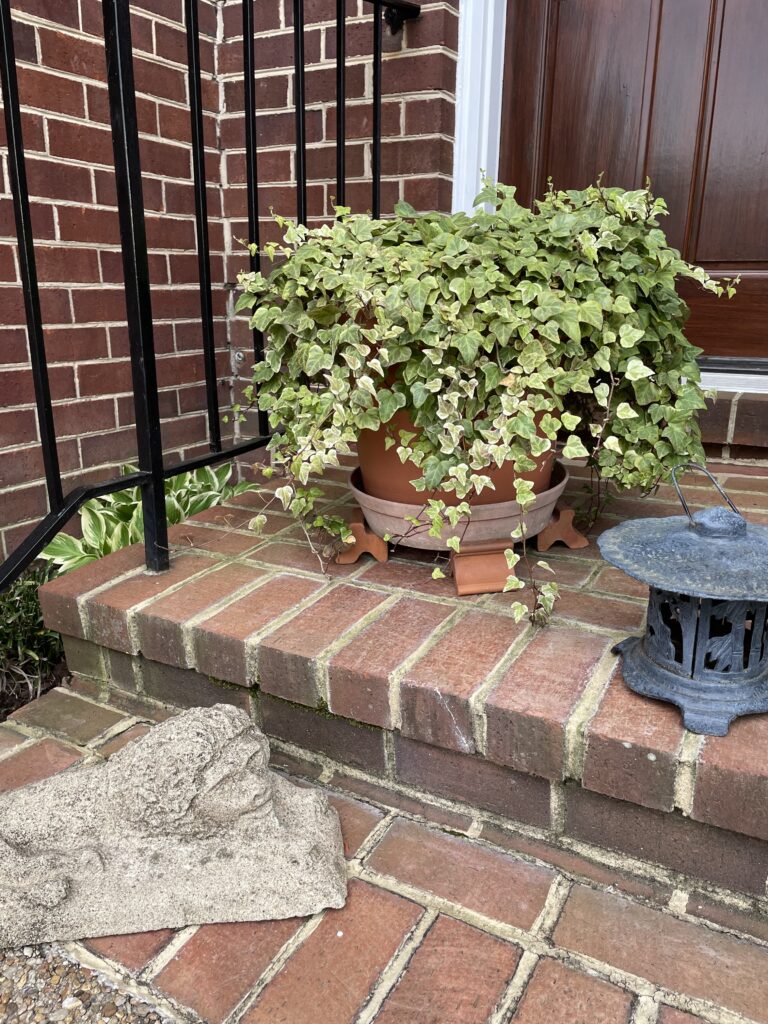
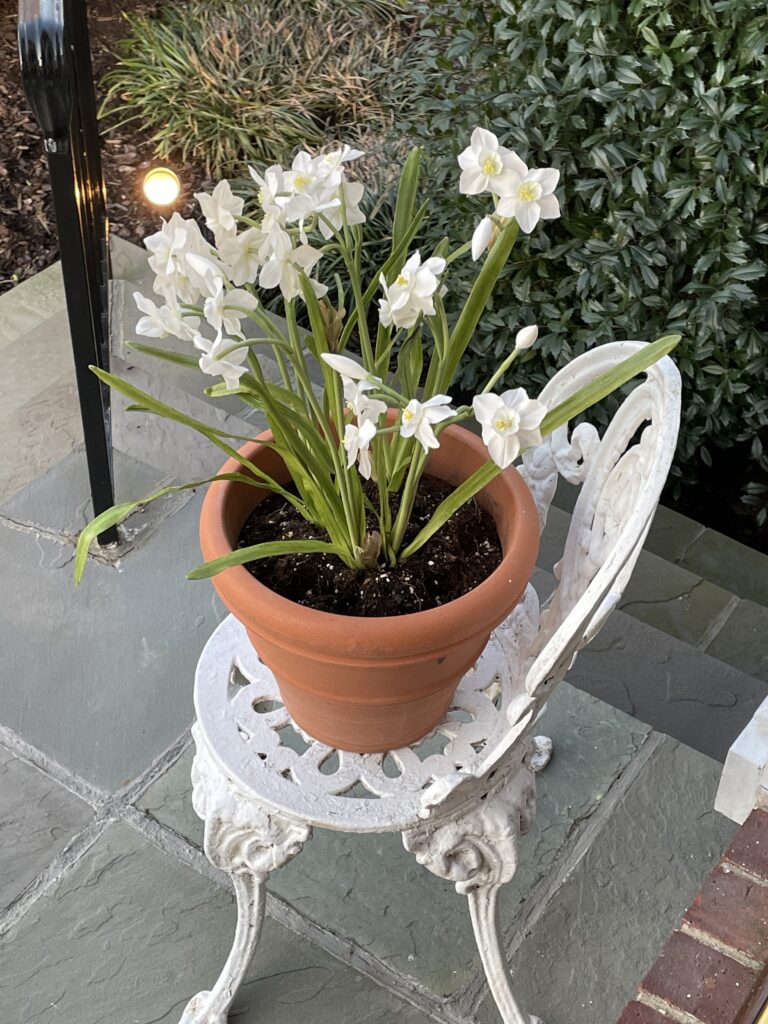
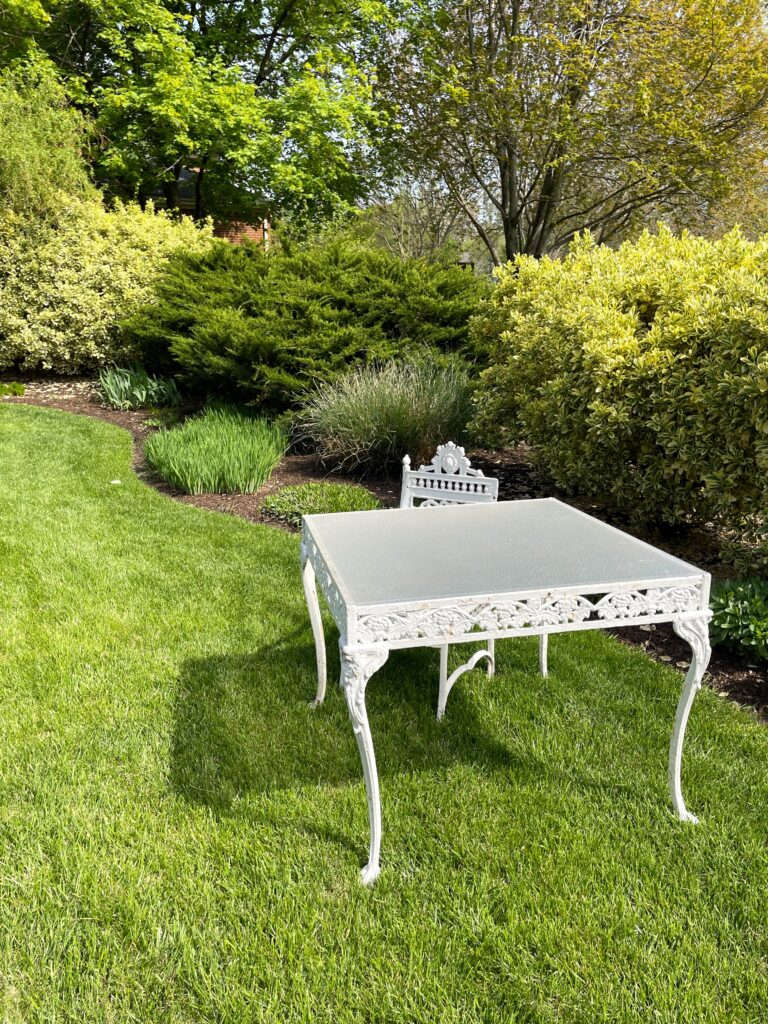
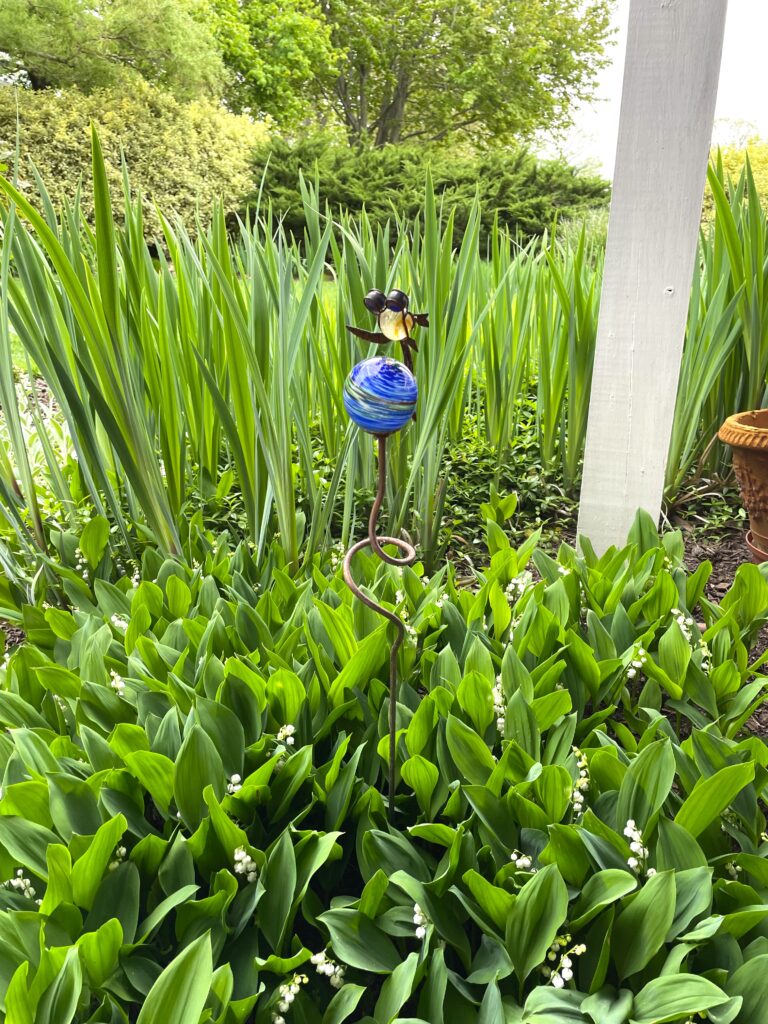
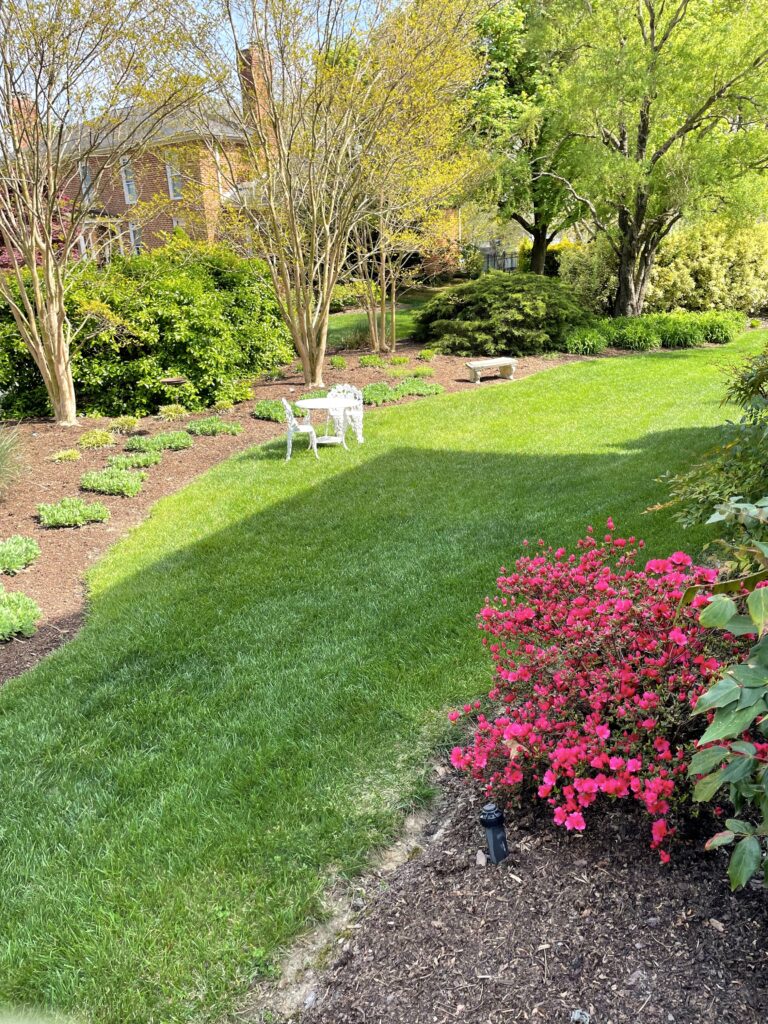
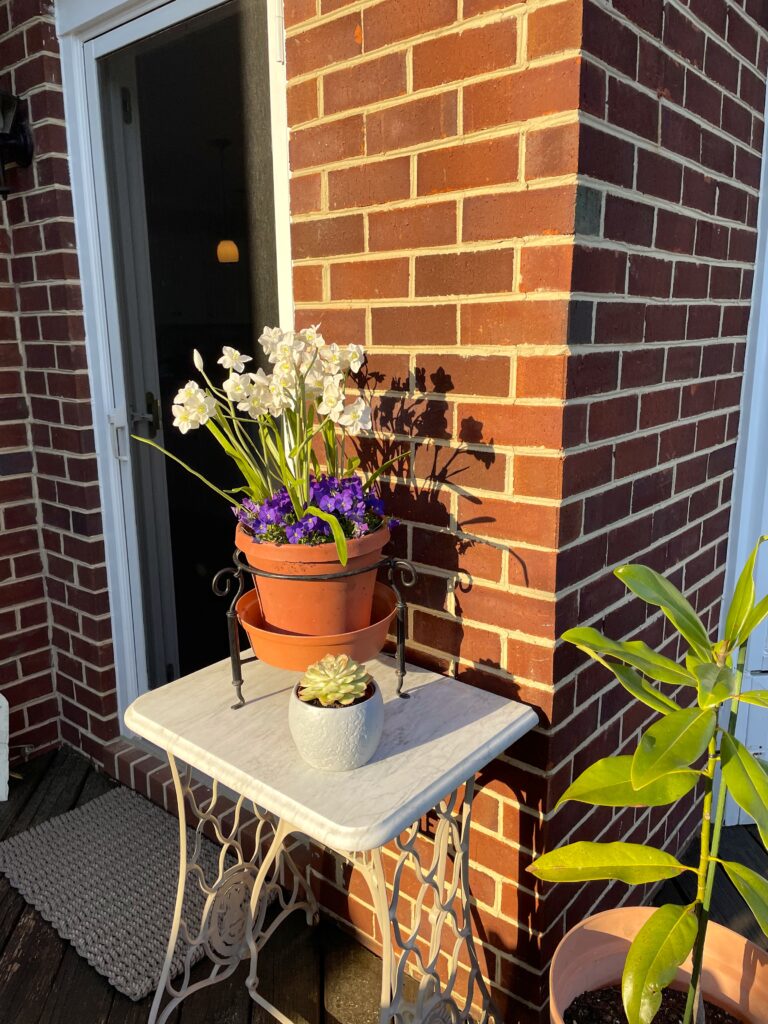
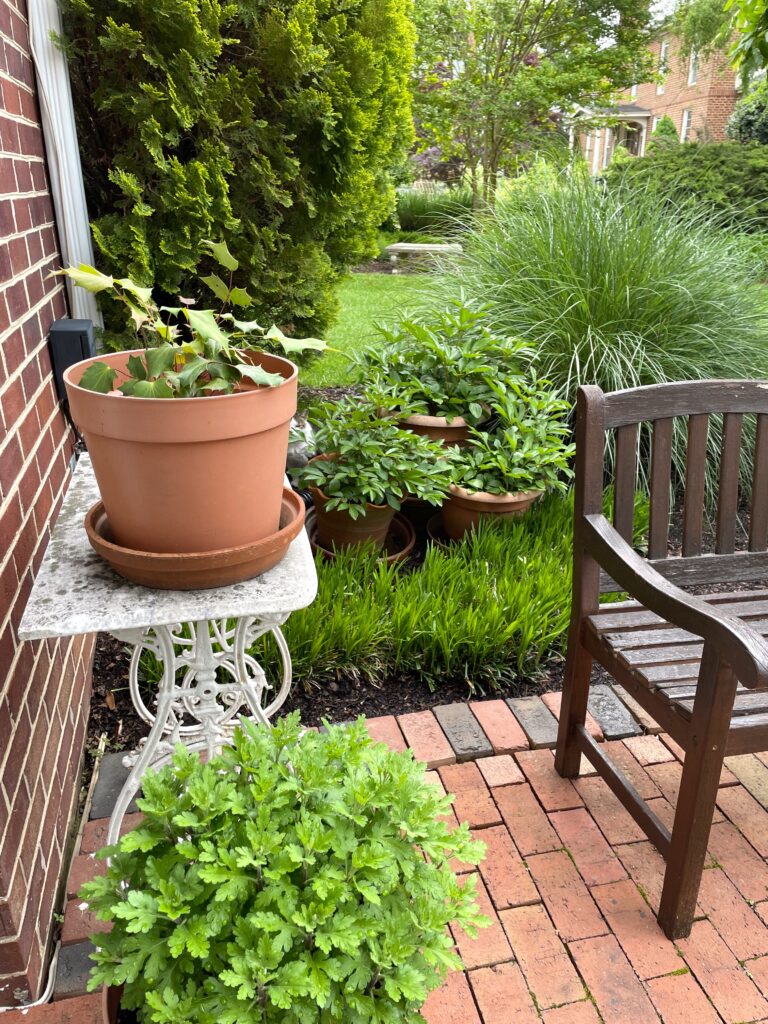
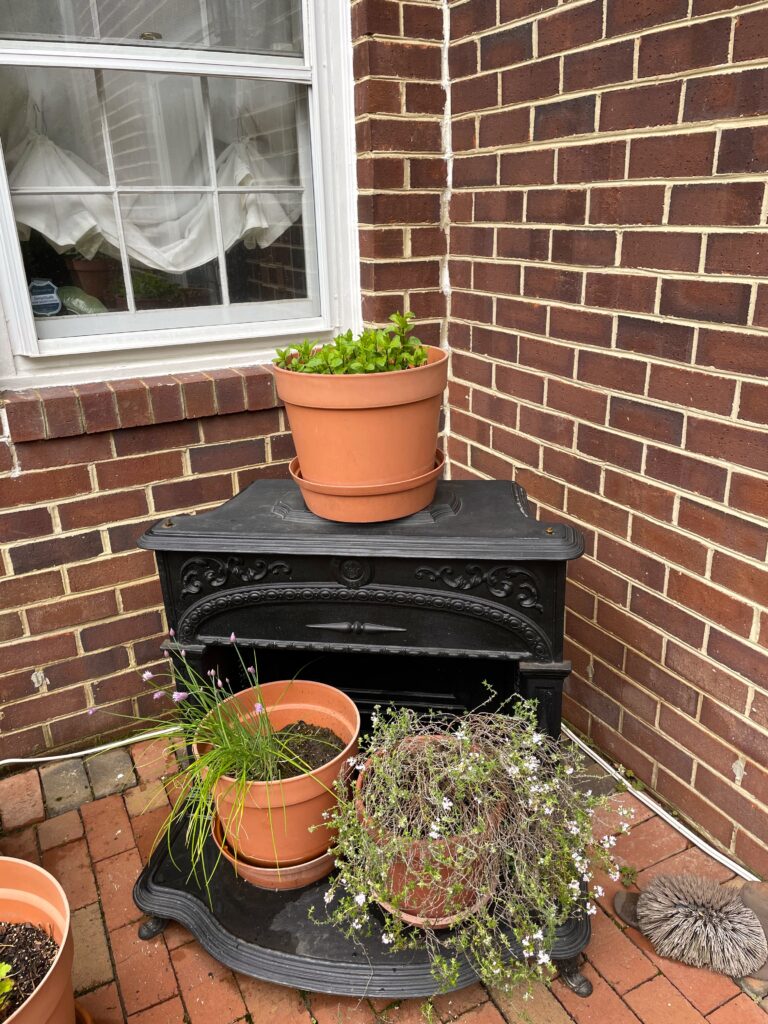
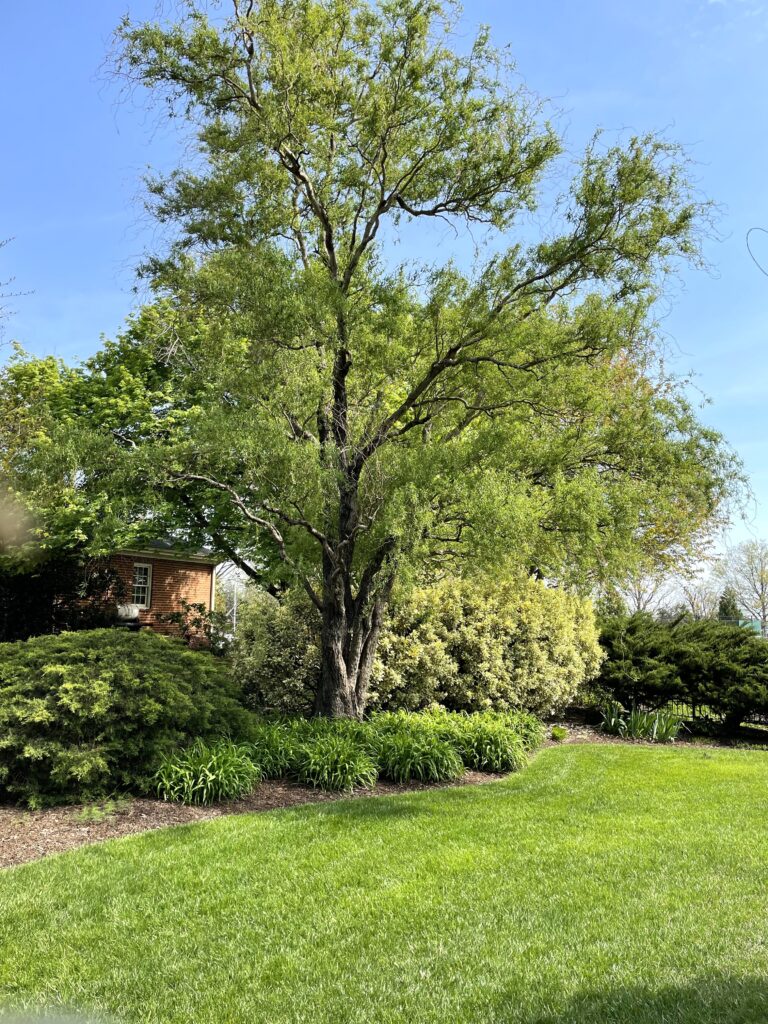
Summer 2021
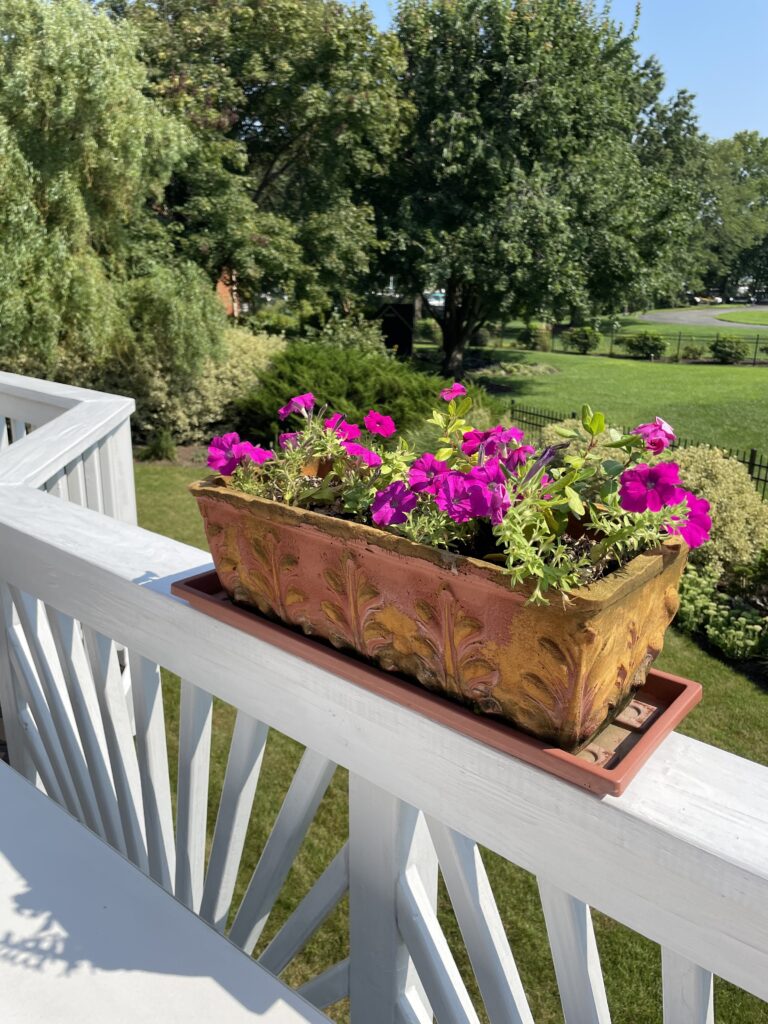
This was a summer for the record books — high heat, heavy rain, and drought! It was very harsh on the trees, flowers, bushes, and all the humans and animals as well. Here is my view on what plants did the best this summer, what suffered worst, and a few of my tried and true tips for dealing with it all.


From this angle of the back yard you can see how much everything grew this summer! The lower area gets a huge amount of sun, but the upper area (where I stood when I took this photo) gets some nice shade from the trees in the late afternoon now that they have grown so large. This is opening up all kinds of new possibilities with plant material, so I may be increasing the garden beds this fall to move some of the plants to higher ground. It doesn’t look like it in the picture, but it’s about a five-foot difference in terrain height, and this nearly creates a running river through the grass during a downpour. Adding the drywells and some more curves to the edge of garden beds can help a lot with that, so that will be number one on my list of to-do’s when the weather cools down.
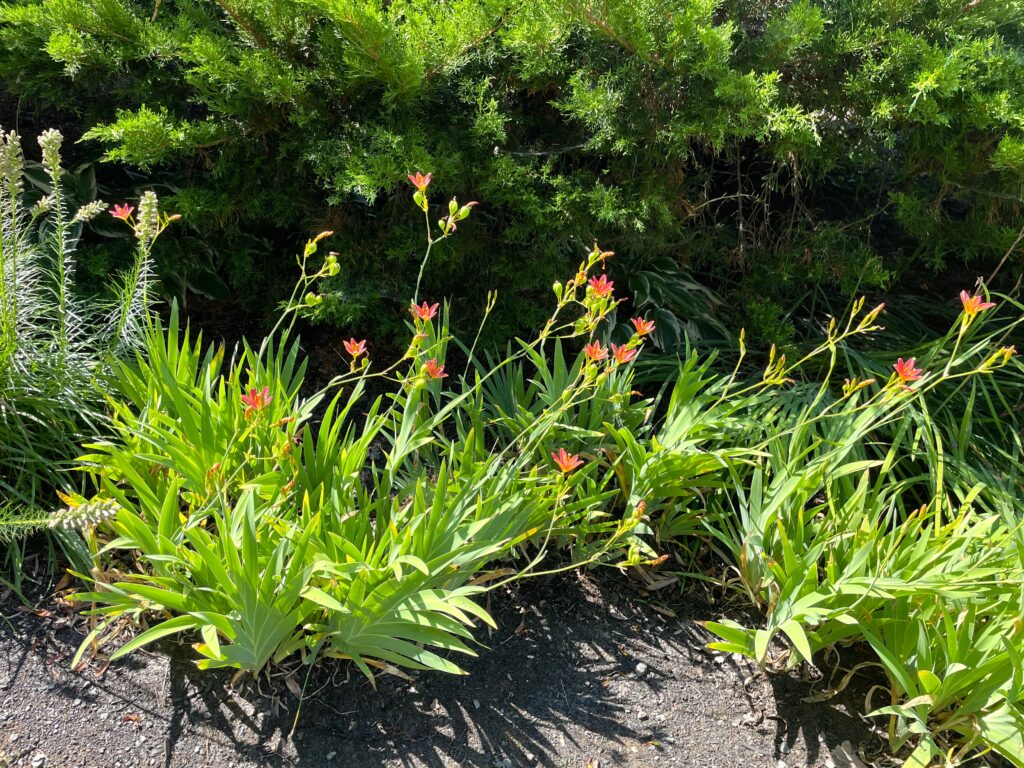
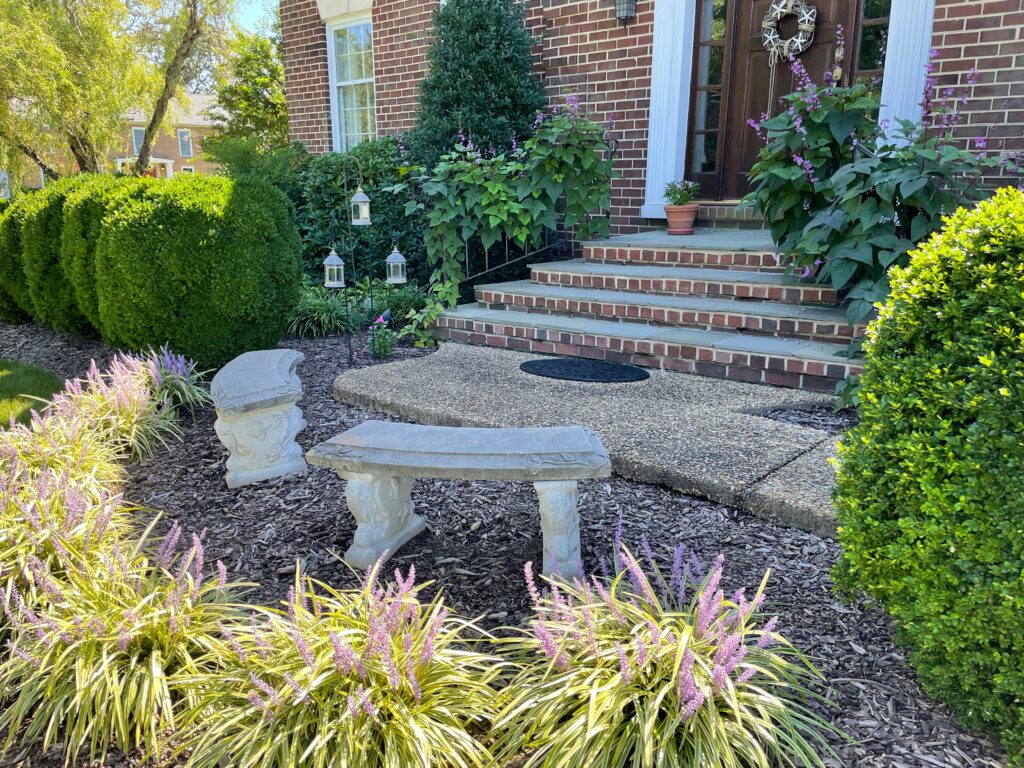
Each year I fall in love with the purple hyacinth bean vines, and this year is no different! They are a show stopper! And the liriope is a perfect compliment to it with its purple spikes. Right now it is like a purple lover’s dream, one of my favorite plant combinations. And they don’t mind the outrageous heat we’ve had this summer!
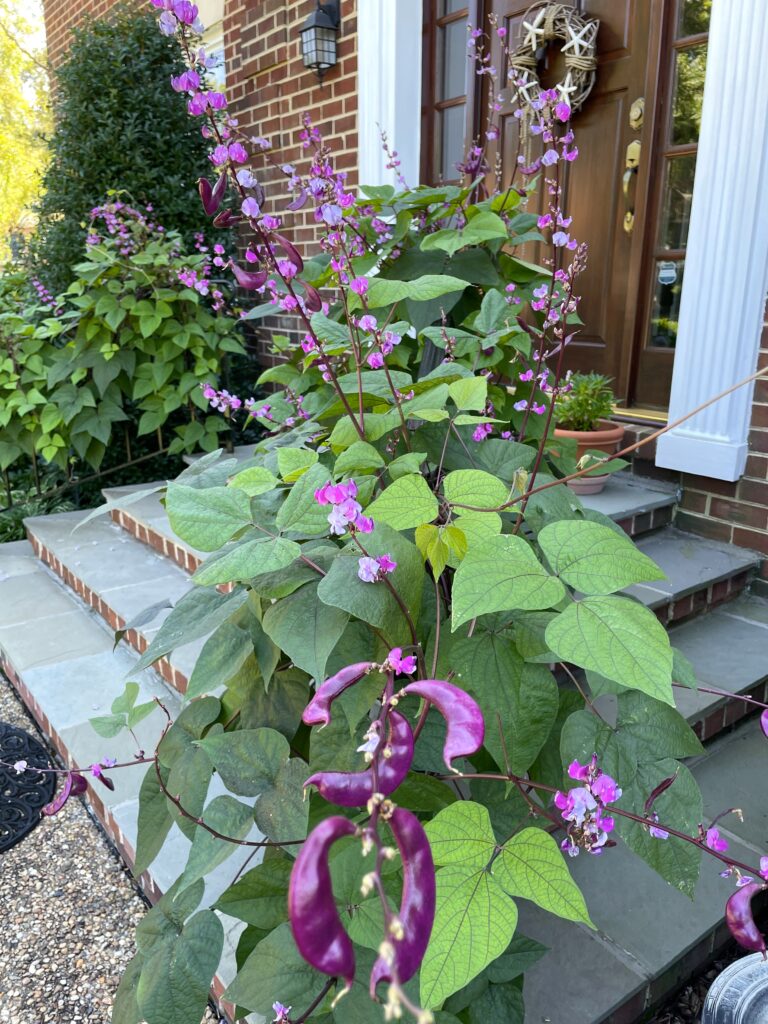
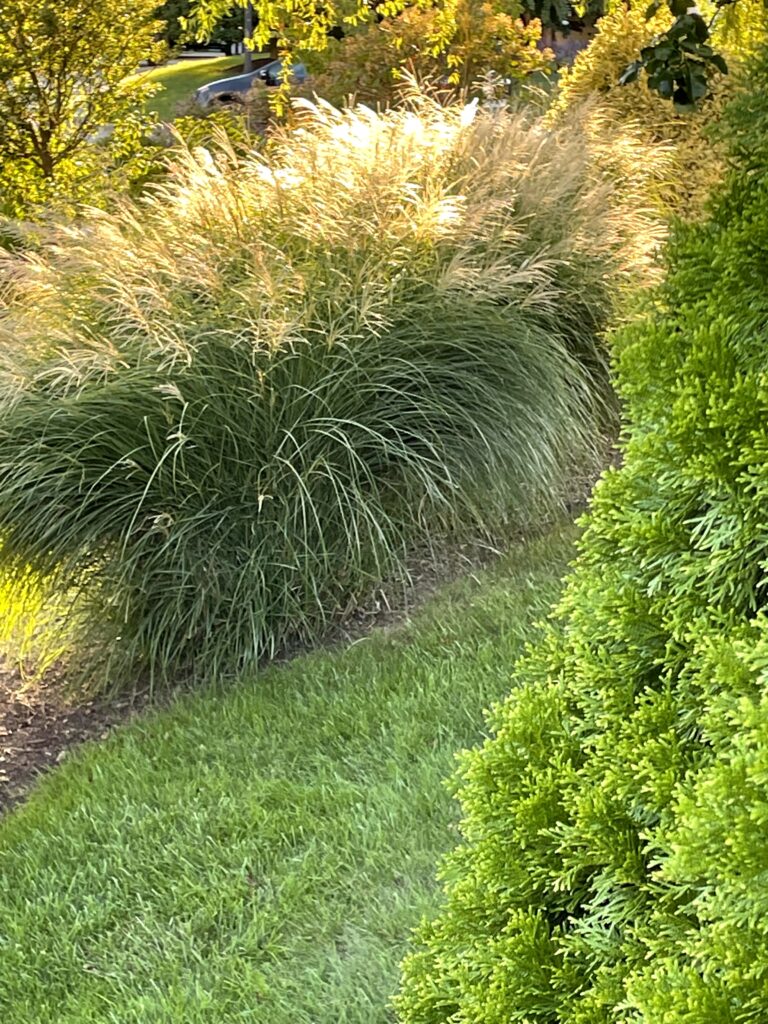
This pyracantha has come back! Just look at all the berries! I was about to give up hope when the main trunk died of a horrible fungus a year back. I had to cut it to the ground, and painted all the remaining stumps with daconil. There were just a few new sprouts that came up from the ground last year, but this year it is growing fast and looking fantastic again! It will cover the brick wall again soon, and I plan to train it into a cross-hatch espallier style, if I’m lucky. I anchor it to the bricks with black plastic coated wire, so that I can adjust and support it until the branches grow strong enough on their own. I find that it is almost invisible, and very strong, and you can use it over and over.
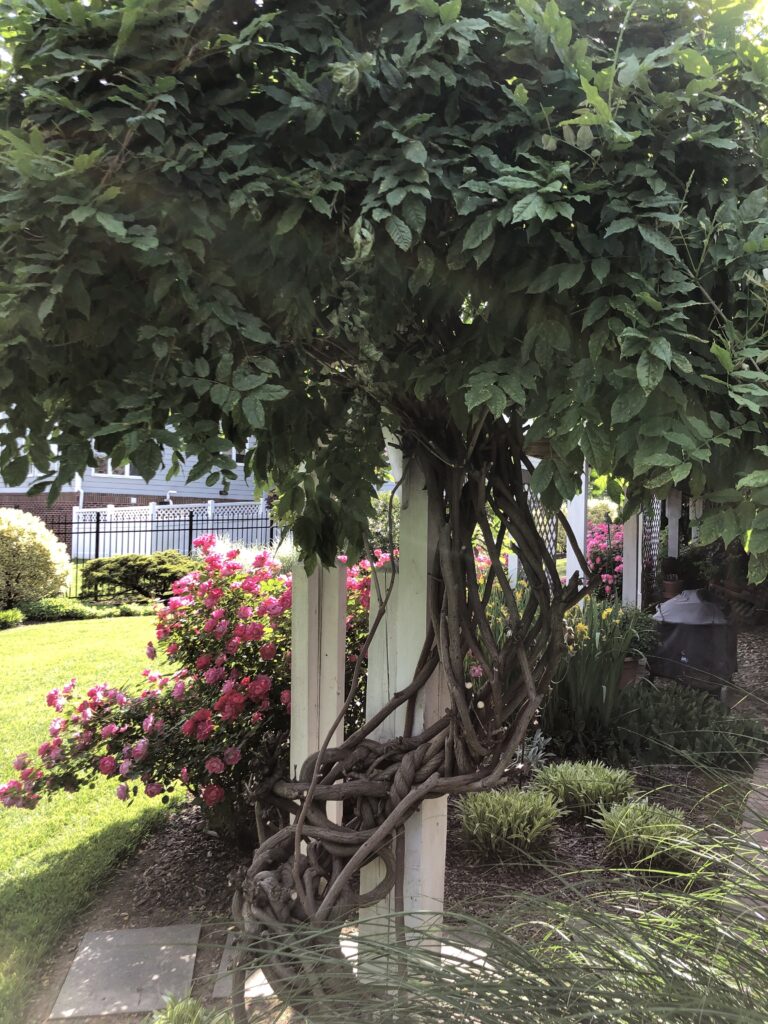
This was an eye-opening year for so many reasons, but it’s always a pleasure to me to get to dig in the dirt, and work some magic with plants. It is truly an honor when you get to stay in a home for a number of years and can see the fruits of your labors. A first for me!
Sometimes it takes these years with extreme weather to really bring out some of the best qualities of plants. With climate change, we will all have to adjust what we plant, and learn to garden using different and changing rules. Using tried and true plants, and regional natives, we can still have beautiful yards and gardens. We all have micro-climates within our yard. Even on the different sides of the garden, some plants will do better than others, more so now than ever. Lots of planning, observing and editing from year to year gives gardening its challenge, but to those of us who love the earth, its reward is huge! We nurture it, and it nurtures us. Happy Gardening!
Easter Around the House
It’s a countdown to Easter, with bunnies, birds, and flowers in and around the house. Enjoy the tour!

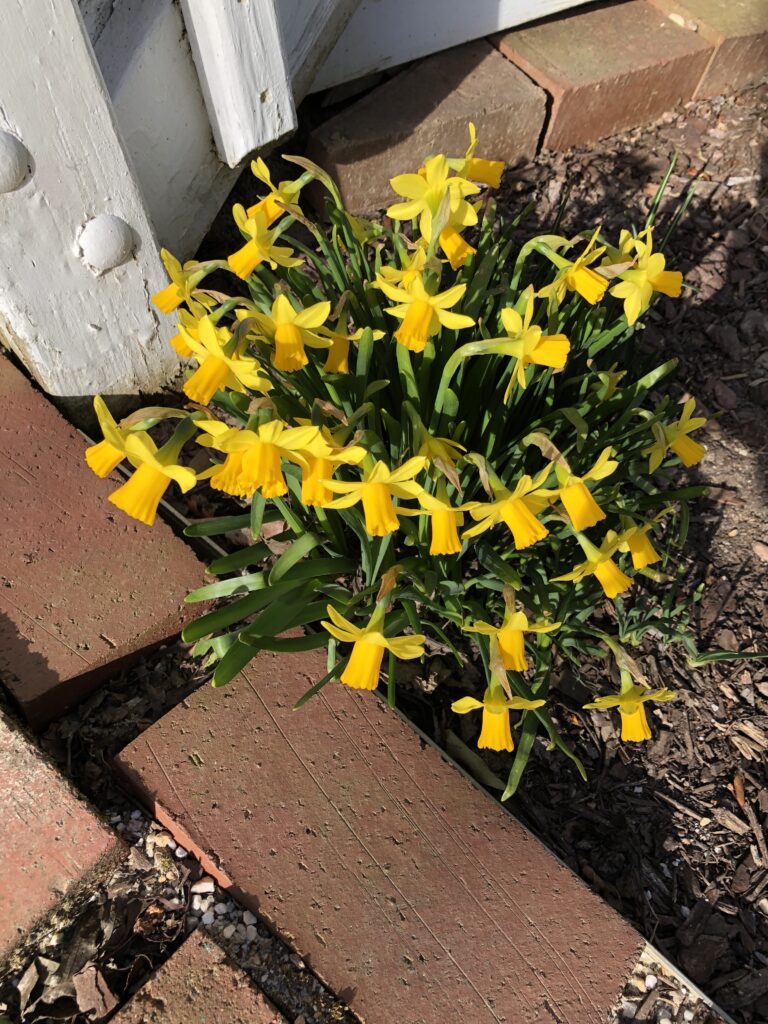
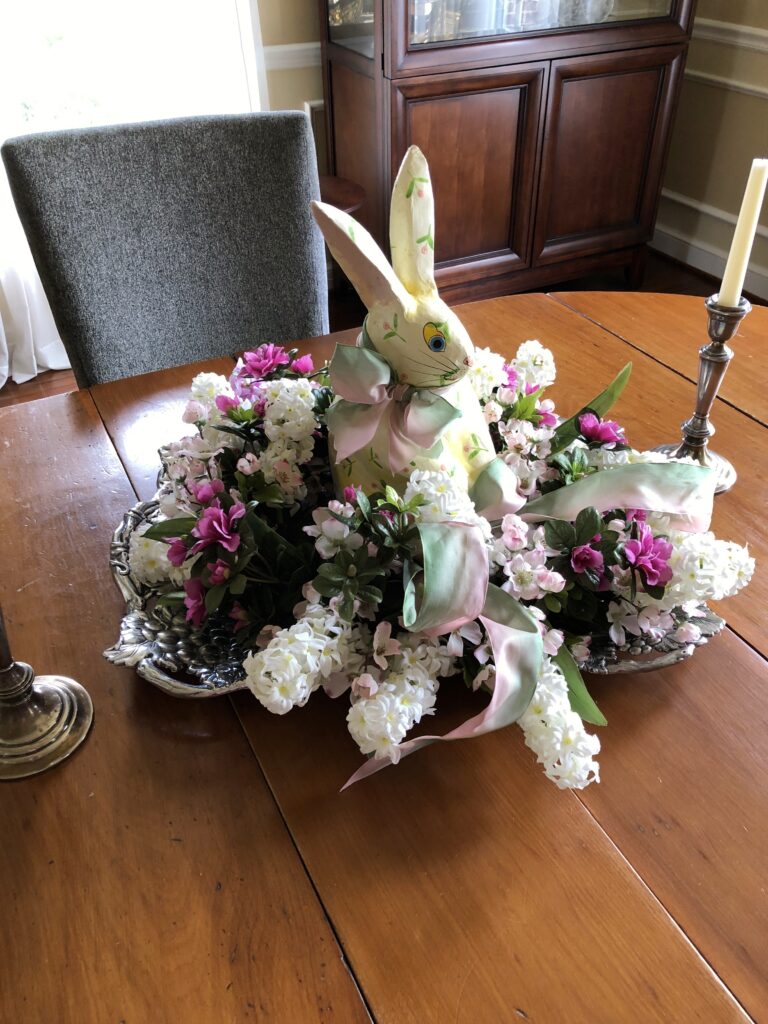

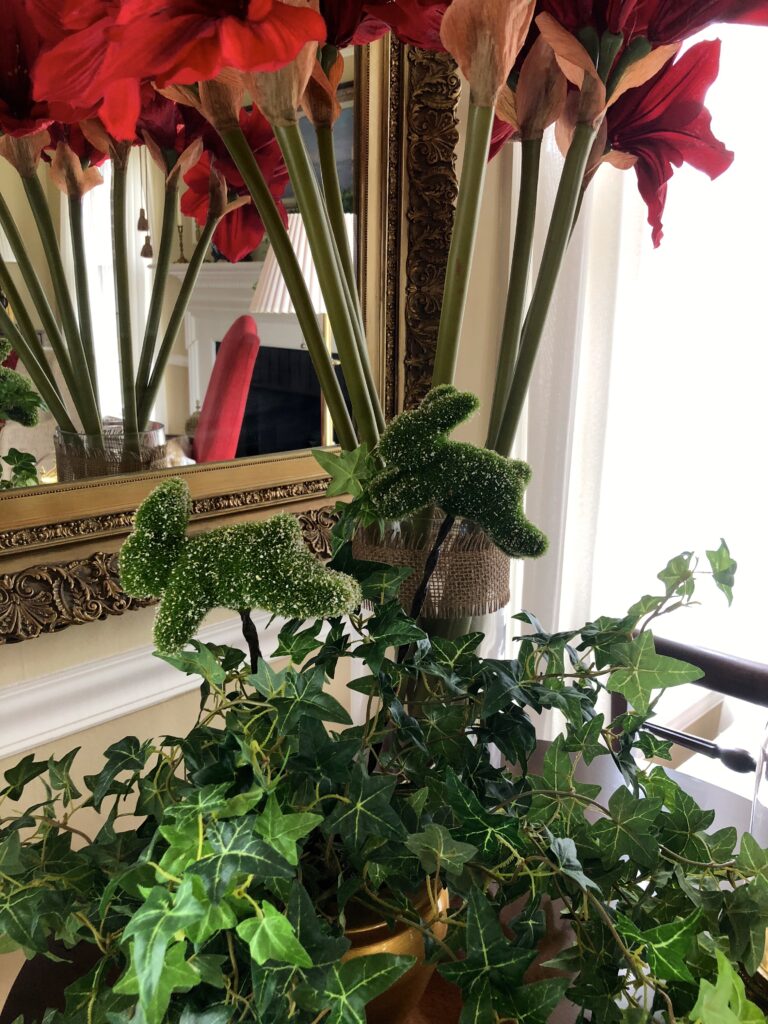
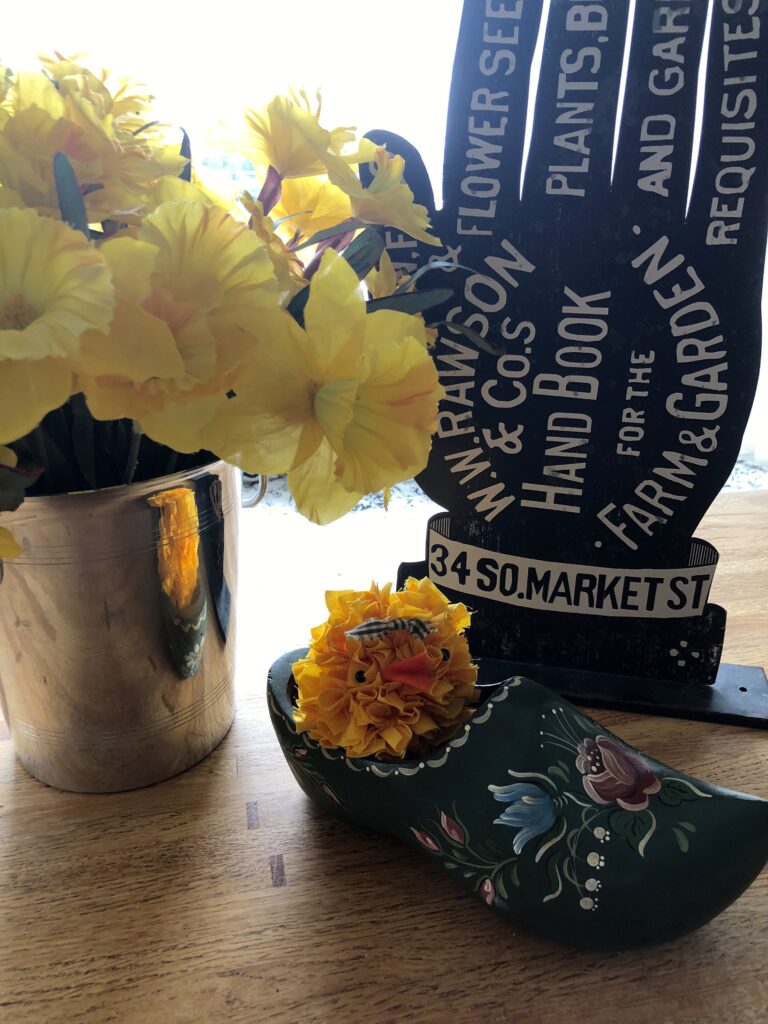
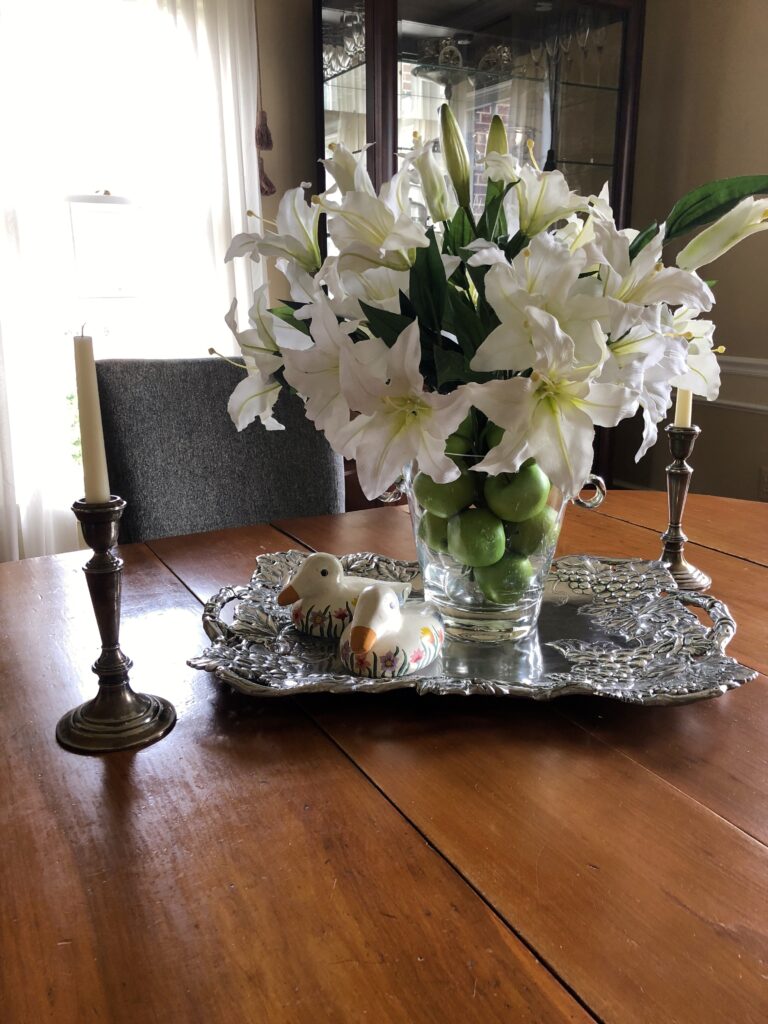
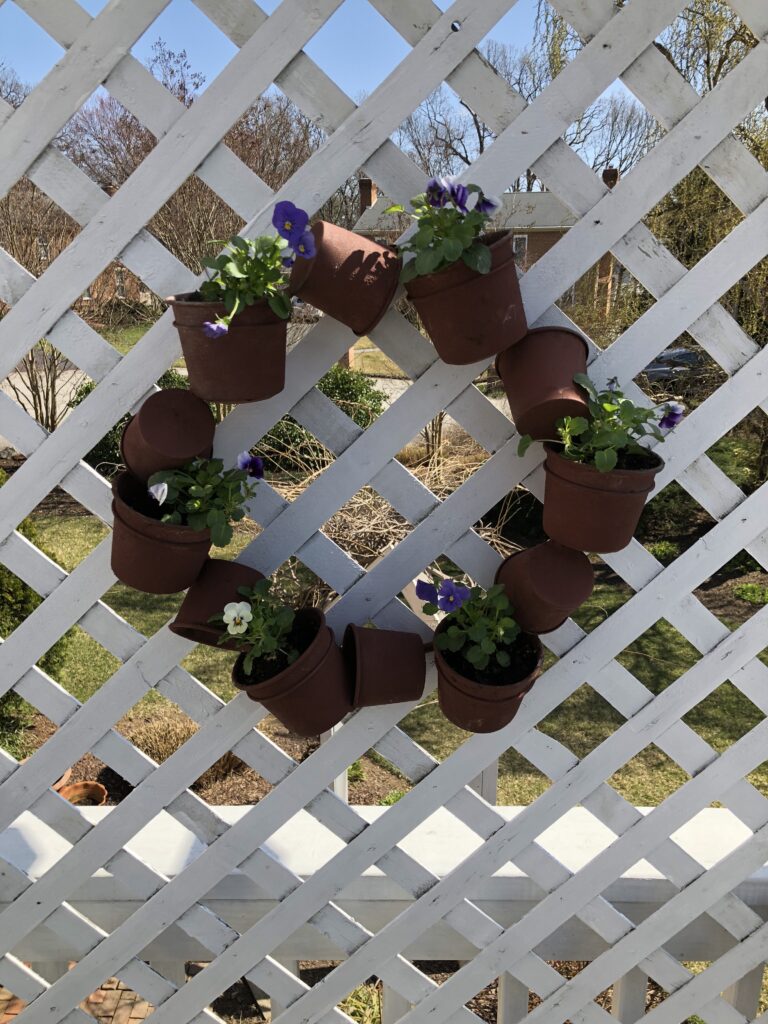
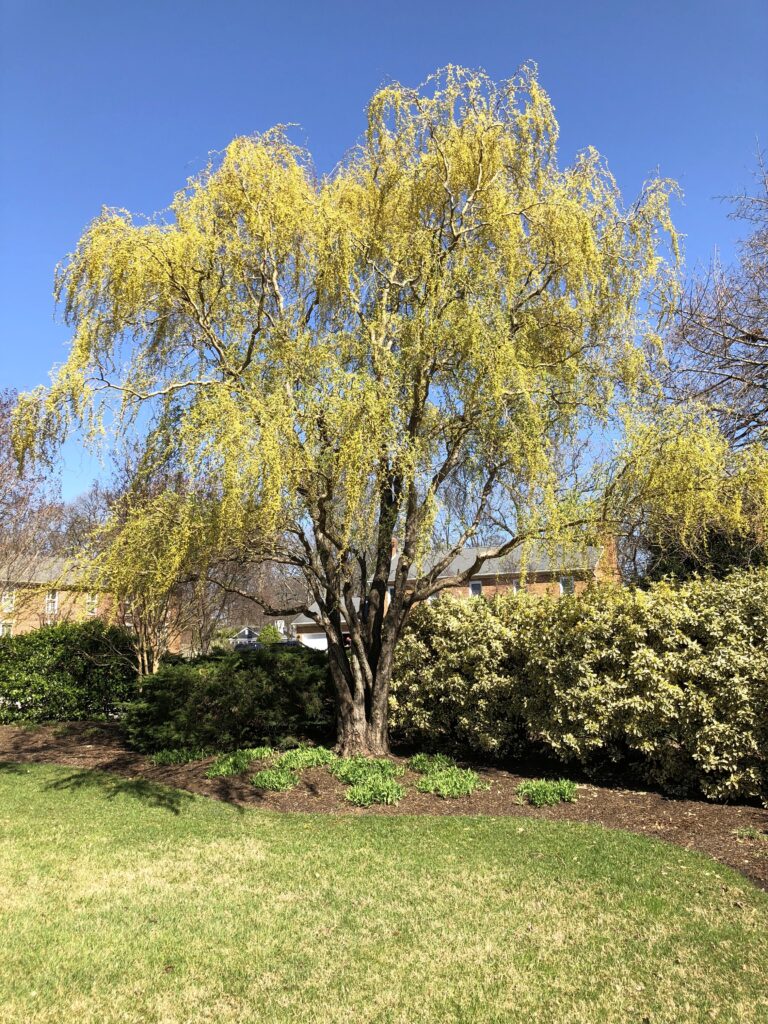
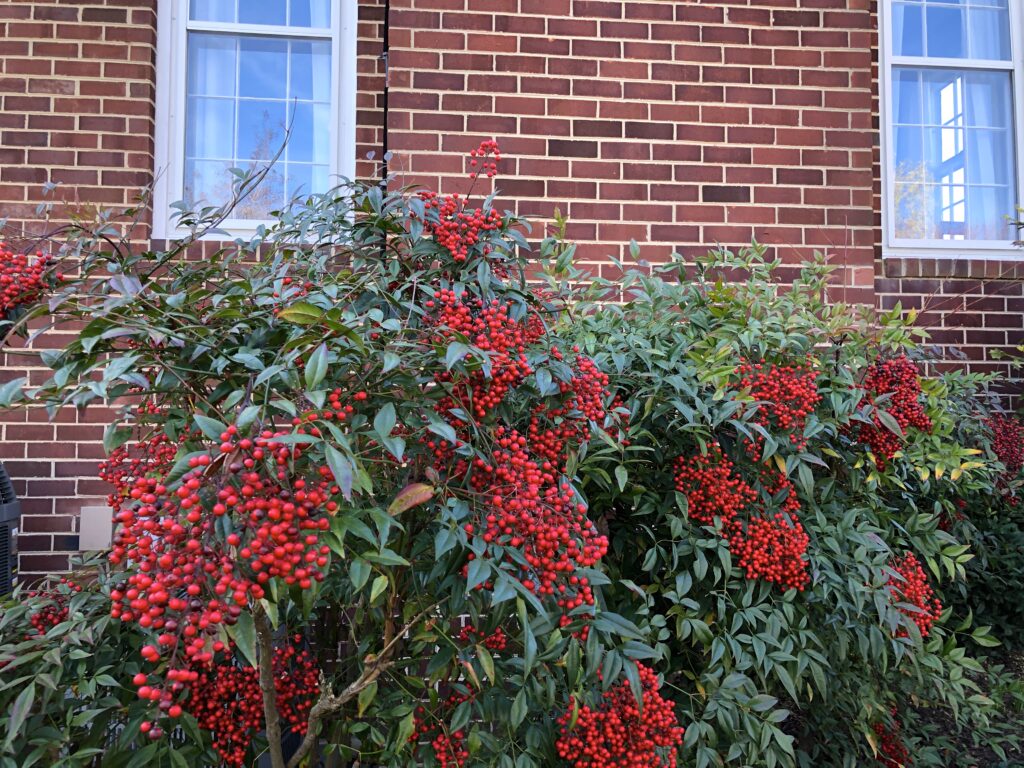
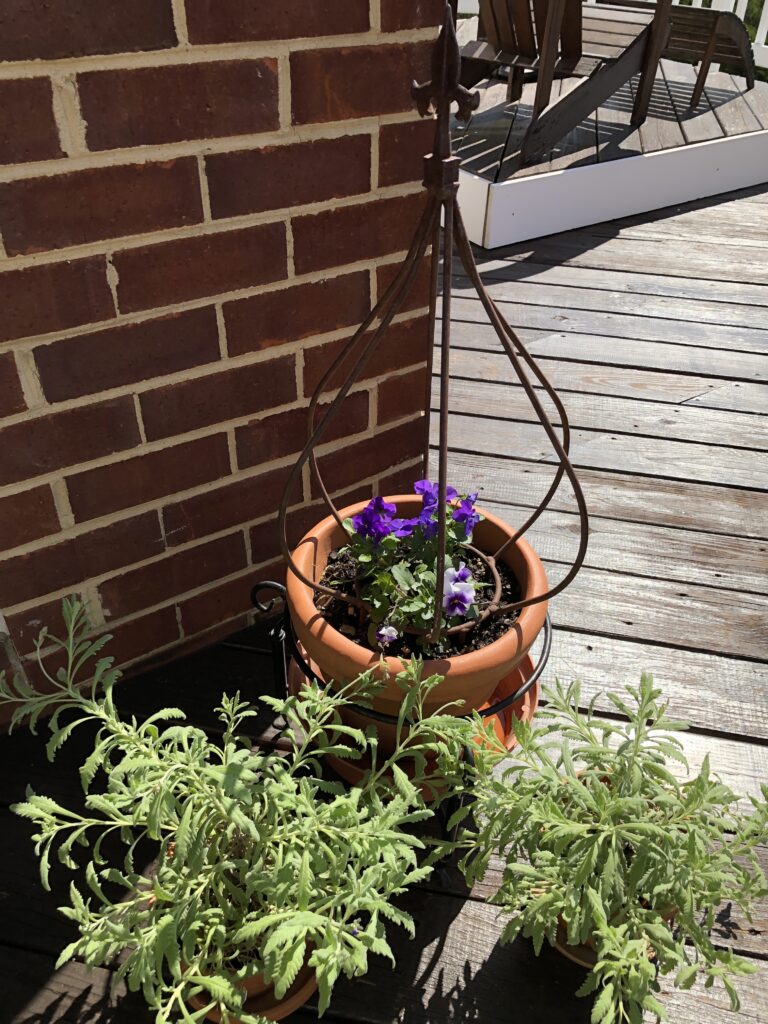
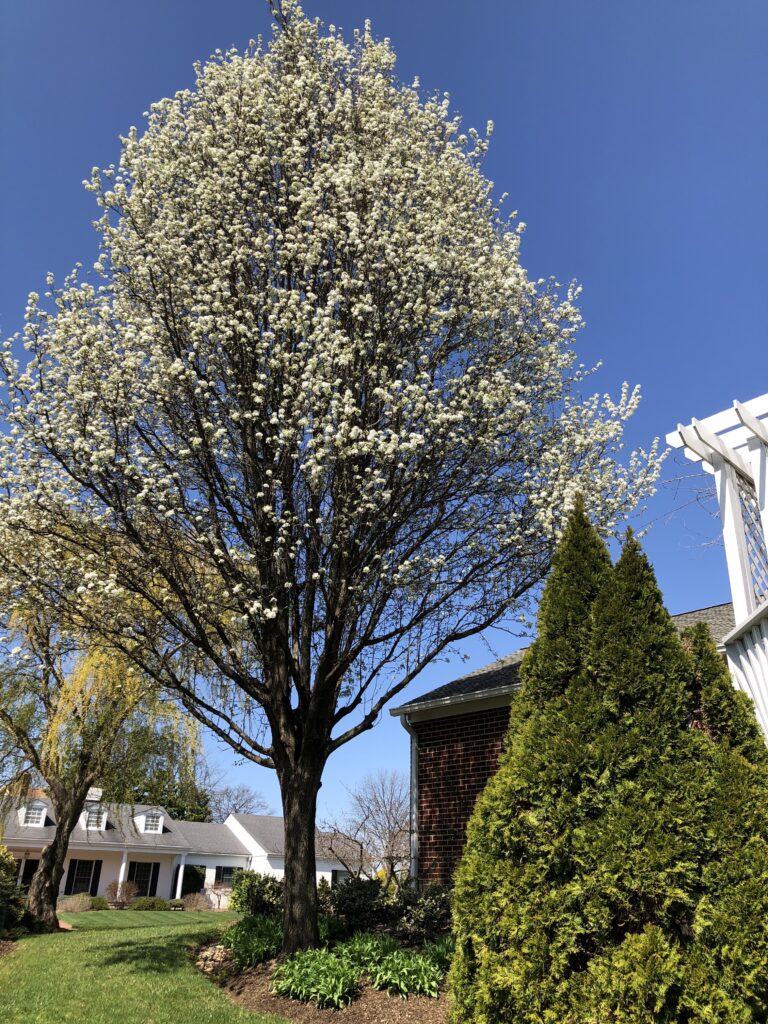

Spring will be here soon!
A Winter’s Day

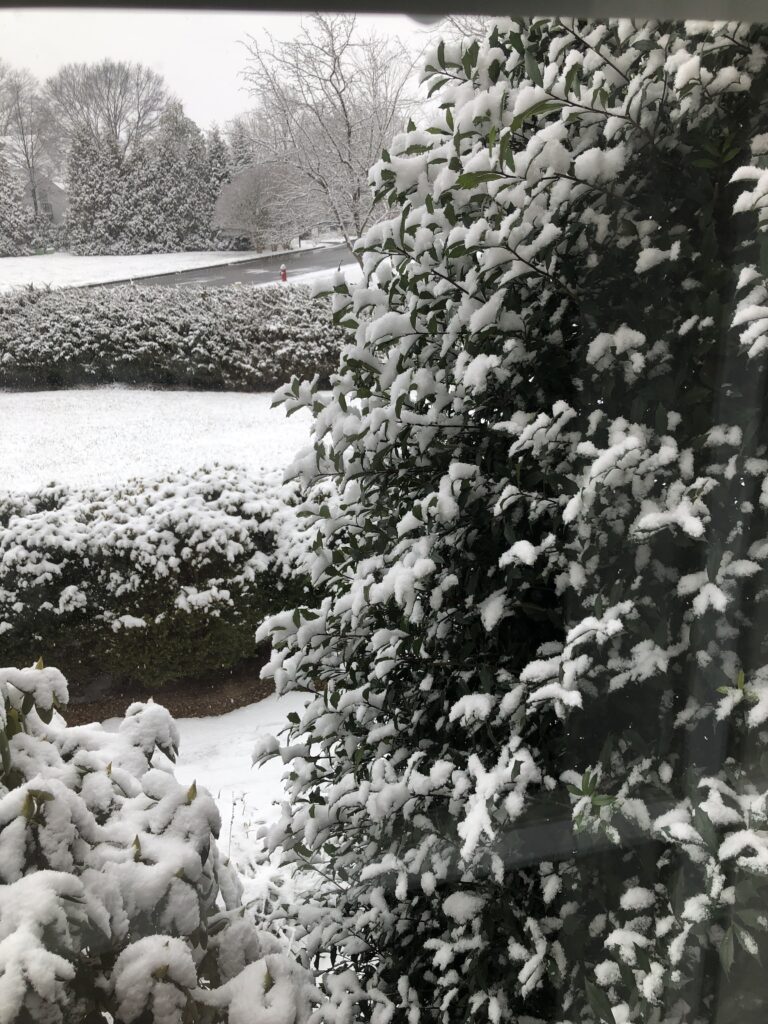
This winter has been long already. We seem to have been getting rain, snow and/or ice almost every other day, oddly interspersed with days close to sixty degrees. On those nice days you know where I’ve been! The garden calls me. I’ve been trying to get a jump on freshening up all the garden beds by getting rid of winter weeds and stirring up the existing mulch, and as luck would have it, the county park at the top of my neighborhood just had a delivery of compost. My favorite! LOL!
I’ve already managed to bring home six car loads to amend the soil. What a difference it makes. In the spring when the grass starts growing again, I will add some additional clippings and stir it all in. This makes the absolutely perfect soil for flowers, veggie gardens, and young foundation transplants. I highly encourage you to check with your local county office and inquire if they also have a compost/mulch program. Some even will deliver to your home for a small fee. Ours here in Fairfax County doesn’t offer that, so I collect my own in large flower pots. They are easy to fill, and not too heavy to carry to wherever I’m spreading it in the garden. A two to three inch layer is perfect. Aside from dressing up the garden and providing nutrients, finely composted leaves stay in place better than the bark mulch on hillsides. So if you have a yard with terrain, it’s perfect.
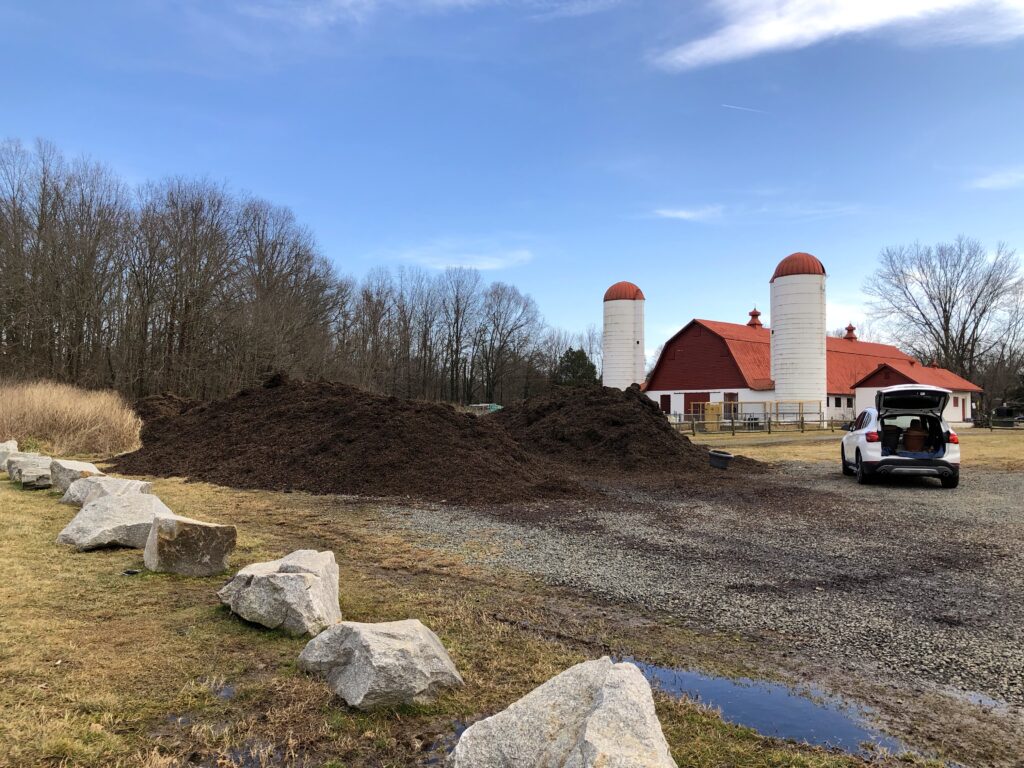
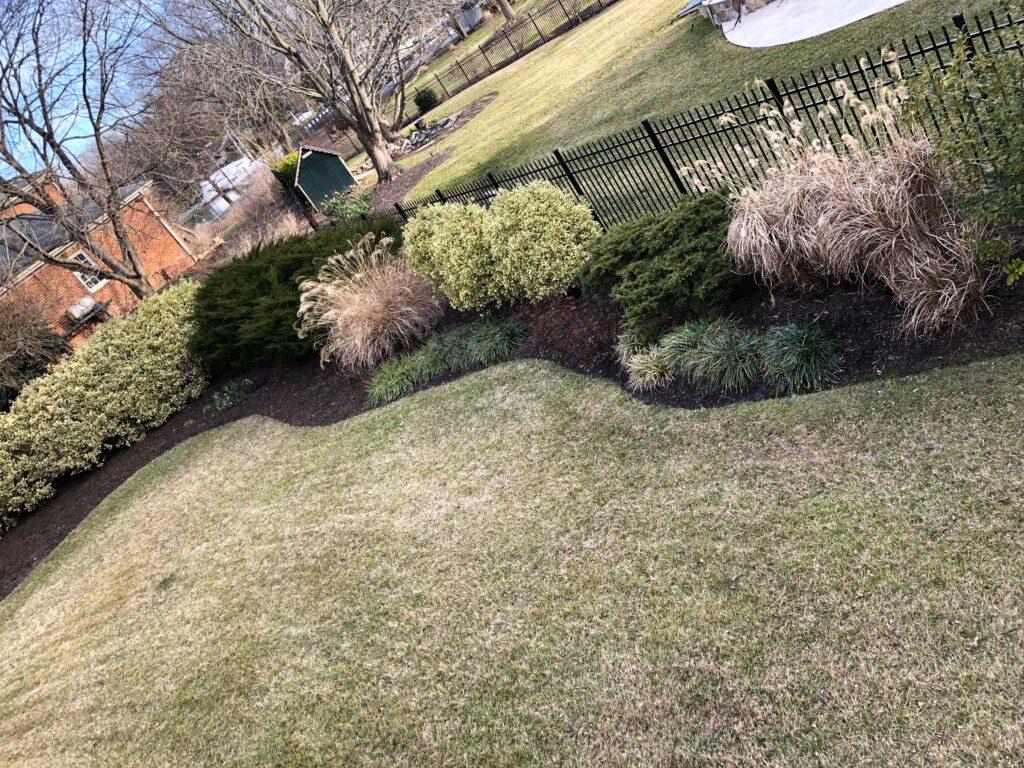
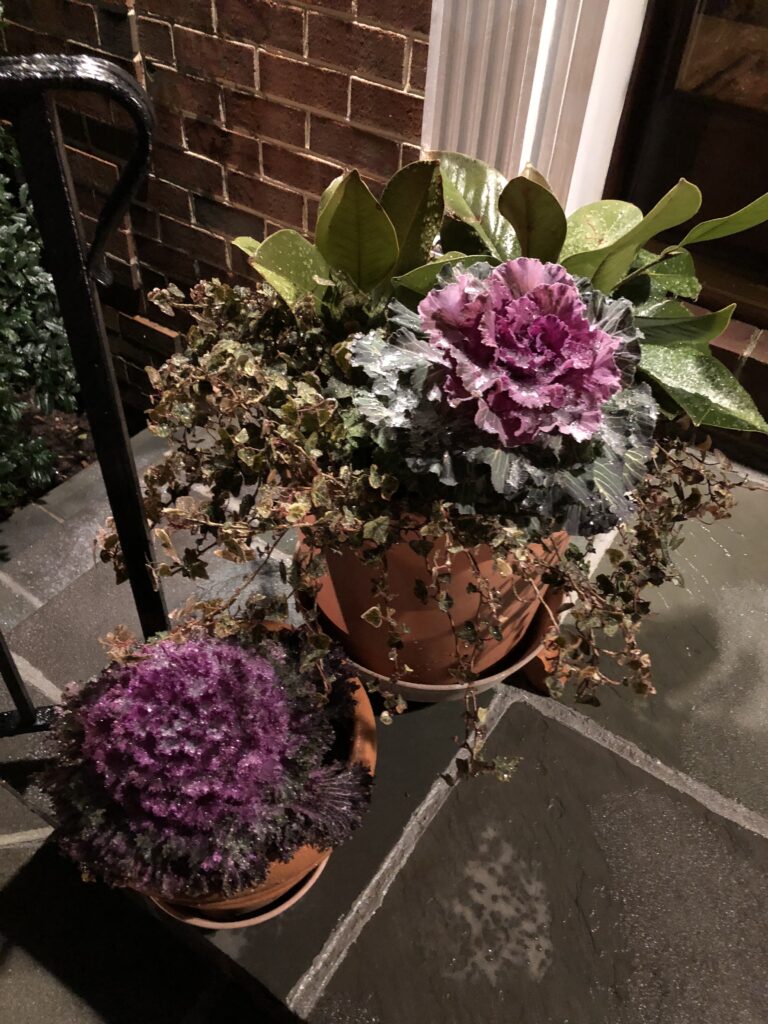
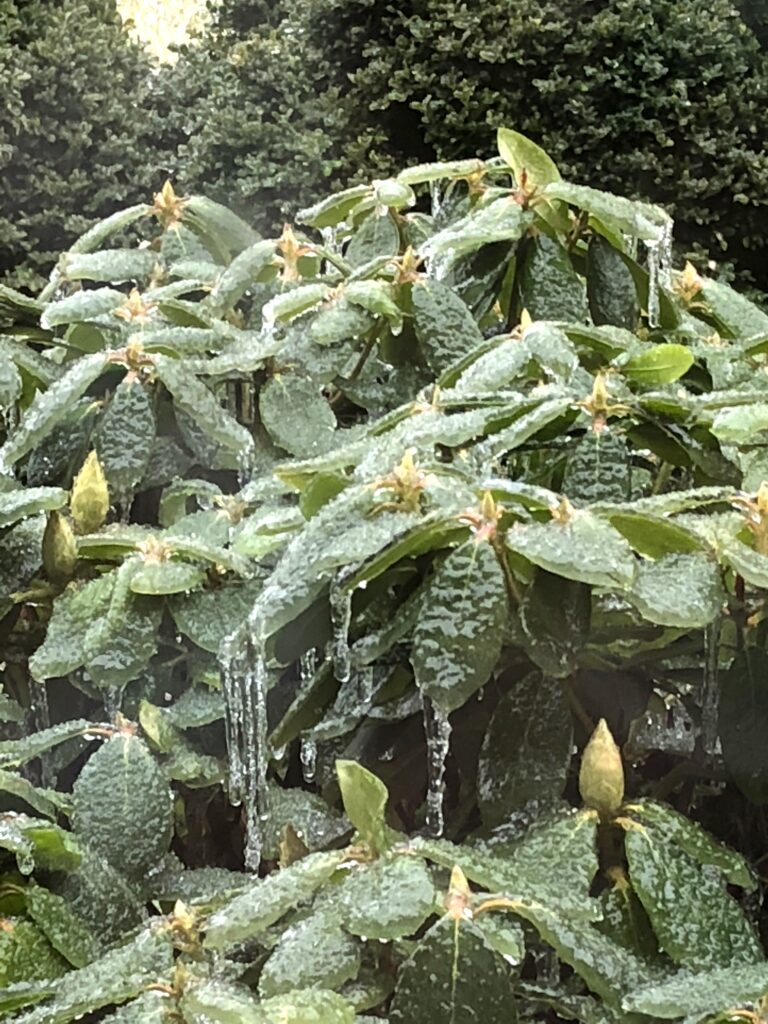
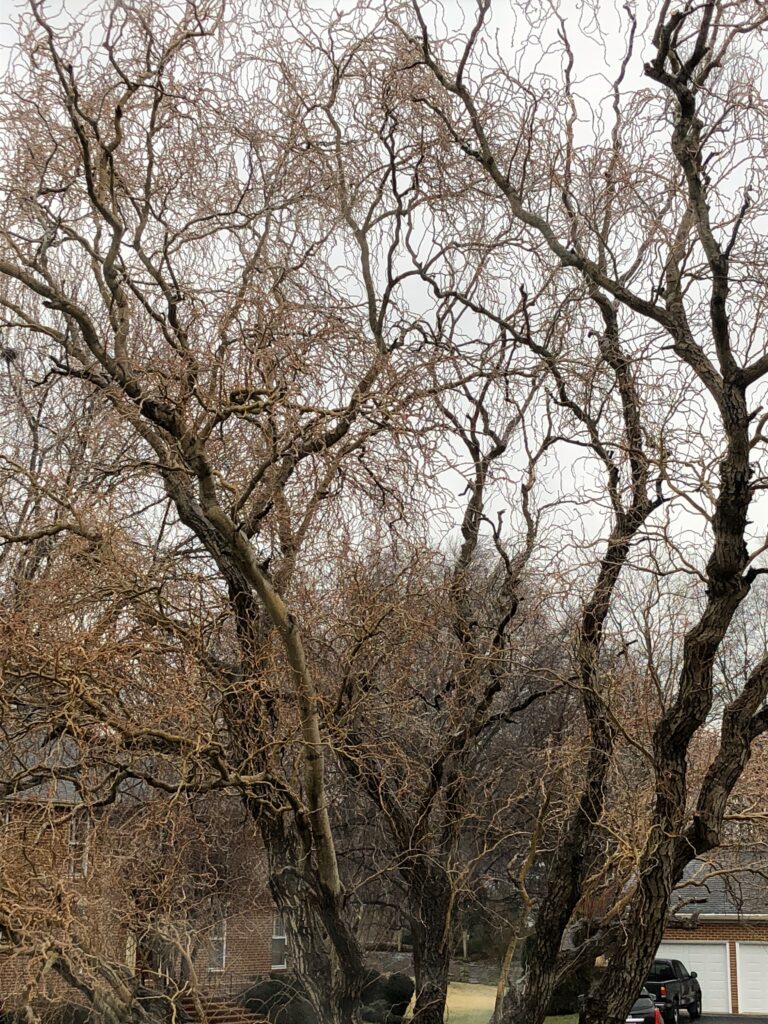
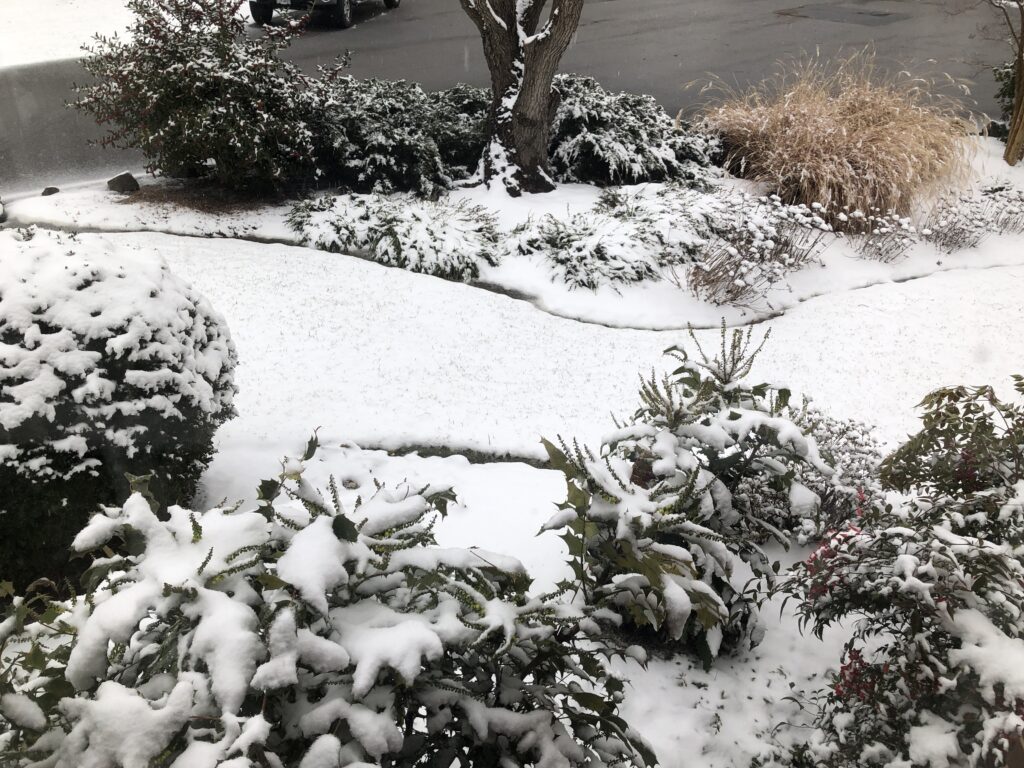

Time for a Fresh Fall Update
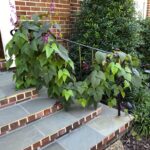
Hello, gardening friends! Are you loving the cooler weather as much as I do? What a change these last couple of weeks have brought. As you probably know by now, I am in love with purple, so I have decided to use lots of it this fall in my decorating.
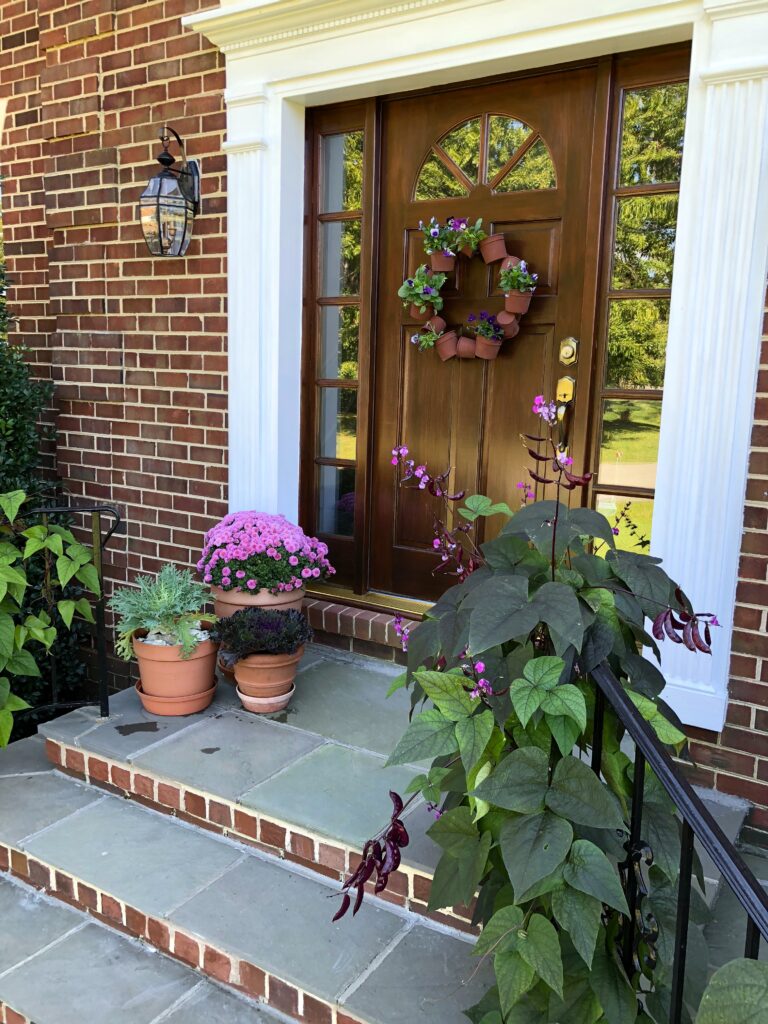
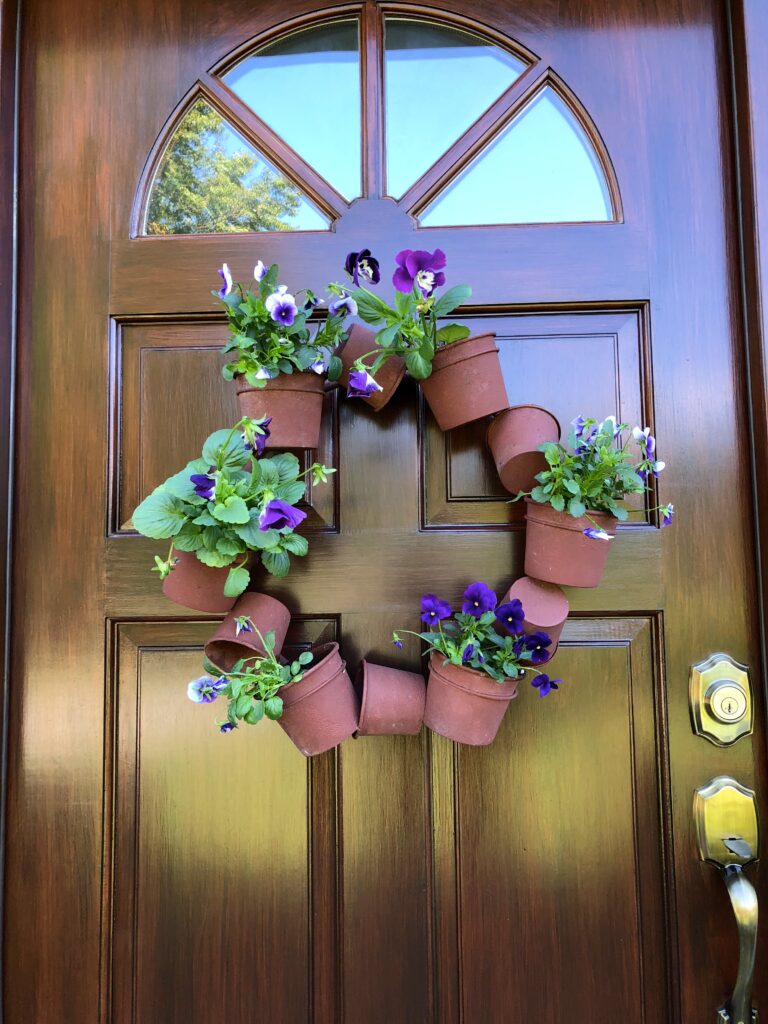
This summer I grew everything from seed. I have to say it was fun but much more labor intensive. This was my pandemic challenge to myself: to see how much I could save by using just what I had. I think the only garden supplies I actually bought this summer was one bag of fertilizer!
I grew lots of vinca and several hyacinth bean vines that I experimented growing in different ways. I’ll share more on that today. I also tried zinnias, which are usually super-easy, yet I failed at that one. I put them outside too soon, and there was a rainstorm which brought on a cold snap, and the whole tray got fungus. Lesson learned to just wait until it’s warmer! Everything else did wonderfully though when I started them a couple of weeks later.
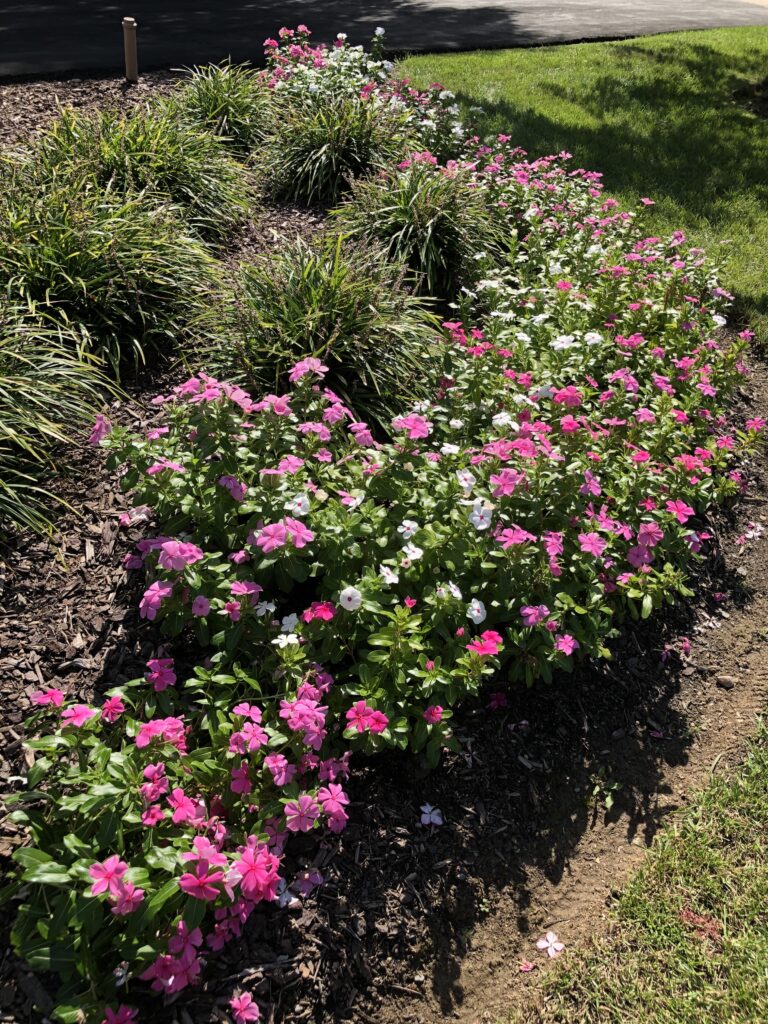
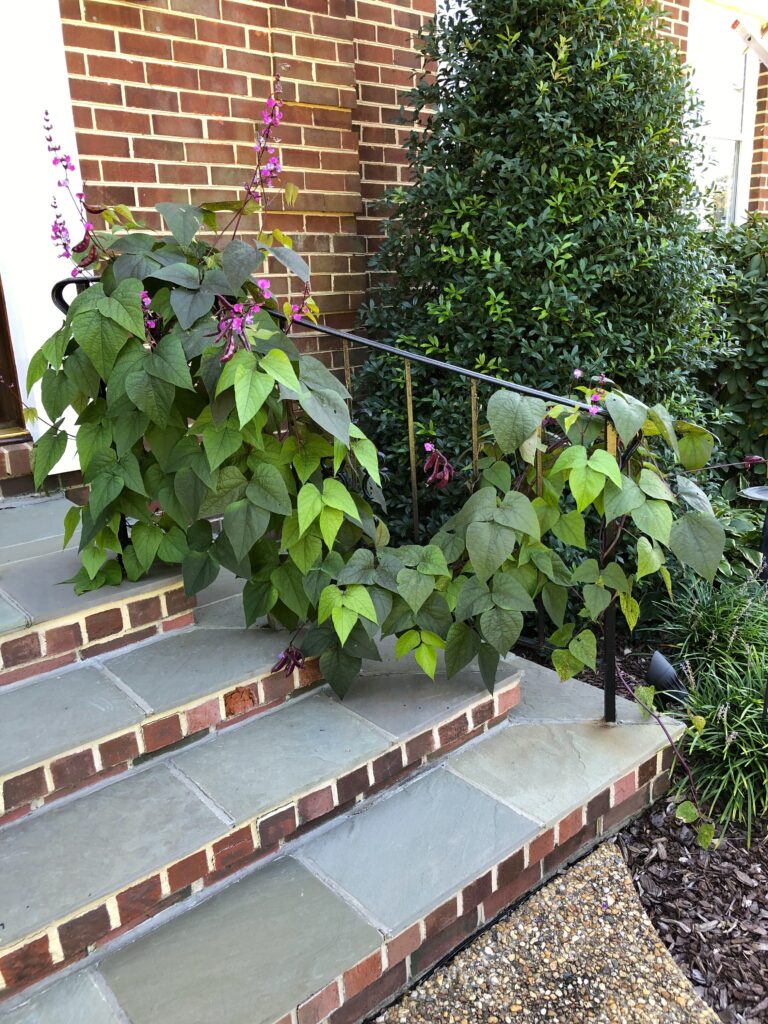

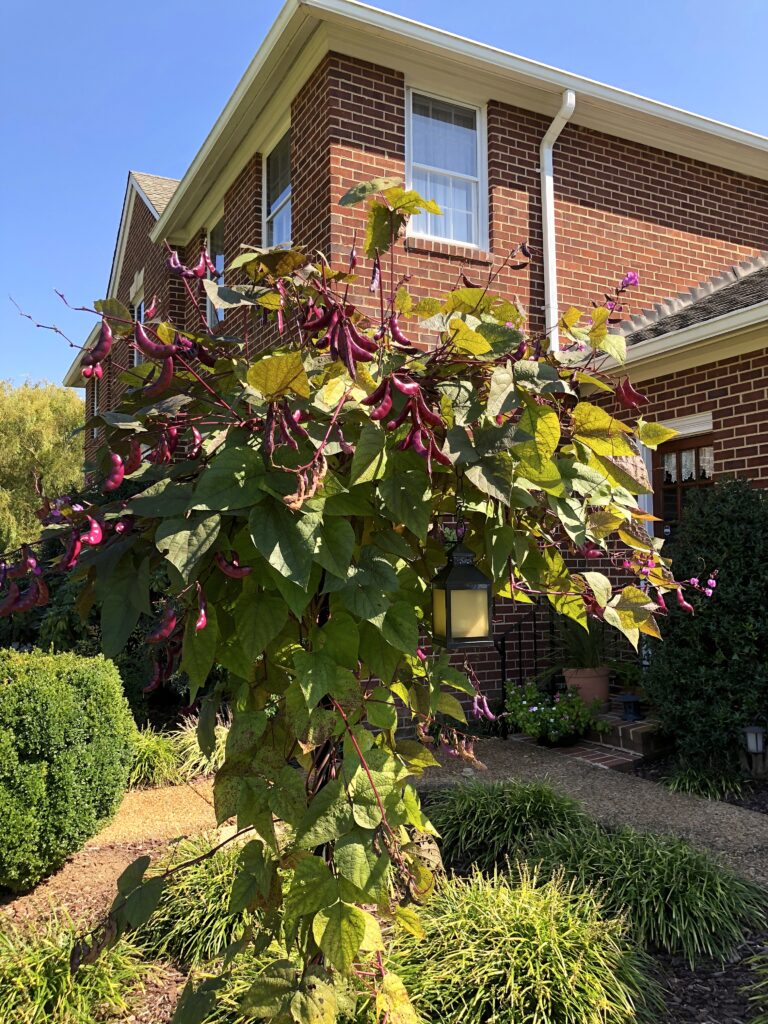

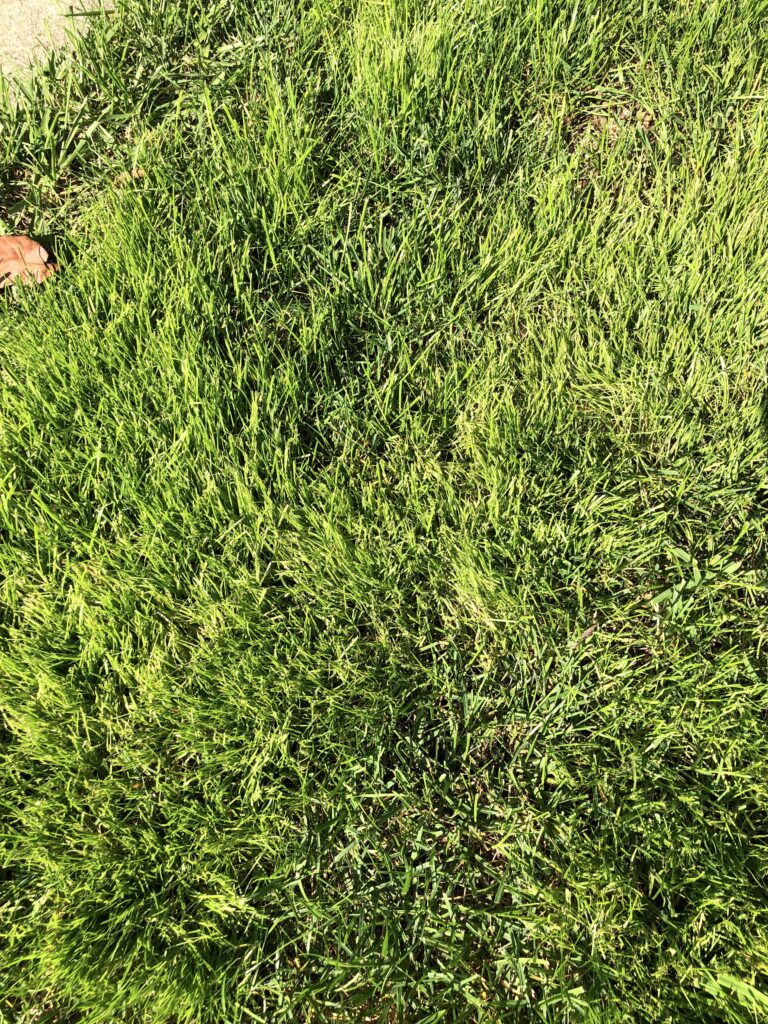
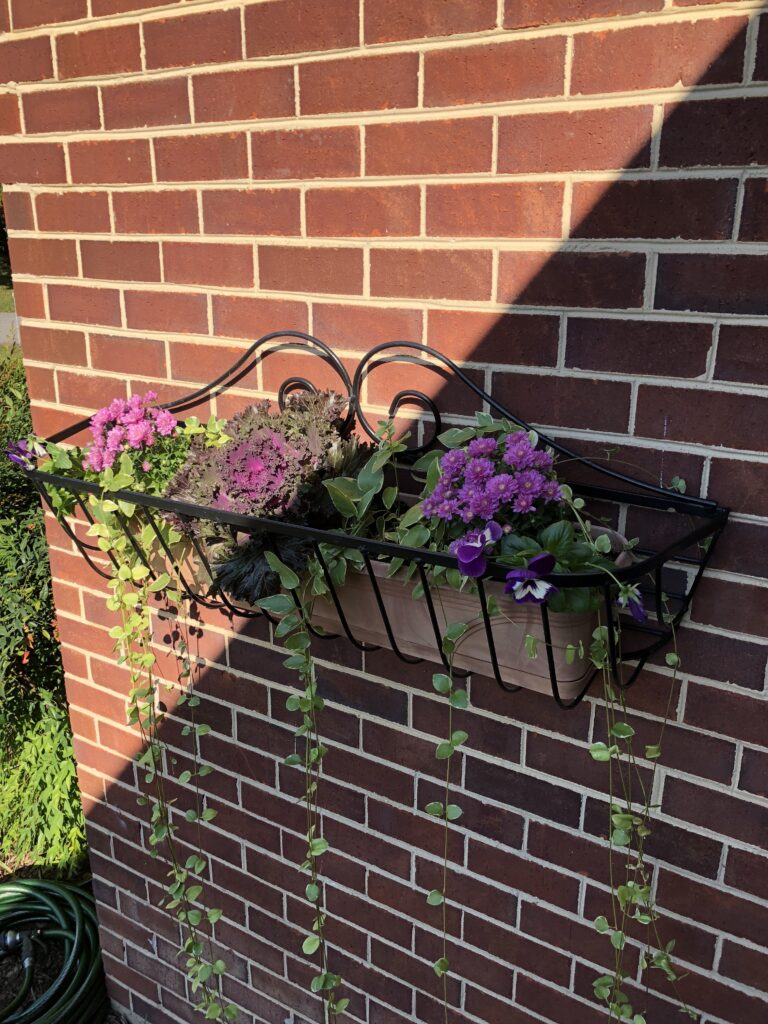
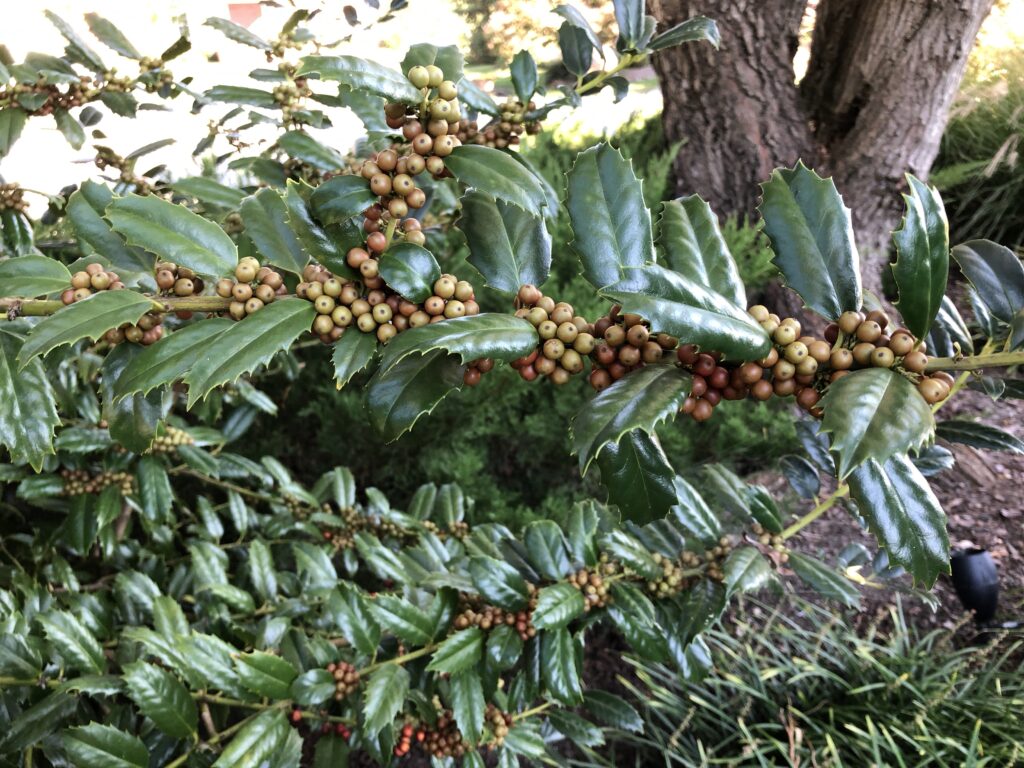
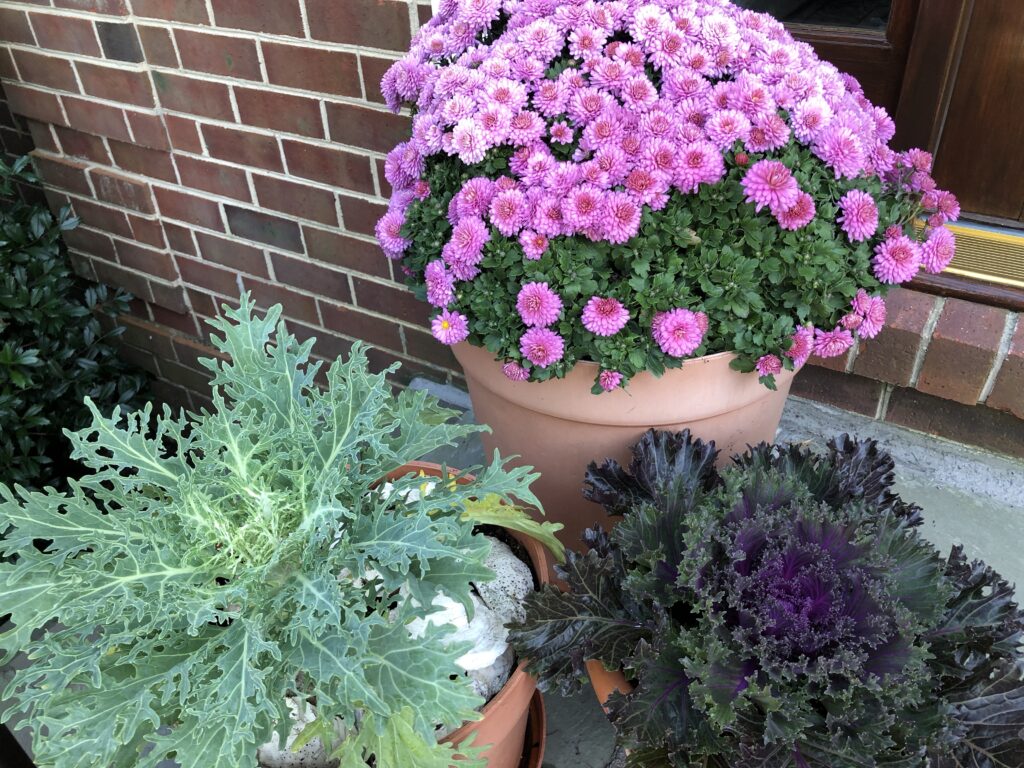
A New Start to 2019
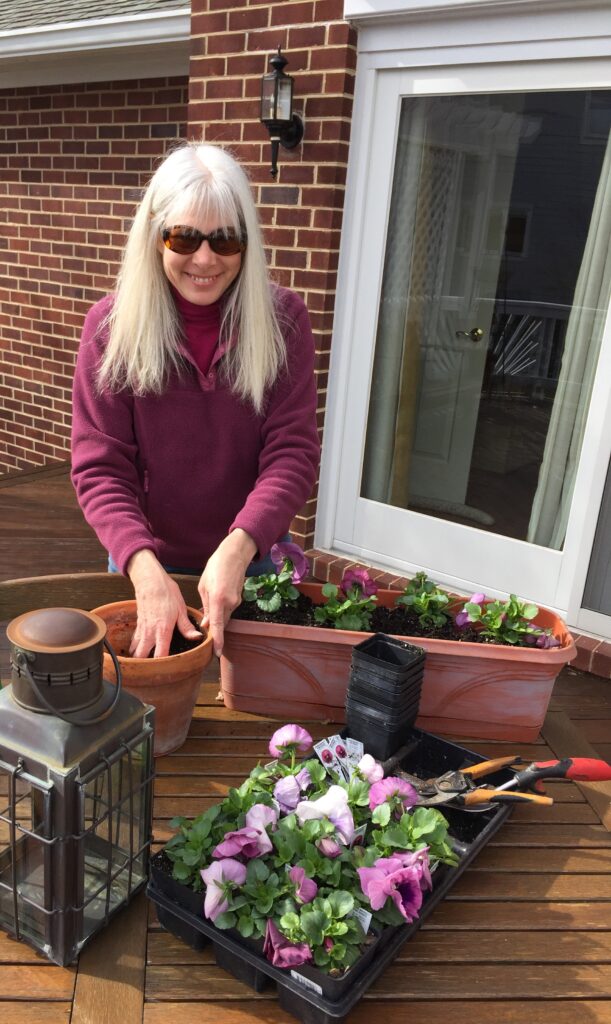
Hello my gardening friends! I have some big news. I am now being hosted by a new company after having way too many technical difficulties with my previous host. I will open comments and questions again and improve this blog with many new ideas. I hope it will be more helpful and encouraging to my readers. So please leave a comment, I’d love to hear from you. (The first time you leave a comment it will go into moderation to make sure you’re not spam, but after that it’s an open forum.) I’d love it if you want to share my posts as well — the more people in discussion, the more tips and ideas! As always, I’ll be here at LisaEarthGirl.com and for those on Facebook at LisaEarthGirl.
As some of you already know, since my mishap last November, falling from a ladder while working on a tree, breaking my ankle and a rib, I had a bit of a slow start to this year. I was very lucky that I didn’t get hurt worse. (Coincidentally it happened on the same day and hour as our esteemed Justice R.B.G. had a mishap and broke her ribs.) I am back physically, thank goodness, and learned to be extra careful on ladders on windy days! I also would like to warn against leaning a ladder on branches that can sway in the wind! Safety first. Best tip I can give!

The cycle of renewal has happened in a big way here. With all the rain that we had over the last year and a half, the garden is lush with new growth. Everything has sprouted with beautiful, fresh new leaves and lots of flowers everywhere. Many trees and bushes bloomed way out of their normal sequence — some early and some late — but it has been a gorgeous month and a half here in the mid-Atlantic. Vibrant colors everywhere!
Here’s a tip for one of America’s favorite plants, the flowering Azalea: When pruning and feeding, wait until after blooming, but finish before the 4th of July. This gives the plant time to set new buds and new growth before the frosts and freezes of the next winter.
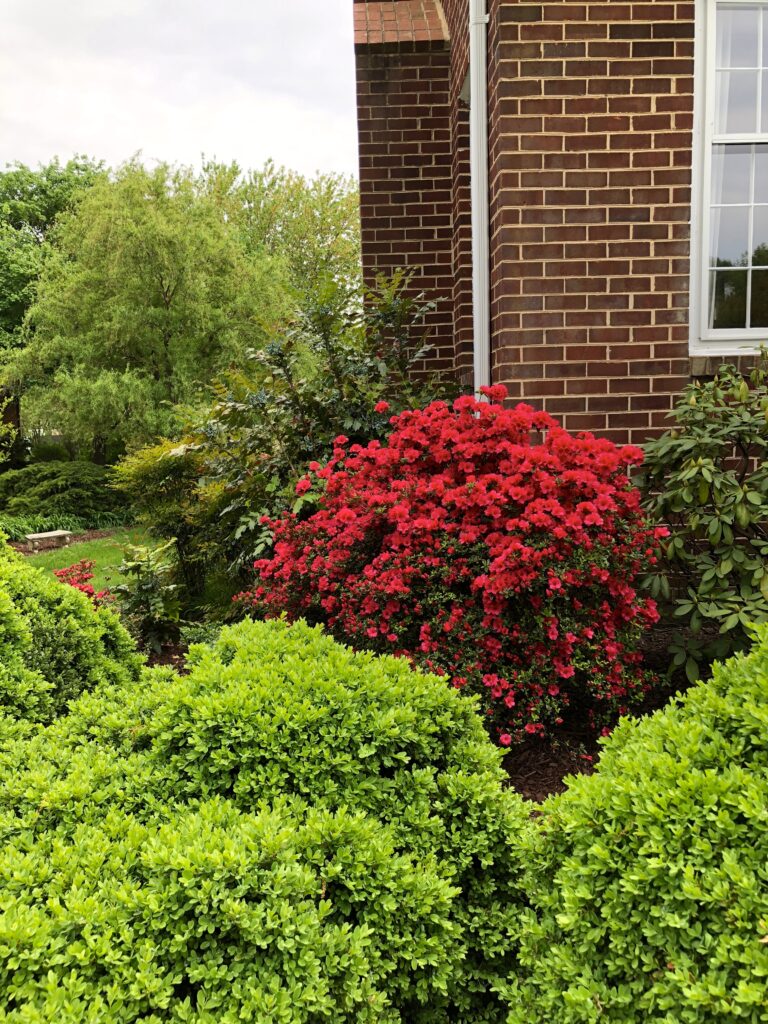
Last week I took a field trip with a friend to one of our local State Parks — Green Spring Gardens. We discovered many gardening ideas, and plants that were in full bloom a full month earlier than their usual bloom time! It was a refreshing way to spend the day, and fun to see school children so interested by what they were seeing. Fun for all ages, really! Why not pack a picnic and enjoy a hike at your local park someday soon?

My biggest gardening concern so far this year is for some of my favorite mature bushes and trees to overcome the amount of rain from last year: the pink honeysuckle bush, the stellar cherry blossom tree, cardinal hollies, and the aristocrat pear. Last year’s losses were two prized cyprus bushes that drowned along the fence border garden. The change in climate and a neighbor’s poor drainage have proven deadly. The challenge continues with attempts to combat the excess water. I’ll keep you posted with some remedies to help keep the excess water away.
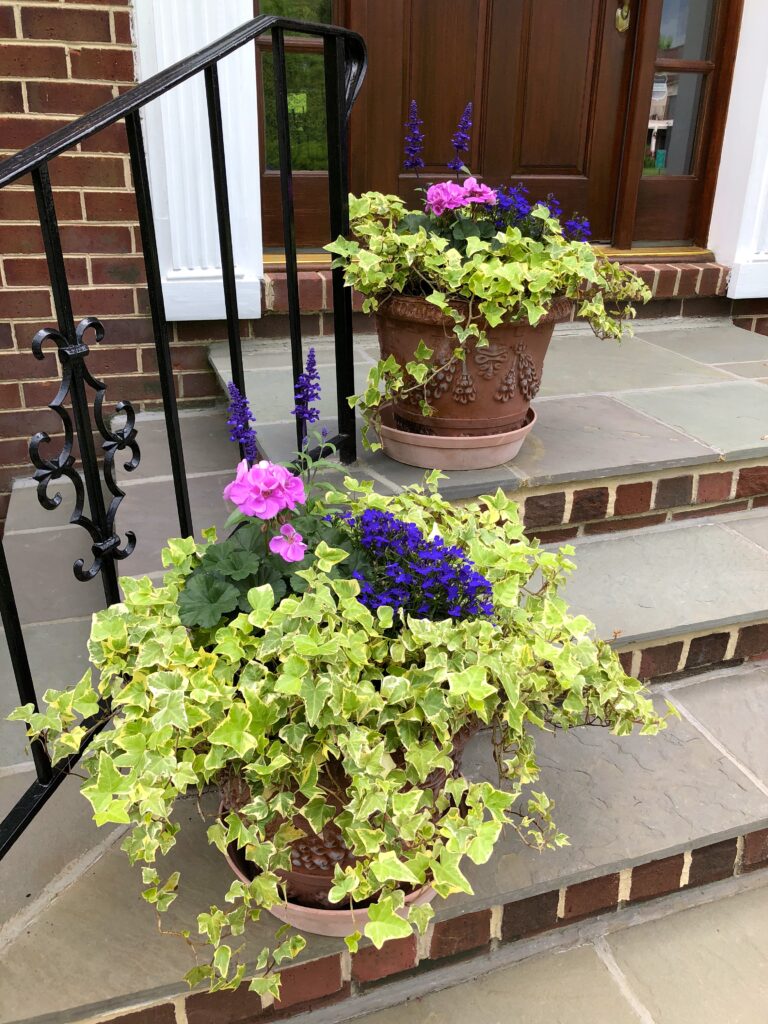
I always like to echo the colors I already have in the garden in my flower pots by the entrance. This year’s choices are blue salvia, lavander geraniums, and purple lobelia surrounded by variegated ivy. These all do very well in this area.
I’m back in my own garden now, preparing for the season ahead. I’ve almost finished with the mulching, weeding, and trimming back perennials. The grass has turned green again, and that alone makes a great backdrop for everything else. To celebrate the beautiful weather, I planted my annual flowers last week in flower pots and areas that are protected close to the house. In past years we have still had the odd late frost, but this year the long range forecast is showing we are much warmer. I used some of my favorites that do well in my micro climate on the banks of the Potomac — vinca, impatiens, salvia, lobelia and geraniums.
I’d like to start up a new segment on each blog from now on on plant I.D.- I’ll start with one that stumped me for years. I’ll encourage others to join in with plants from your garden.

It’s good to finally be back, and I hope that everyone is out and enjoying their corner of the world. Happy Gardening!
Goodbye 2018, Hello 2019
Lawn Renovation Even in Sauna Weather – Got to Get it Done!
Hi everyone! We had an unbelievable amount of rain here this year, almost double our annual rainfall total. The air feels like a sauna even in October. It’s been hard to spend more than a few hours outside at a time in the heat and humidity — but you know I can’t stay inside, and there’s work to be done!
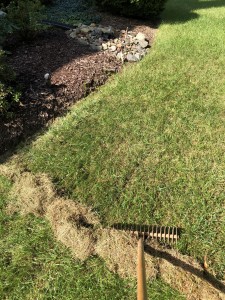
This type of steel rake is my favorite choice for de-thatching and preparing the soil for overseeding. Just look how much debris it removes!
My priority now is renovating the lawn. Normally, I would finish this completely in September, but the weather has put me behind schedule. To do this right, I started by weeding the entire lawn by hand, as opposed to using an herbicide. When planning to overseed, one needs to make sure not to have any chemicals on the lawn which could interfere with the new seed sprouting.
I am using a specialized steel rake to get every bit of thatch out of the lawn — a tool I inherited from my grandfather. This is THE most grueling step. After de-thatching two-thirds of the lawn, I have collected more than a dozen full bags of debris (don’t worry — you know it’s going to the compost heap). I’m impressed with how effectively this steel rake pulls out the thatch — and it loosens the surface, which makes for great new seed contact into the top soil.
Everyone who walks by while I’m working asks me why I don’t just use a machine for this, but if you saw how much better this works you’d know why!
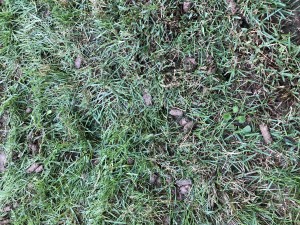
This is what those plugging machines do. They really don’t get any thatch up, and compared to my steel rake — well, there is no comparison, not to mention that the plugs of soil the machines leaves behind look like, um, something else we don’t really want to see…
I bought a premium seed that has a variety of grass types: some that sprout within a week to stabilize the bare spots, and additional varieties that will be sprouting over the next few. This mix also had a seed-starting fertilizer mixed in, but if the variety you purchase doesn’t have this, I’d recommend using some.
Keeping things moist while the seeds are doing their magic is key, but with all the rain we’ve had, I’ve only had to water the new seed a few times.
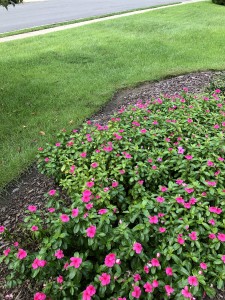
With the combination of sod, seed and fertilizer you can hardly see where the old tree stumps used to be!
I’m happy to say that I finally was able to easily pull out the last of the roots from two pear trees which used to grace the front yard. Now those areas are much smoother in elevation. The vast majority of the surface roots came out with the tree, but a few deep ones remained. On these areas, which were quite large, I used a couple of pieces of sod and more seed around the edges to completely fill it in. Now you’d never know that those were trouble spots!
Once the new seed reaches three inches tall, you can start mowing. We gave our newly-seeded lawn its first mow this week. I have a tip for this, too: Set your mower to highest level first, because after a few weeks of not mowing, the existing grass will definitely be quite long and would clog the bagging chute. In a couple of days, set your mower to the normal level and cut it again. This way your lawn won’t be stressed as much — and you won’t create new thatch by using a clogged mower!
I’m hoping the weather will cooperate so I can finish up my raking this week, but (if you can believe it) we have a new hurricane bearing down tomorrow night, and two more in the Atlantic pipeline. Hope everyone stays safe, and best of luck — I’ll be back with some pretty fall flowers next week!
Front Garden Renovation – Adding Curb Appeal

Here is the “before” photo of the front entrance garden. I want to fill in the area between the boxwoods with a seating area that will soften the straight edge of the walkway by adding curves.
Long ago, when I first designed the front yard of our house, I left a 15 foot wide gap between the boxwood bushes that wrap the front of the house. This was supposed to be very temporary. My intent was to change the path of the front walkway and bring it up the middle of the lawn instead of from the driveway on the side. Well, as years slipped by, I have had much more pressing projects. The front pathway took a back seat, but it’s time to get started with a new plan. I’ve changed my mind on moving the location of the walkway for now, but I still want to soften up the existing straight line of the boxwood garden. To improve curb appeal, I added some seating and space for seasonal color by the front entrance. I’ll show you how I went about it, step by step.

First, I laid out a long rope to define where I wanted to expand the edge of the garden bed and marked the new edge with landscape paint. Then, the hard part — cutting the edge with a scallop edger, and turning all the turf over with a rounded shovel. This is back breaking work, but I prefer this to a cultivator — you have far less grass growing back up, almost none! You can see already how the curvy edge softens up the row of boxwoods.
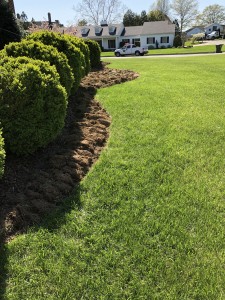
Here’s another angle from the side that shows the new edge. Once it had rested for a few days, I broke up the shovelfuls of turf to smooth it out. Over time the turned grass will degrade, providing nutrients for the new garden area.

Here is the “after” shot: I added stone benches, transplanted pachysandra and annuals, and finished it out with a nice topping of mulch. You already hardly notice the straight line of the walkway. I’m planning to add some flagstone pieces to the side bordering the walkway and fill in with more pachysandra between the stones in the fall when the weather is cooler. Until then, I’m happy with the progress, and the more welcoming look!
I’m not quite finished with it, but already I’m much happier with the amped-up curb appeal, and a new place to sit in the garden. I’ll post another photo in the fall when I add some flagstone pieces to transition from the walkway to the benches. I’ll transplant more ground cover to fill it in when the weather cools off. Hope you all have a safe and wonderful 4th of July! Happy gardening!
Fun Summer Projects – Trash to Treasure
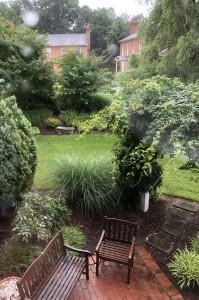
Welcome to our tropical rain forest! We’ve had so much rain here that working in the garden can’t happen, so I’m working on some fun projects in the meantime-
Happy Summer everyone! Trash to treasure is one of my favorite pastimes. I’ve been busy doing a few fun summer projects and want to share them with you. We’ve had a lot of rain here in the mid-Atlantic region, so as it’s been too wet to work the garden, I’ve been working on these projects between the storms.
Recently I was given some old Adirondack chairs with ottomans that a neighbor no longer wanted. They had sat in the woods for years and had gotten covered in sap, bugs, pollen, mud, algae and who knows what else. They were in pretty rough shape, but I scoured them down, power washed them twice, and finally brought out the palm sander and managed to get through all the grunge. It was quite a job, but I was determined to make them beautiful again. A few coats of my favorite stain and sealer later, and now they are fantastic! I moved them up onto the deck, and now they make a great spot to sit and relax or maybe even whale watch! Trash to treasure, for sure!
Also on the deck, I moved the teak dining table over to the arbor. I came up with a really fun and simple idea to create an outdoor chandelier above it. These were all things that I had, but easy to find at most garden centers. I took a wrought iron plant hanger and attached it to the center support post of the arbor, then with a few links of metal chain hung a garden orb. Inside the orb I hung a candle lantern. It makes a great chandelier, and no wiring necessary!
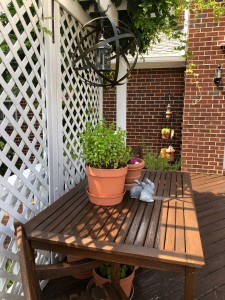
An easy chandelier made with a plant hanger, some chain, a candle lantern and a garden orb — no electricity needed!
These were fun projects. Don’t be afraid to roll up your sleeves and apply some elbow grease — restoring old furniture is very rewarding. The chandelier project was very easy, and it will be nice to enjoy a meal underneath! Hope you’ll give them a try…
Spring 2018: I’m back – thank you for waiting!
Hi all! It’s been a looong while since I’ve written a blog, and I have lots of catching up to do and some explaining as well. It seems that this entire last year has been a mess of frustration with construction and neighbors. Every one of the homes on my street has had multiple pieces of huge equipment visit for weeks on end, causing all kinds of mayhem and thoughtless behavior, making it impossible to get a worthy photo for my blog. So thank you all for putting up with my absence for so long. I will do my best to show you what I’ve been up to lately…

HUGE equipment parked all around my property 7 days a week, all year, definitely doesn’t make for a pretty photo.

Thoughtless contractors and neighbors dumped illegal chemicals and detritus. Storm water management officials to the rescue. They explain to the offenders the right way to dispose chemicals, so that they don’t impose a health risk to the environment. Thank you beyond measure!

Since I couldn’t work outside, I completed projects inside. I refinished the flooring on the main level. This is actually a deck finish! The nice thing about it is that it has UV blockers, and very little odor. We also re-tiled two bathrooms and updated the kitchen appliances.
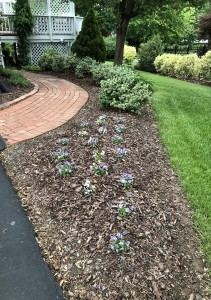
Last fall I worked on repairing some of the damage to what used to be a beautiful view. I carefully transplanted 17 large bushes, and when spring came I was thrilled to see that they all survived the winter and are looking healthy.
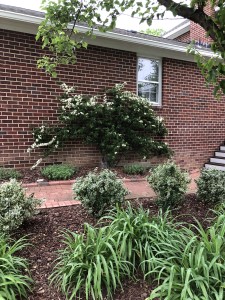
It was touch and go for the last couple of years with this pyracantha. It had one issue after another — fungus killed half of it, then scale, whitefly, and powdery mildew all took a great toll. After radically pruning and treating it with horticultural oil, and then spraying it with a mixture of milk and water, it is now a picture of health! These are all earth friendly remedies. So glad for small miracles!
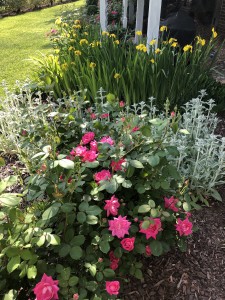
There were some beautiful moments last week when the sun popped out. The flowers all opened up on the same day! After such a nasty winter, I can’t begin to say how much I appreciated it! Each morning I add the coffee grounds to the base of a different plant to provide some natural feeding. By the end of the year, I’ve made it all around the garden. The plants love it!

The violas and pansies are having their last hurrah during this needed rain. I’m ready to be back out in the garden and already have some more projects underway to show you next time. Here’s hoping for some peace and quiet to return to this neighborhood and for some lovely time outside.
Happy Easter, Happy Gardening!
The Weather Outside is Frightful — Time for Some Indoor Gardening!
I’m ready for some nicer days — aren’t you? 2018 has been unusually frigid and foggy, wildly windy, and with sudden, crazy temperature swings. It makes me crave some tropical — or at least milder — springtime weather. Not to be had just yet, so until then, I’m doing some gardening indoors.
I’m always on the lookout for interesting new houseplants and couldn’t resist this one. It’s a weeping pussy willow, grafted onto a standard willow trunk. There is a legend that goes along with it: If you tie a loose knot in a trailing willow branch and then make a wish, the wish will come true. You then untie the knot and thank the tree, and it will grant you more wishes in the future. Well, I could use some of that! I’ll tell you if it works!
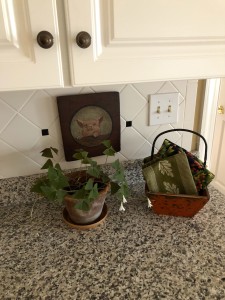
Another great low-light plant is the shamrock. This shamrock is starting to bloom again. I guess it knows that St. Patrick’s Day is almost here!
The peace lily and the shamrock also are starting to bloom. I’ve had both of these for a number of years and highly recommend them for low-light areas. Mine are both in need of re-potting in larger containers, but I’ll wait until the blooms fade. A good rule of thumb is to use the next size up in pots, and March is a perfect time to re-pot a houseplant.
I’m waiting on some orchid plants to come back into bloom and decided to do something fun with them — I made an orchid garden to use as a centerpiece in the dining room.
If you want to try to make one of your own, here’s how: I took a huge punch bowl and lined it with floral foam (mine took four bricks of floral foam). I then added the real orchids (still in their pots) into the punch bowl around the outside rim. (So they can be popped out easily to water and put back in.) With the space that was left, I added faux orchids (I used 9 stems/sprays), and filled in with pine cones to cover any remaining visible floral foam or open spots. (You could also use moss, or shells, or anything you like for this step.) Bunching them all together garden style like this creates a statement piece with lots of impact. It’s so tropical-looking — just what I was going for! It makes me feel like I’m in a Victorian greenhouse when I look at it — a real plus for these chilly days. This could be done with any flowers or greenery that makes you happy, so I hope you’ll give it a try. Good cure for the winter blahs!
Happy Fall-
2017 Flower Show
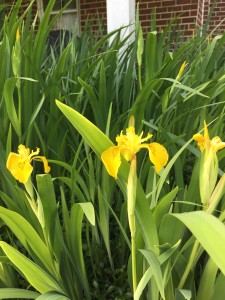
The yellow flag iris was almost glowing and has increased to nearly six feet in diameter. When the flowers dry up you can trim out the flower stalks for aesthetic reasons, but the leaves should be left to absorb nutrients for next year’s crop of flowers. I love this variety because the foliage stays absolutely beautiful until frost in the autumn.
This has been a crazy couple of weeks: the street was milled and repaved, and major renovations have been going on inside the house. So, the garden again proves to be my escape.
Well, it’s not quite the Chelsea Flower Show, but I have to say this year’s flowers have been gorgeous so far!
I will be a bit sad to see this season pass and have to wait another year to see these beauties again, so I’m creating my own 2017 Flower Show in pictures to revisit. I hope everyone has been enjoying their own gardens this year! Here are some highlights from mine…
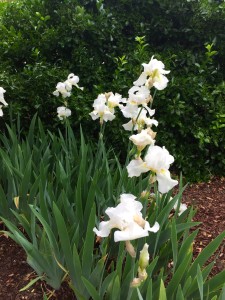
Never to be outdone, the always beautiful white iris bloomed early this year, with some of the blooms reaching eight inches in diameter!

I can’t say enough about how much I love these peonies. These were a gift, and this was the first year that I have grown them, and they are quickly becoming my favorite spring flower. They lasted more than a week in a vase, looking pristine after cutting them and bringing them inside!
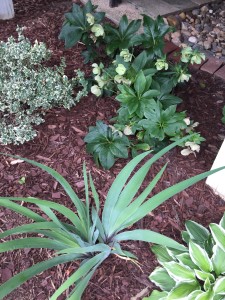
These hellebores are amazing. They have been blooming non-stop for months! The color is wonderful — a slightly greenish-white with pink edges to the petals. They are quite graceful and getting more and more blossoms. They like mostly shade with just a little filtered sun.
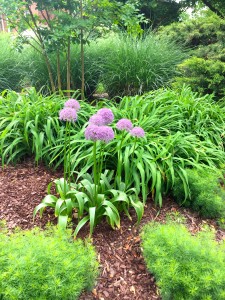
The alliums were really multiplying this year, from 4 to 10! I love the shade of purple. For those of you who dry flowers, these dry very well! I will soon cut them and hang upside down to dry. They are so pretty stuffed into a Christmas tree during the holidays — looks like a star burst!
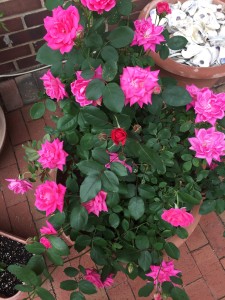
The roses have been just loaded with blooms — until now — the rain did them in. But, new blooms are forming and it won’t be long until they look like this again. Those with a sharp eye will see that my rose has a deep red rose blooming right in the center. This is because most new rose varieties are grafted onto hardy old fashioned rose root stock, which can sometimes send out shoots and bloom. I think it’s beautiful to have the mix of color — but keep them managed or the shoots can take over!
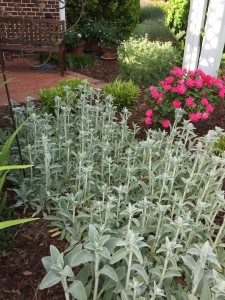
The lamb’s ears is at its peak, and will will look great the rest of the summer. I love how its greenish white color makes the roses pop. Behind the rose the yarrow is starting to bloom. Yarrow is also a flower I love to grow for drying purposes.

This is the view out the french doors by my desk. I love to see everything with such full spring growth, the sense of renewal does my heart good!
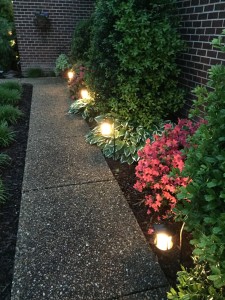
In the evening light the azaleas shine along the front pathway. The pathway lights are low voltage and easy to install, and what a difference they make in the curb appeal!
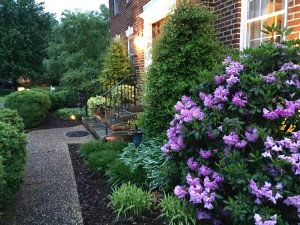
As the sun sets and the lights come on, I think it’s a magical time of day. It brings out the vibrant color on the rhododendren. I have been mixing my coffee grounds into the soil around the dripline of all of these acid loving plants, and the number of blooms this year is a testament to how much they like it. Great way to recycle the coffee grounds, too. Hope your spring has been full of flowers — they do wonders for your happiness!
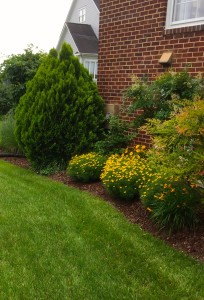
As spring turned to summer the garden changes to various hues of yellow. Here the correopsis, yarrow and the Stella D’Oro lily bursting out onto the scene, with a backdrop of Nandinas (which discreetly hide the A/C units) that have color in the foliage and wonderful little white flowers. I love how long all of these stay in bloom, usually about a month and a half!
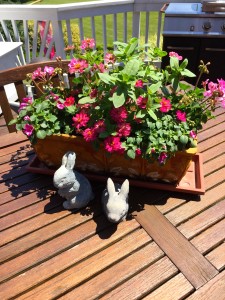
This year on the deck I created some different styles in the pots and planters. These have a mix of flowers that are all in the same magenta color family- Zinnias, geranium, impatiens and vinca. They are really filling out now. If they seem to be getting too much sun exposure, it’s good to rotate them around each week to keep them healthy.

I have put my herbs into pots this year, they are closer to the BBQ and kitchen, which is very handy. I love all the green, and of course the great scent. I find that a half day’s sun is the perfect amount!
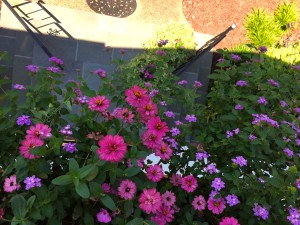
Last, but not least is the window box over the front porch. Similar to the deck planters, I used a mix of flowers. All the same varieties as the others, but with the addition of some beautiful purplish/pink lantana to drape out over the front of the windowbox. It’s a more simple, sort of cottage look, but maybe even more full and very summery looking!
Well, that’s my 2017 Flower Show — hope you enjoyed it! Please let me know what your favorite flowers are this year from your garden. Happy summer!
Springtime Garden Reveal 2017
Hi all! I think I am finally ready to show you some of the garden areas I have been working on since last fall. My goal was to open up the areas that had gotten a bit too crowded and simplify the overall design. While we walk through the yard, I’d like to show some tricks and tips that might help solve similar dilemmas that many of us deal with.

Closeup on the front corner of my yard. A row of juniper does double duty shielding the windows from headlights of vehicles rounding the corner, as well as defining the edge of the property.
I have never shown a closeup of this garden area on the blog before. It is the front corner of my front yard, where the cul-du-sac meets the street. Here on the corner a low wall of juniper bushes are very strategically placed. As cars round the corner at night into the cul-du-sac, this blocks the headlights, shielding the windows from the bright headlights. All you need is 3 or 4 foot high evergreen bushes in order to protect the house from an oncoming vehicle’s headlights. No one wants to feel like a search light is spraying the inside of your home, and this does the trick! This garden is layered with euonymous and liriope on the street side, and anchored in at the corner with a dogwood tree. We have an up-light that shines at night into the canopy of tree, which right now looks like a cloud of beautiful white blossoms.

Front walk has been opened up by removal of some larger bushes and layering in lower plant material in foreground.
Here is the updated front walk. I cleared out some of the jungle of large plants on either side of the Nellie Stevens holly and highlighted it by relocating the hostas to either side in a semi circle to add some visual depth and light to that side of the walk. The liriope on the lawn side of the walk were all divided and will stay low. They will add some seasonal interest in the late summer with their purple flowers. These carry through the front of the other two garden beds on either side of the front door to create a nice flow from one garden to the next.
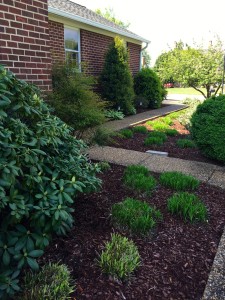
Here’s the walkway from the front stoop. The zig zag is not the best layout. I smoothed out the visual flow by running the liriope through all three of the front garden beds.
I inherited the layout of the walkway, but if I were to design it myself, I would have brought this odd zig zag section forward to match up with the rest of the walkway and made the whole walkway 4 to 5 feet wide. It’s always nice to be able to walk side by side with someone on a front walk, and being on the north side of the house, it would have been smarter to bring the walk out of the shadow of the house. If I ever win the lottery this is one of the things on my wish list – LOL!

Rounding the corner the azalea is in full bloom right now, underplanted with a sea ofperiwinkle to move your eye around to what’s next in the side garden.

This side of the east garden was opened up a bit removing some of the iris and lamb’s ears and extending a few new waves of color into the existing design. In a couple of weeks this will be teaming in color.
Moving around to the east side of the garden I have done a lot of work. There were many of the older perennials that needed dividing, and some areas requiring removal, like the lamb’s ears which never was happy in that location and the beautiful iris which were overwhelming their area. All is smoothed out, and in a few weeks this area will be teaming with color. I have simplified many of the waves of color on this side, and interspersed some of them with liriope and periwinkle which will provide more year round interest. I also want to suggest to those looking to brighten up an area that placing lighter colors or variegated plants in the dark recesses under trees will draw your eye in and create more dimension. Repeating the plant material, colors and varying the numbers of plants in a group is also helpful to pull your eye through.
One more thing worth mentioning in this region of the country and other drought-prone areas: limit the amount of lawn that is in your yard. For example, in my yard the side and back are fairly hilly, so the lawn is kept to a minimum through there, and treated more like a wide pathway flowing through the yard and the garden beds are much wider. In the front, the yard is flat, so we have kept a larger patch of lawn for activities– perfect for throwing a Frisbee, or a game of croquet. This limits the amount of water, nutrients needed, and even helps with the amount of time you need to spend mowing — bonus!
Moving around into the back garden, I’m really happy to see that all the roses I transplanted are really flourishing in the full sun. This is where I have amped up the flower power, and have sedum, orchids, astilbe, hellebores, ginger, lamb’s ears, yarrow, iris, peonies, lily of the valley and hummingbird vine. Many of these were started from gifts from my gardening friends! The idea was to have something blooming for as much of the year as possible. The only time there is a void is February, and don’t worry, I’m on it. I think I’ll add some crocus bulbs in the fall to make it year round. Will I ever be done? No, but that’s the fun for me!
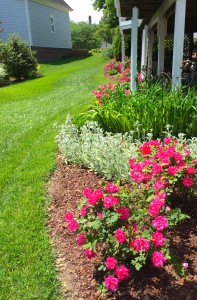
A long view of the newly revamped back yard border. It now has flowers blooming almost all year. It is half in full sun, and half in shade under the deck, so I’m able to have a wide variety of plant material.

Don’t forget — April showers bring May flowers! Here’s a rainbow from our last April shower – bring on the May flowers! Happy gardening!
Happy Earth Day!
A moment in time – waiting for the cherry tree to bloom!
Every year I’m working against the clock to have the yard looking at its peak when the cherry tree blooms. This year we have had an inordinate number of warm days, and I have almost finished — well, at least the front yard. It’s hard work, but the weeding, edging, mulching (90 bags!) and lots and lots of pruning are almost completed. We have lots of people who drive by and a few who take Easter pictures here when the tree blooms coincide with Bunny Day. I think this year I was lucky that this tree is a little behind the Tidal Basin cherry trees in D.C. The cold snap and late ice and snow storm that collided with them didn’t harm mine, just delayed it a few days. For those who are as in love with these trees as I am, this is a Kwansan variety. Its double flowers are magical!
The “Charleston pink” phlox that surrounds the tree is at its peak right now, and the tree is hours away from exploding with color, so this is just a teaser and I will post another photo when the tree is blooming — until then, Happy Spring!
Update, April 6th – The tree has started to open. I’ll post a photo each day until it’s fully open. We had an incredible Spring storm that blasted through here just now with intense wind and the darkest clouds I’ve ever seen. Everyone in its path — stay safe!
Update, April 7th – She is now in all her glory! It’s always worth the wait. I feel so happy to have her in my garden.
A Field Trip to Washington’s Gardens at Mount Vernon
Each year on George Washington’s Birthday, the Mount Vernon Estate opens its gates to the public for free. As you might imagine, it is filled with people coming to celebrate the day. Since it’s right down the street from my home, I try to go every year. There is always something that is undergoing a renovation, and it’s great to see what’s newly been uncovered with all the advancements in technology they have. The mansion house has now been painted with colors that have been discovered to be the original — very different from the colors we all thought for years to be accurate. For at least the last century, it has been painted white and it’s bright red roof shown against the blue sky. Now the colors are much softer and more muted. A golden tan is on the field of the house, and the roof is a much softer red. It’s very pretty, but for those of us who see it everyday, quite a change!
The “back yard” of the house it is still just as it was when President Washington lived there. Believe it or not, the view from the veranda has been protected in a way that you cannot see any other structures across the Potomac River — 80 square miles of protection to be exact! I think that’s an amazing accomplishment. All the lawn that you see is trimmed by a scythe, no mowers used here. It’s quite impressive to watch. The estate’s team of gardeners have a wealth of knowledge about the colonial era tools, and there are special tours where they will demonstrate many of them. If you get a chance to visit, you might want to call ahead and request a special tour!
This year I went specifically to see the orangery and it’s surrounding garden. This area was used in housing the small citrus trees that they grew in planters. The trees would be outside in the warm months and moved indoors into the orangery in the winter. It has a dark colored slate floor, and masonry walls which would soak up all the warmth from the sun during the day through the south facing, floor to ceiling windows. Then in the evening, the shutters would be closed, and the floor would radiate it’s heat back into the room, keeping it above freezing, and all it’s tender trees and plants would be kept alive. They have not quite finished this renovation and the plants are not inside yet, but soon it will be full of tender plants.

Enjoying a warm and beautiful walk in the brick walled garden. A cherry tree espallied against the wall is almost ready to spring back into growing from the extra warmth of the wall.
On the outside of the building there is a large garden surrounded by brick walls to protect against nibbling deer and other animals. This area was mainly used to start new plants for transplant into the other landscaped areas and was used as sort of a colonial era plant nursery. President Washington was the recipient of many gifts of plants and new varieties of seeds and, according to his journals, enjoyed experimenting with them.
The walls of the garden have many different varieties of espallied trees — mostly fruiting trees like apple, peach, fig and cherry. They were grown against the walls for extra warmth to prolong the growing season, and also pruned to just a few feet tall, to make harvesting the fruit easy. The colonial people were very clever in their farming practices!
Along the brick lined paths they additionally would grow herbs and medicinal plants. A very diverse variety of plants grew there. The tiny little boxwood plants that you see edging the walk, figs trees, herbs and many other plants and seeds are sold in the annual plant sale fundraiser, coming up in Garden Week, another really fun event!
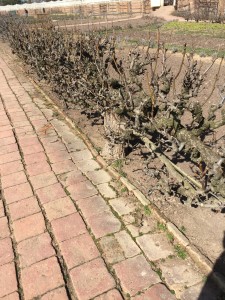
Here is a close up on the apple trees in the larger vegetable garden. February and early March are when they are pruned to keep them low, and easy to harvest.
There is a huge vegetable garden on the other side of the mansion as well. With hundreds of mouths to feed, this was a most important garden, and it was in constant rotation of crops. Lettuces, cabbage, carrots, potatoes, melon and many more things grew here. This season the early spring onions and cabbages were looking great.
I always hate to leave Mt. Vernon estate, but the afternoon was coming to an end. So until I am back there next year, Happy Birthday George Washington! And happy gardening to the rest of us-
Making the Most of the Weirdest Weather Ever
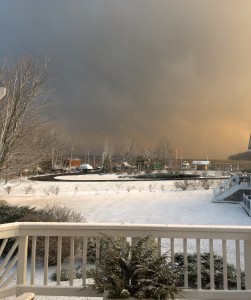
Wild weather going from 70’s to 20’s with thunder, snow and hail, then back to sun- breaking records almost every day.
We are having some truly crazy weather here in Mount Vernon. Over the last week, we have had a daily high of 74 degrees and a daily high 38 degrees; snow, hail, sun, and rain; and three or four days with 60+ mile an hour winds! It seems like we are having records broken every day. You never know what will be in store from one minute to the next.
I’ve been making the most of the nice days and getting lots done in the garden. There have been some interesting things — and some not so — but it’s been great to just be outside soaking it all in. Here are a few things that I’m doing here that I hope will be a useful reminder to you in your gardens.
When we’ve had a nice afternoon here and there, I managed to get at least one or two ornamental grasses trimmed down. With more than a dozen out in the garden, this is the most time consuming of all of the cutting-back tasks. Mature grasses always start to die back in the middle after a few years, and it can start to look like a doughnut with all the growth around the edge and bare in the center. I have a tip for working with these: If you have a saws-all you can use a long blade to cut around the inner circle and remove it. This will dull the blade, but just keep it for this duty — makes it so much easier to cut out the fibrous, tough center. The bare center then can be then easily be filled in with a chunk of fresh, new growth from the outer edge, making the plant good as new.
These grasses can grow to be more than three feet in diameter in just a few years, so an alternative would be to divide it in fourths (or more) and turn one plant into many. Gardener’s gold! I have seven of them trimmed down now, so I’m well on my way. And — once you have finished trimming down the tops, don’t forget to clean out the old leaves and debris that settle in to the center during the course of the previous year. It will make the crown of the plant much healthier, and as a bonus it will look much nicer, too.
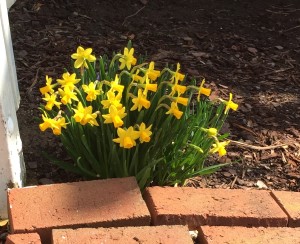
First spring flowers are already blooming! Time to scratch up the mulch and enjoy the fresh Earth scent!
Now that we are starting to have warmer days, I like to stir up the mulch. It can become so compacted over the winter when it freezes and thaws. By stirring it up, it is much more porous so the spring rains can more easily soak in. It also makes the mulch look fresh and nice.
This is also the perfect time to check on emerging bulbs and perennials. I like to take the time to clear out the branches and leaves that have blown in, and give the garden beds a good edge for the upcoming growing season. Another tip — use your senses to evaluate your soil. It should have a beautiful fresh earth scent, as you stir it up. If it doesn’t, remember where and return with some nice compost to stir in when the soil has warmed. Ditto that if you see an area where rain ponds up, or there is moss or heavy clay.
Right now is the perfect time of the year to trim up rose bushes. Leave five or so main branches, and cut out any that cross. Make your cut about 12-18″ up the branch just above an outward facing leaf bud.
Last year I heard a new tip and really like it: sprinkle cinnamon on the soil surrounding the rosebush about a foot in diameter. It keeps fungus at bay. It really works. I had no black spot at all on the leaves of the bushes where I did this.
On to a reminder about some of the ugly necessities in the garden. After 17 years, we are replacing the A/C system. I wish they lasted longer, but even though we have ours serviced every year, there are only so many years of life in them. Here’s a tip I’ve mentioned before, but bears repeating: make sure to trim any bushes or hedging back so that the unit has at least a couple of feet of breathing room around it. You will have perfect air circulation around the unit and the technicians will have room to service it. Thank goodness for that invention, makes life so much more enjoyable!
I also made some progress clearing out a space to dedicate for storing my recycling bins and trashcan. It’s a little more visible than I’d like, so I’m still thinking about what I might do differently to improve on it.

On an exceptional day last week, we took a field trip to Mt. Vernon Estate, just down the street. More on that next time!
In between some more wild weather, we had a beautiful day to take a field trip to George Washington’s home, Mt. Vernon. I’ll be writing the next blog on some really inventive gardening tips from there that are still valid today!
I hope you’ve been able to get out in the garden on your good days, and may we have many more to come. Enjoy!
Kicking Out the Winter Blaaahs

A simple bundle of amaryllis flowers in a round cylinder vase adds a great pop of color on the hearth. They are tall, so I like using them against a wall in an unexpected place.
I always feel like my house looks so bare after I take down the Christmas decorations. The outside, too, seems so bleak and beige. It gives me a case of the blaahs. Here are a few simple things I’m doing to counteract those winter doldrums at my home.
I like to have colorful flowers to give some warmth to the home. For me, that means using tropical flowers and colors. I love the way tropical flowers work with so many furniture styles, too. From modern contemporary, to coastal, to traditional, they look wonderful.
I’m a practical lady and, as you know, and I like to grow a lot of the plants I use for decorating. But tropical flowers don’t grow around here unless you have a greenhouse, so my choices are purchasing them from a floral supply shop (very expensive!), or using silk replicas. Well, you know what this budget-minded lady is going to use! There are some amazingly realistic silks available now, too.

On this tabletop I have a single heliconia flower. Such vibrant colors make me feel warm. I filled the base with crabapples for some extra color.
With many tropical flowers, you get wonderful impact with one or just a few flowers, especially with the larger flowers. The key is color — the more saturated the better, in my opinion. Luckily, readily-available square and round cylinder vases are great with almost everyone’s personal style.
Here are a couple of my favorite ways to display arrangements made for console tables or floor arrangements. These are tall so they are better positioned near a wall rather than as a centerpiece, which you would want to be low enough you could see across the table for conversation.

In the entry hall I have a vase of bird of paradise flowers. I added a branch from the curly willow tree to give the arrangement some motion.
It’s also nice to have small “minis” that you can scatter around on side tables, or on a tray with other things, or even in multiples down a mantle or dining table. I’d suggest trying orchids or succulent plants that require very little care, great for busy lifestyles or those who travel.
Here’s a fun tip to give some extra zip to your floral creation: take advantage of the base of the clear vases by using interesting things to dress them up. Some favorite fillers are shells, beach glass, stones, wine corks, small fruit, moss or lining the vase with leaves.
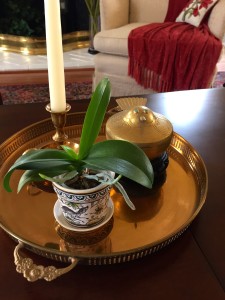
I like to balance out the room with some small mini potted plants, these tiny orchids can live for years with very little care.
When I was last at my wholesaler with a friend, we discovered that there is now a 4″ wide ribbon that is made exactly for this, and looks like a variegated leaf — pretty clever! We picked some up for her daughter’s upcoming wedding.

Don’t forget your bookcases! Just a small pot of leaves or ivy can breathe some interest into an otherwise stale spot.
Another tip when using silk flowers in a clear vase is to add a couple of inches of water. This might seem funny to some, but it seals the deal, makes faux flowers seem real! And one more tip when using faux: make sure to keep them dusted.
Outside, I love to have a few pots of pansies for color, and I add branches of boxwood or juniper for some background. I also do the same with bare branches from the curly willow for some interest and height.
Well, these are a few of my favorite ways to combat the blaahs. Hope you find them interesting, and please share with me what you do in your home!
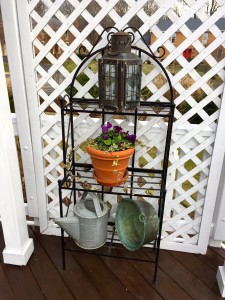
I like to have some flowerpots to look at out on the deck from where I sit at the kitchen table. Makes me feel like spring can’t be too far off. Hmmm…. Nice thought!
My Gardening Goals and Dreams for 2017
Hi there! It’s been a hard few months for me, trying to not worry too much about the future, but I’m doing my best to re-focus on what I can do. I urge all to stay aware of clean gardening practices and what we can do for the environment: not using chemicals, recycling/composting, participating in clean-up efforts in our communities, and last but not least, sending your Senators and Representatives a call or an email asking them to keep as many environmental protections in place as they can. You can reach them all at (202) 224-3121. The Capitol operators can help you find your Senators or Representatives, even if you don’t know their names.
We have a lot of work ahead of us! I don’t mean to rant on, but really, who doesn’t want a clean and healthy world? I think we can all agree on that! I think that is my biggest dream. I hope we can curb our losses at the EPA. Climate change is real!
Here in my little corner of the world, I managed to get quite a lot finished up in 2016, but I still have so much to do. This year’s main focus is on improving the areas under and around the deck.
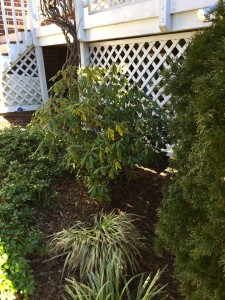
It was time for an edit in this garden. With more shade from a tree, it was out with the sedum and in with a transplanted rhododedron.
Here are my goals: I’ll make an designated area to place the trash can and recycling bins that is both out of sight, but still easy to roll out to the curb. This also will improve the area where I store my flower pots, extra hoses, etc. And, there is one area I couldn’t work on last fall because I ran out of time — I need to lift some of the bricks on the back walkway and level them. After sixteen years, the ground has sunk around the plexi pipe that carries the runoff water from the downspout — should be an easy fix! Third, I will use my brick saw to cleanup the edge of the walkway where it connects to the driveway.
All the cosmetic work will boost the curb appeal, too — always a plus. When spring arrives, the garden around the base of the deck will get some annuals to really fill out the space and give some added color. Looking at the winter garden, when most everything is bare or died back to the ground for the season, things look bleak, so I will post a picture when everything has sprung back to beautiful life and show some before and after shots in a few months.
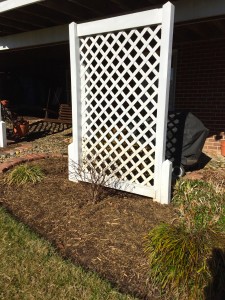
Here’s a photo of my re-make of the old planters into privacy screens. I removed the rotted supports and replaced them with posts I had saved. These are buried 3 feet into the ground, with no cement, so they can be re-positioned later if I want. I’ll be sure to post again when everything is in leaf and bloom, but while the bushes are bare you can see the screen more clearly.
When I manage to finish all of that, the upper trim around the house and gutter system needs a complete cleaning and painting. Lots of the basics — weeding, mulching, trimming, mowing and edging — go on pretty much year round. Here’s a winter tip to make quick work of a messy, windswept yard: We find that it is much easier to run the mower over the grassy areas every month or so even in winter to pick up the leaves that blow in and smooth out the clumps of grass than it is to rake the whole yard over and over.

Here is another area that I edited. It had become crowded and one of the bushes had died. I balanced out the azalea bushes on either side of the Holly tree and divided and replanted the hosta in a wave. An edit every few years it helps to keep things fresh.
Last fall I did manage to finish re-making the planters and arbors and reinstall them. Using the leftover lumber from other jobs that I had stored in the garage, I added extra posts so that the planters could be used as privacy panels (hiding the less-than-pretty necessities that are stored under the deck). Then I planted the rose bushes, which had been in pots before, and divided and replanted the liriope to fill out the garden. Also, five other areas of the garden were edited and simplified. Plants had grown so out of bounds over the years, and it was time to selectively remove and transplant many to new locations. Now there is some breathing room, with nothing crowded. I added another three cubic yards of mulch to spruce up the beds, and then the cold weather set in.

This fun garden ornament that I was gifted has so much personality. It spins and bobs in the wind! I would love to incorporate a few more interesting things throughout the gardens like this.
On the creative side of things, I’m looking forward to making some stepping stones to access some of the deeper garden beds more easily.
Lastly, I received a really fun garden ornament from my sister, and it adds so much personality to the garden. Thank you, Tracy! It makes me want to incorporate a few more special things to spice things up! More on that later…
What are your goals for 2017 out in the garden? I’d love to hear!
Happy New Year to All-
Happy Thanksgiving to One and All-
A Long Goodbye to Summer Heat
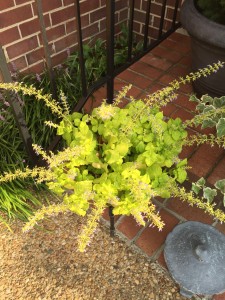
This pretty lemon/lime coleus has done well in the summer heat — watering it at least once a day has been the key! It attracts butterflies and hummingbirds, too!
Here in the mid-Atlantic, this has been a really rough summer, and the climate change has been very pronounced. Officially, it is the second hottest summer on record. With well over 50 days of temps in the mid-90’s and higher, the plants and trees are struggling — so much so that I am rethinking the location of many different plants in my garden. The micro-climate in my yard is hotter than the officially recorded temps by usually around five degrees. I think that is mostly due to the fact that we don’t have many shade trees on the property.
It’s a good time to take inventory of how the plants are faring. I think it’s interesting to compare how the same variety of plants do on various sides of the house, getting sun at different times of the day.
I am concerned about a row of euonymous that I planted along the front walk. Each spring, they start off looking amazing and full but lose their leaves by the end of summer, leaving them looking like bare stalks — not pretty. Those will be removed, and in their place I will add more liriope, and just fill the walkway garden with it, since it has done exceptionally well in that exposure.
The other hits in the front garden are the Hyacinth bean vine that I started from seed from last year’s winner, and also this gorgeous lemon/lime coleus with purple flower stalks. Both of these have been attracting butterflies and hummingbirds!
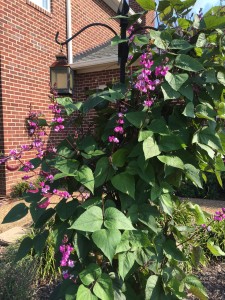
The purple flowering hyacinth vine started from last year’s seeds has also come into its prime in this heat.
On the other side of the house in the east garden, I have a huge amount of beautiful white iris that are struggling in the intense amount of afternoon sun, as well as lamb’s ears that are always looking bedraggled. They will both be removed as well. The garden on that side is now getting established, and the crepe myrtle trees have grown to a point that they are blocking an unappealing view, so I couldn’t be happier about that! I might not even install anything else in that garden, and leave them some extra space. Deep watering has kept them in good health, so just adding some extra mulch is all that is needed.
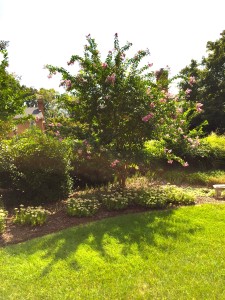
The underplanted iris and lamb’s ears will be removed to give the crepe myrtles more space. They are exceptional trees for hot climate and have grown quite a lot this season.
In the back yard, I have some renovating to do. After 20 plus years, and even a move from our old house to this one, the planters we built from pressure treated wood are on borrowed time. I am rethinking how we might rework a privacy screen for under the deck, and then add to the flowering bounty underneath. The knockout roses and beautiful peonies that I currently have in pots, as well as some of the white iris I am removing from the east garden will be planted there. I’ll increase the garden’s size to accommodate them as needed. They’re my “green children” after all!
I have a couple of beautiful photos to share of the Labor Day weekend’s sunset here, and a last photo of this summer’s front door — next time you see it, it will be decked out for autumn, and hopefully a lot cooler! Until then — Happy gardening!
The Best Summer Plants of 2016
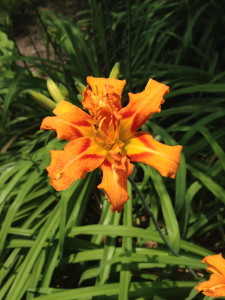
Number 1 on the list are the daylilies- this variety is a double flowering beauty. I can always count on them for at least a month’s worth of show.
The outside chores are done, and now it’s time for a nice cold iced tea. I’m going through photos from this summer’s garden and want to share some of the plants and flowers that are thriving in my garden in this heat wave. These are my picks for this season’s best here — please let me know what your favorites have been in your corner of the world!
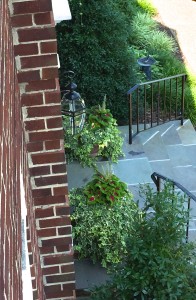
I took this front porch photo while I was up on a ladder brooming down spiderwebs (which are way too plentiful this summer!). I love looking at the garden from a bird’s eye view. The ivy in the flower pots has gotten huge and looks great year round. I just change the center flowers each season.

These are the caladium plants that I rescued from the rains. They have come back nicely, and are very happy in the protected window box under the deck.
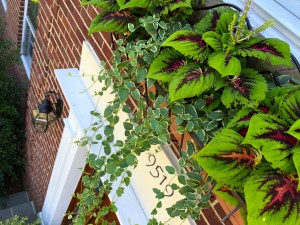
These “King Kong” coleus in the window box above the door are my favorites of the summer — very tropical!
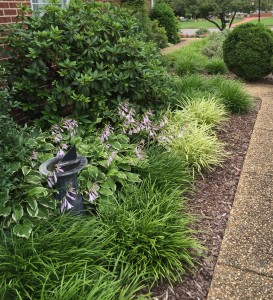
The liriope have become great border plants along the front walk. Every three years I can divide each one into 4 to 6 new plants. In the late summer, they will have purple blooms.

My little friend loves these boxwood — He’s happy anywhere in the shade! Boxwood have always been a wonderful walkway plant here in Mount Vernon dating back to the days of George Washington.
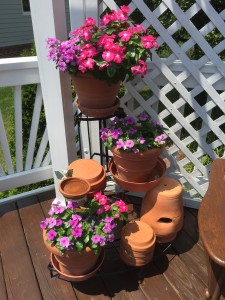
Up on the deck, I am loving all the color from these vinca in pots. I also have these planted by the driveway. They love the sun and heat much more than I do!

And last but not least, the curly willow trees that are planted in three corners of the property. I always feel cooler watching their branches dance in the breeze.
Mid-Summer Check-In
It’s summer, all right! With temperatures approaching 100° here, there is no more comfortable place to be than in my basement at the computer, blogging without feeling guilty that I should be out working the garden. We have just passed the 4th of July, and now we move on to the “3H” time of summer: Hazy, Hot and Humid. No matter how long you live in the D.C. area, you never really get used to it. Water of all kinds is your friend — whether it’s the beach, pool, sprinkler or hose! And, please make sure to drink your eight glasses a day; it’s not fun to get dehydrated.
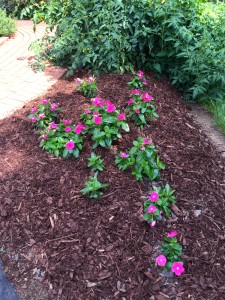
When it gets this hot, it helps to keep the weeds down and moisture in by stirring up and adding some additional mulch in thin spots. Your flowers and veggies will love it, and also boosts the curb appeal!
With the exception of a couple of weeks in early June, this has been a very rainy season for us, and that has caused not only extreme growth on established bushes and trees, but also annuals and vegetables to rot because of heat and moisture. I had to replace all of mine, but they are looking fantastic now.

I have coleus in the planters this year. I love the bright splash of color, and they are very hardy in the heat-
After losing the first set of annuals at the front door due to too much rain, I put in coleus. Sometimes I see plants in the nursery that seem to be doing so much better than others, so that’s what I bought. I love the huge colorful leaves! I have more of it growing on the back deck and in the window box — love it there, too.
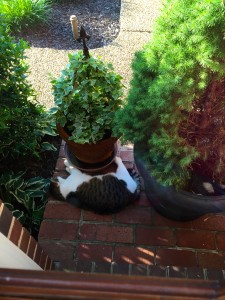
Stomper would like me to request that everyone set out some water in the shade for four-pawed friends — it’s greatly appreciated!
I want to put out a reminder in this heat to please keep your bird baths filled with fresh water and a dish or two of water ideally in a shady spot for the wildlife. It’s sometimes hard to find clean water this time of the year for them, and it’s much appreciated!
I find myself just trying to keep up with the weeds when it gets hot like this even though I use a weed preventer in the garden beds. I’ve been adding some extra mulch here and there where it’s become thin and stirred it with a rake in other spots for good airflow to soil. This is a good practice to get into this time of year, and it boosts the curb appeal, too!
And while I was edging the other day, I found this wonderful heart shaped rock, nature’s gift!

I have a new lawn mystery to solve. Brown spots! I think these have been caused by lawn grubs. More on this soon.
I’m noticing about 100 brown spots in the grassy areas. They can be caused by so many things: fungus from too much rain, or a dull mower blade, pet spots or grubs like fire flies. I’m not sure what is causing mine, but I’m leaning towards the grubs idea. I’ll report more on this soon, and have a remedy for you, too, when I do.
Until then, try to stay cool — Happy Summer!
Some 911 for the Rain Soaked Garden
Soaking as a sponge doesn’t even come close to how damp the garden has been here in the mid-Atlantic region. With more than a month of rainy days and only a few sunny ones mixed in, some extreme measures are needed here. Almost half of the flowers that I planted ended up rotting from it all. On the other hand, it caused a lot of the established plants to grow a ton of wimpy new growth because they were growing so fast. So here’s my 911 to help manage this crazy season’s issues.
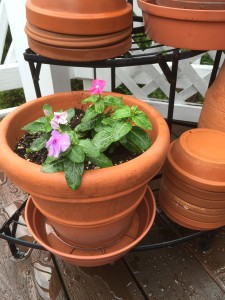
Remove the drain saucers from your flower pots when heavy rain is expected so that the pots do not become waterlogged.
First, if you have heavy rain in the forecast and have flower pots or planters go ahead and remove the drain dishes so that the rain will drain through and not become soggy. This is also a good idea in general, with so many mosquito-borne diseases this year. If the flower pots are not too heavy and you have some overhead coverage, like a porch or under a deck, carry the pots underneath before the rain so that the blooms do not get damaged or rot. I did this with my roses, and was very glad I did. Open blooms will be destroyed by the heavy rains. If this happens, deadhead the plants as soon as possible.
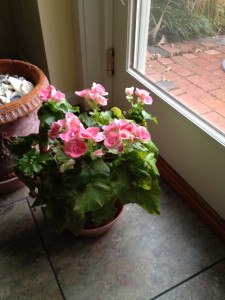
If possible protect the open blooms from the rain, by putting them undercover. If they do become damaged by the rain, deadhead them ASAP.
If your grass is thoroughly soaked, try to stay off of it until it dries. When it’s walked on with standing water, it crushes the soil, compacting it which can then lead to other problems and weeds down the road. Clover is really difficult to get rid of and seems to love compacted soil, as do dandelions, and many of the weeds that we try so hard to keep away.

If you have standing water in your lawn, like mine, try to not walk on it or mow it until it has had time to dry out.
It’s also not a good idea to mow when the lawn is wet. That rips the blades of grass, instead of cutting them, so you will get brown tips to your lawn- not a good look! Beware of using the mulching option on your mower when there has been this much rain, it is better to collect and compost the clippings until the soil has had some time to dry out. Mulching the lawn clippings right now can cause fungus and mold issues.

I like to keep an extra package of garden stakes on hand. The new growth has grown way too fast, and much of it can use some extra support.
Where extremely fast growth has occurred on plants you may need to either stake the plants to give them some extra time to strengthen, or trim them up some. This is the time of year when azalea and rhododendron bushes should be trimmed anyway, now that they are done blooming. And with all this rain that we’ve had, a granular slow release fertilizer can be helpful. Keep an eye out for wilting, and trim it out, ASAP. That will hopefully halt any further disease.
One last thing: if you do see wilting and fungus that need to be trimmed out, please have a small container of rubbing alcohol that you can dip the blades of your trimmer into between cuts, so you won’t spread infection from plant to plant.
I hope that you won’t have much damage in your garden, like I did, but it can’t help to know some plant CPR just in case! Happy gardening!
A Bright Spot on a Rainy Day
Hi, everyone! I’m about ready to start building an ark. We have smashed through a century-old record for the most rainy days in a row. The previous record was 13 days, and we are now in our 16th day of rain! The street lights are staying on all day, because it’s so drab and dark. I, for one, need some springtime cheer, so I thought I’d post some bright spots from the garden on this rainy day…
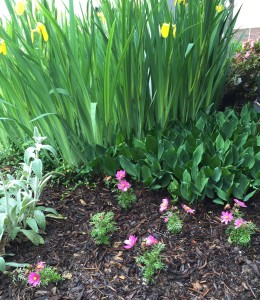
Some beautiful cosmos started from seeds a friend gave me. P.S.: This is the perfect time to sow seeds outdoors, now that the risk of frost is over.
Well, that does it for today, a new downpour has started up! The upshot is no watering will be needed around here for a looooong time. Rain, rain, go away! I know later on in the year I’ll want some more, but for now I’d like some sunshine, please!
A Very Busy Second Half of Spring
Here it is — the second half of spring already! The garden here is bursting with activity, both flora and fauna. We recently spent a leisurely morning with our fox friend, our feral kitty, the crazy squirrel, duck family, chipmunks and many songbirds to name a few. It’s always an adventure around here!
With the nice weather warming the soil, the garden is growing quickly now, despite the fluke ice storm that deposited an inch of slushy ice two weekends ago. The trees are blooming all out of sync again. Strangely enough, the dogwood was the first to bloom and has held on to her flowers for almost a month.

This fluke ice/slush storm was winter’s last hurrah. Most plants had started to get their new spring leaves, so this storm was most unwelcome.
We have finally turned the corner on frost and freeze warnings, so I’ve been planting herbs and veggies. It makes me so happy to see how many heirloom varieties are now being offered in the garden centers! I’m trying out many old fashioned varieties this year, so I will have some fun things to report back on.
I’m so glad that the trees came through the winter alright in this region. We had such a strange autumn that many of the National Cherry Blossom trees bloomed around Christmas, about 1/4 of them! The affected trees didn’t rebloom, but thankfully they are all okay.
The same happened with many of the bulb flowers. The hyacinths that I have in my garden had sprouted at Christmastime, so they became freezer burned by the cold of winter and their flowers were all deformed this time around. Thankfully the daffodils had not gotten as big and were fine. On a better note, the patch of lily of the valley is looking the best that it ever has, and I’m so glad to report that it is covered in fabulously scented flowers. This is a fantastic ground cover with tons of old fashioned appeal, and will grow nearly anywhere, so keep that in mind if you are looking for something to fill a tough spot.
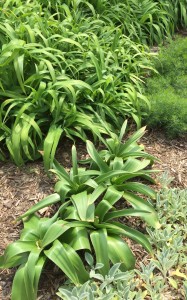
Not in bloom yet, but this area is planted with large masses of flowers. I can’t wait to see the allium in bloom!
The allium bulbs are getting so huge as well. They were a gift at Christmas, so this is their first year. I will post some pictures when they start to bloom. I love how interesting the flowers are, and I planted them in a wave, between masses of iris, daylily, lamb’s ear and coreopsis. It’s getting so full that it should look amazing when they are all in bloom. While they are newly emerging, this is the perfect time to round up the edges on hosta, grasses, liriope, and lily to get them in shape for the new growing season. I like to do this now, rather than in autumn because they send out shoots underground over the winter months, and can start to look a bit messy otherwise.
On other fronts, I’m continuing to work on the storm window project, and I have a tip for you on fixing discolored brick. Years ago, way before we bought this house, someone had used some crummy paint on the trim work. It left long streaks of ugliness on the brick. I had tried all kinds of things to remove it short of sandblasting, and nothing could clean it off. My solution — more paint! I picked up half a dozen exterior craft paints in different brick colors and blended them. Just dab them into the offending areas and like magic the stained areas look fresh and clean. I have done this before on the front stairs and many other places on the house. If you didn’t know a stain was there, you never would. I won’t tell, if you won’t! Works like a charm. Give it a try!

AFTER: Looks like new! Blending a few different brick colors and dabbing it on the stained bricks works great, and it’s easy to do!
I hope you are having a wonderful springtime and getting time in the garden. Here is one last photo, a bird’s eye view picture from the upper window looking out on the neighborhood trees. I just love how many bloomed all at once again this year!
Spring Cleaning — Outside, Too!

The curly willow was the first tree in my garden to start its new growth. This year, it has doubled in size!
This has been a very strange spring so far, with weather not being able to make up its mind between winter, spring or summer. There have been some really turbulent wind storms as well. Even still, I’m doing my best to get the garden and house in tip-top shape. There are many projects underway and inspections taking place. I will walk you through a few of the big ones that you might find helpful in relation to your own home and garden.
While I’ve been getting the perennials and bushes trimmed up and ready for new growth, the cleaning outside has started from the top down.

Here’s the before picture of our roof taken at the end of summer. You can see the black streaks appearing.
It’s been five years since we had our roof cleaned, and it had developed black streaks from algae and air pollution again. Last time only the north-facing front was grungy, but this time there were streaks on all four sides. The method of cleaning has improved greatly since the last time. Now the technicians spray the roof with a special soaking nozzle using a detergent that makes quick work of cleaning the shingles. This is far better because it does not damage or wear the roof like the machine scrubber of the past.
They also did an inspection and discovered 3 spots where squirrels had chewed up the shingles trying to get inside. We quickly had that fixed. I recommend that everyone have their roof inspected each year. The damage on ours wasn’t visible from below, so we would not have even known until water damage became visible inside. That would have been much more expensive to fix!
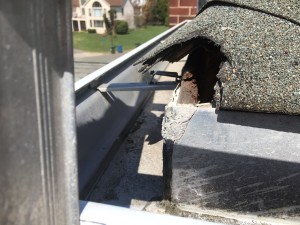
Here’s why I think everyone should get a roof inspection. This is where a squirrel chewed a hole right on the corner. You can’t see it from below, so we wouldn’t have known it was there.
Many roofing companies will inspect at no cost and take pictures to show you damage that they find. Many thanks to the A Team Roof Cleaners, and Marshall Roofing for the repairs.

BEFORE— The 30 year old storm windows. Back then you only had one option of where you could place the center bar, only in the middle of the window. That meant looking at it every time you looked outside – not pretty!
I am also back on track replacing ten of the storm windows on the main level of the house. I’m always a “bring the outside in” kind of girl, so having proper windows is important to me. The former storm windows didn’t match up with the style of window in the house, so instead of looking out of a pretty wooden window, we had been looking at an ugly metal bar in the middle of our view. The new windows are great, and even come with a new coating that helps them stay clean — YAY!!!! I love that feature.
Anyone who is considering window replacement look at this option first. The new storms provide great R-value, and in our case were 1/10th the cost of a window replacement.

Here are the nice new storm windows – with the center meeting bar where it should be. And bonus being a special coating to help keep the windows clean!
That’s a fantastic savings! We chose Larsen Gold Series Storm windows — I’m not a paid spokesperson, but I do believe in sharing my sources.
I also still need to scrub down the north steps in front of the house. I like using oxygen bleach and then rinsing it well. Makes the stones and the grout look like new. And this year, I’m determined to actually finish power washing the sidewalk. There’s always some touch up paint needed on the trim work. It all takes time, but in the end, it makes everything so much nicer.
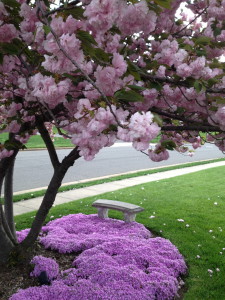 Those of us who live in the Washington, D.C. area are very happily watching our national cherry trees blooming, and that means mine are not far behind. So as I wait on my beautiful cherry tree to start opening up, I’m checking off things on my to-do list for this spring — hope that yours is on its way, too. Happy gardening!
Those of us who live in the Washington, D.C. area are very happily watching our national cherry trees blooming, and that means mine are not far behind. So as I wait on my beautiful cherry tree to start opening up, I’m checking off things on my to-do list for this spring — hope that yours is on its way, too. Happy gardening!
And Just Like That — SPRING!
Goodbye ice and snow! Spring is popping! We shattered high temperature records already, and went from heat to A/C in the house on the same day. The groundhog was right — it’s an early spring. I’m ready, or at least I’m try to keep up. This last week I managed to get a lot of grasses, sedum, liriope, iris, rose bushes and some of the straggly nandina trimmed up and ready for the new growth. I’m more than half done, but this year many of them are already showing signs of new growth. Normally that doesn’t happen until much later in March or April around here. Mother Nature has been confused, most definitely.

After just a couple of years, despite lots of maintenance, there was a huge amount of rot in the wisteria arbor. Time for replacing!
We also had some pretty awful rot in the arbors that we built only a few years ago. Before we installed them, I primed them, put on two coats of paint, and then annually gave them another coat of paint, but they completely failed anyway, full of rot — very discouraging! So this time around, we used PVC instead of wood, and there will be no chance of rot again. It looks great! We were rushing to get this project finished because this is one of the arbors that the wisteria is trained on, and we wanted to get it finished before it started to open up for spring. Just made it!
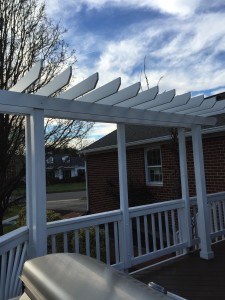
The new and improved arbor, this one made with PVC instead of wood — no more rotting! This one also has been made a little wider to give more sun protection below, and more room for the wisteria above.
This is really my favorite time to be outside in the garden. I love getting the plants ready for the season. Things grow so fast you can almost see it happening, and it feels so fresh after being couped up during the winter. The robins have been coming through en mass, and I have already seen nests being built, so I know I’m not the only one ready for spring! Here are some of the early blooms already making their debut in garden:
How to Fix Winter Storm Damage
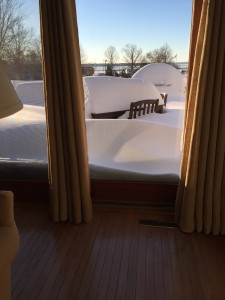
Opening the drapery and finding more than 30 inches of snow from winter storm Jonas. It was beautiful, but paralyzed the Washington region for a week!
We dodged a big one this week and are getting rain instead, but lately we have been using a four-letter word a little too much — SNOW! And a three-letter word, too — ICE!
Winter storms can really do some damage, and it didn’t surprise me that winter storm “Jonas” left some nasty damage in his wake a few weeks ago. I’ve got some ways to fix some of the worst damage, and ways to prevent damage in the future, as well as some interesting snow clearing tips for my readers. Hope you don’t have to use them anytime soon, but here they are just in case.
When you have really deep snow and drifts, it’s important to give first priority to clearing away the snow from your doors, and shovel a pathway out just in case you need to get out in an emergency.
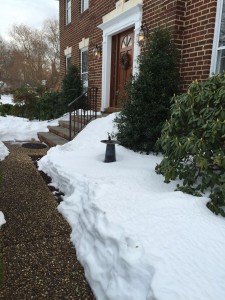
Spreading a plastic tarp on your porch and stairs before a snowstorm makes it easy to clear off. I cleared this in about one minute!
Here’s my favorite new tip that I just tried out on my front porch. It is so easy to do, and I bet it saved an hour of shoveling! Before a snow storm, just spread out a plastic tarp over your stairs and porch leaving a foot or two of extra length at your door. Weigh down the edges with bricks or large rocks to keep it from blowing away. When the storm is over, slowly lift the tarp from both sides. It is like teflon — the snow simply slides off leaving a clean and dry porch and stairs underneath. I wish I had known this trick years ago; what a time saver!
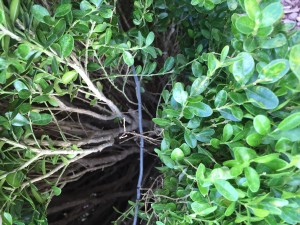
If you spiral (every 6 inches or so) a string or wire loosely from the base of a plant all the way up to the top, you can help the small branches from splitting open and breaking under the weight of the snow. Especially prone to splitting are boxwood and arborvitae.
I get lots of questions about snow pack on plants, and whether or not to remove it. In most cases my best advice is to leave it alone, and let it melt away naturally. Most plants have an amazing ability of springing back to normal all by themselves, but there are some tips I want to share which help them stay strong in the face of heavy snow pack. Starting from the base of a plant, loosely spiral some string or wire up through the branches to the top of the plant. I like to use this black plastic coated wire because it disappears into the branches, and is virtually invisible. This will help the plant to hold together and not split open under the weight of the snow. If you have extremely heavy wet snow you can very carefully lift it off with a spading fork or your hands. But, if the snow is frozen to the branches, it is best to leave it alone, it can easily tear the branches off.
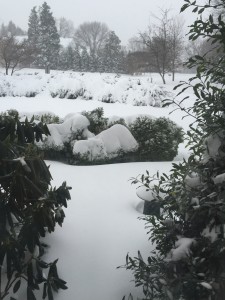
Here’s an example of how much spiraling a wire through the boxwood can help. The one on the right has it, and the one next to it doesn’t. Makes all the difference!
Be mindful not to toss heavy shovels full of snow onto your plants when you are clearing your walkways and drives. It can be so heavy that it crushes the plants under the weight of the snow. If you have any broken branches, cut them off as soon as you can safely do so. To leave the broken/torn branches attached could cause disease to set in. Try to remember which plants those were and give them a really good pruning in the early spring to prevent damage in future winters.

Deep snow is extremely heavy 7 to 20 pounds/sq. ft. Try to stand straight while shoveling, and lift with your legs.
We learned a lot from this deep snow, and can’t say this enough: work slowly, take lots of breaks, hydrate often, keep your back straight and lift with your legs. This is such heavy work, and it gives your heart a real workout! Be careful out there! And, as the groundhog predicted, spring will arrive soon… CAN’T WAIT!!!!
January 3rd – Is It Winter or Spring?
Well, it’s January 3rd and I’m already gardening! You know I can’t stay away from it for more than a few days.
We have had such a warm start to winter. Even when it has gotten cold overnight, the days are pleasant — so pleasant that here in the mid-Atlantic region, we have daffodils sprouting and cherry blossom trees flowering. Although it’s warm now, we will pay for it in February and March, according to the weather people. A classic El Niño with ice storms to come, so until then, I am getting as much done as I can and enjoying every minute in the garden!
I was a lucky gardener and received some fun gardening-oriented gifts for Christmas, too. A really nice gardening seat and tool tote, a pointsettia, a rosemary topiary and some beautiful allium bulbs. These were such thoughtful gifts! I spent this weekend planting the allium bulbs. Normally one would not do that this time of year, but because our temperatures have remained in the range you would expect an October day to be (between 50-70 degrees), I went ahead and got them planted. I just know they will be gorgeous this spring!
I also finished getting the roses ready for winter. They were still blooming until just this week! The last of the leaves dropped, so I scooped them all up. Its a good practice to always do that, as the leaves can harbor diseases which can cause black spot on the next year’s growth if left on the soil below the plant. Better safe than sorry, so I collect them. I had a little bit of it on my older roses this last summer and tried something new: a spray of half water/ half spoiled milk, and much to my surprise, it worked! I removed the affected leaves, sprayed, and within a couple of weeks new growth had sprouted showing no signs of the black spot. Remember this for next year in case you see any. I love it when there are simple home remedies that work! And have no harsh chemicals, either.
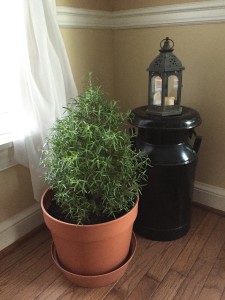
Rosemary is a fantastic plant to have inside over winter, the scent is wonderful, it cleans the air, and you can cook with it. How great is that!
Inside the house, I re-potted my rosemary topiary and lightly watered the pointsettia. They both really don’t need much water this time of year, and both like bright light. I have the perfect east facing window that I keep the pointsettia next to, and in previous years this has proven to be just the right exposure. It even kept color long into March. I love to have the rosemary in my kitchen, and can’t resist brushing by it to release the wonderful scent. I often use it in cooking, and it is just so pretty, too! These are also natural air fresheners.
Looking forward to seeing what kind of weather tomorrow brings, but I’m hoping to get back out there in the garden. Hope to see you!
A Quick Reminder Before The Freeze
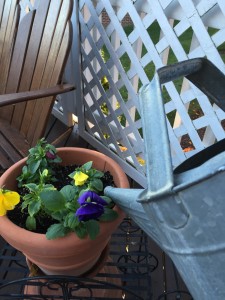
Back to an old school watering can for now. Time to shut off the outside water for the winter months.
What a beautiful day it was Friday! It is hard to believe that the weather is going to turn FREEZING in the next few days. Just a quick reminder to turn off your outside water spigots this weekend before the extended winter cold sets in. My Dad used to always call me and remind me to do this, so in his memory I want to send out this reminder.
Here’s how:
Turn the valve off from inside your home, remove the hose, then drain the remainder of the water out of the outside spigot. Remove and drain your watering wand or nozzle from the hose. Drain and coil your hose. This way if you want to use your hose in the winter it won’t be full of ice!

Outdoor shut-off valves are usually located inside the house opposite the spigot outside. Remember righty-tighty, lefty-loosey! While you are at it, if there is space behind the water pipe, slide in some insulation batting (or a section of newspaper or cardboard) to add an extra layer of barrier from the cold and help prevent frozen pipes.
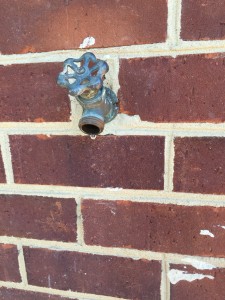
Once you’ve turned off the valve from the inside, open the outside spigot to drain the last drops of water.

